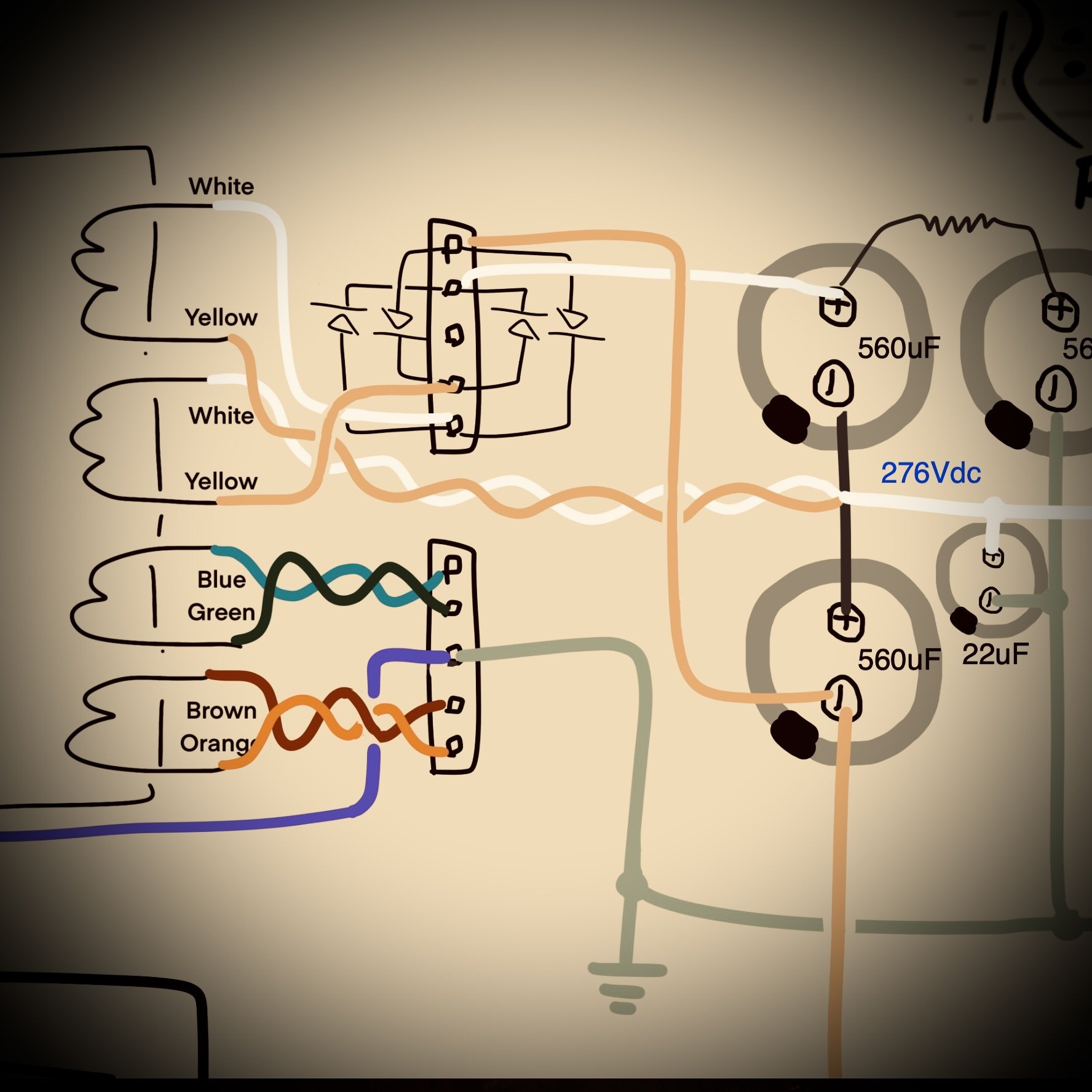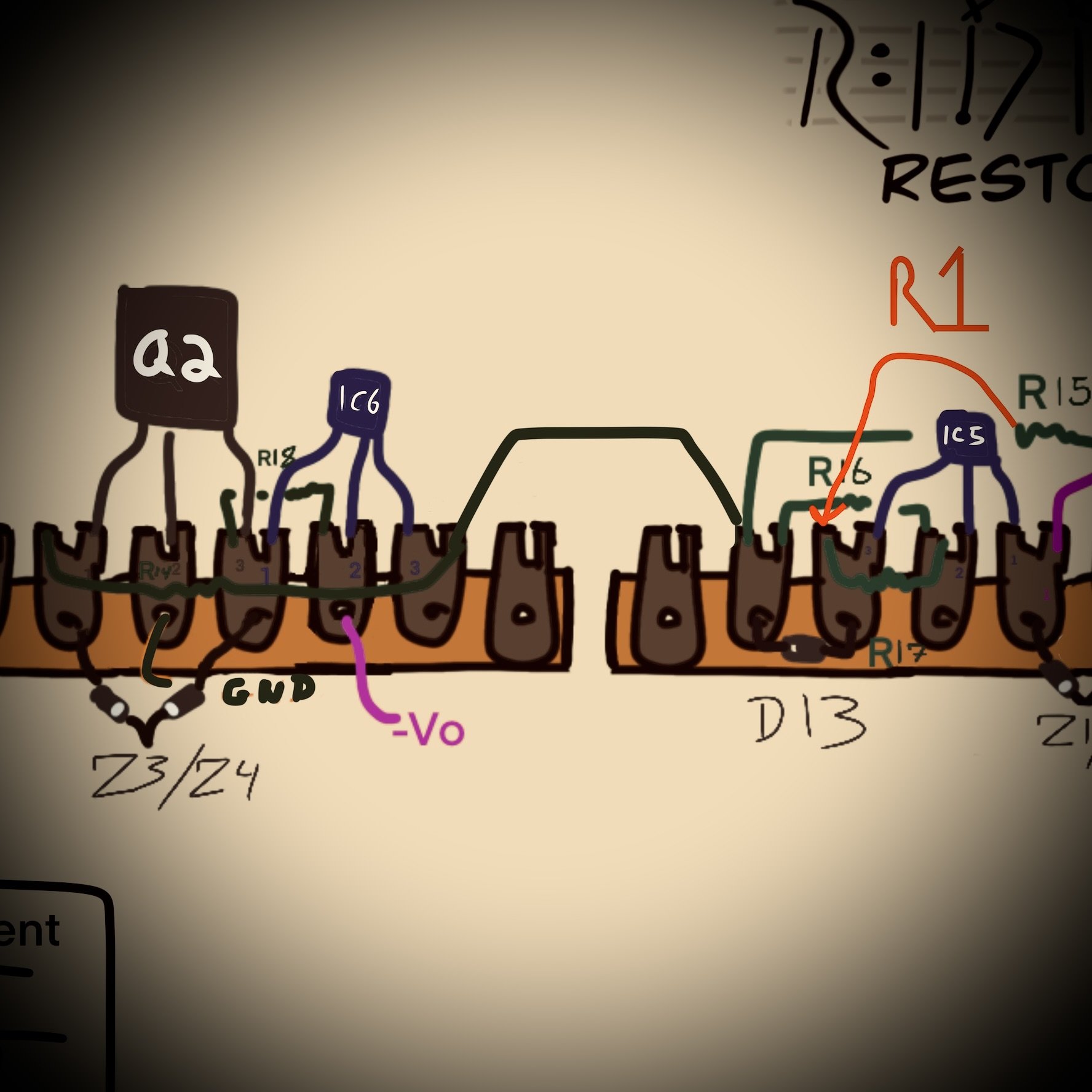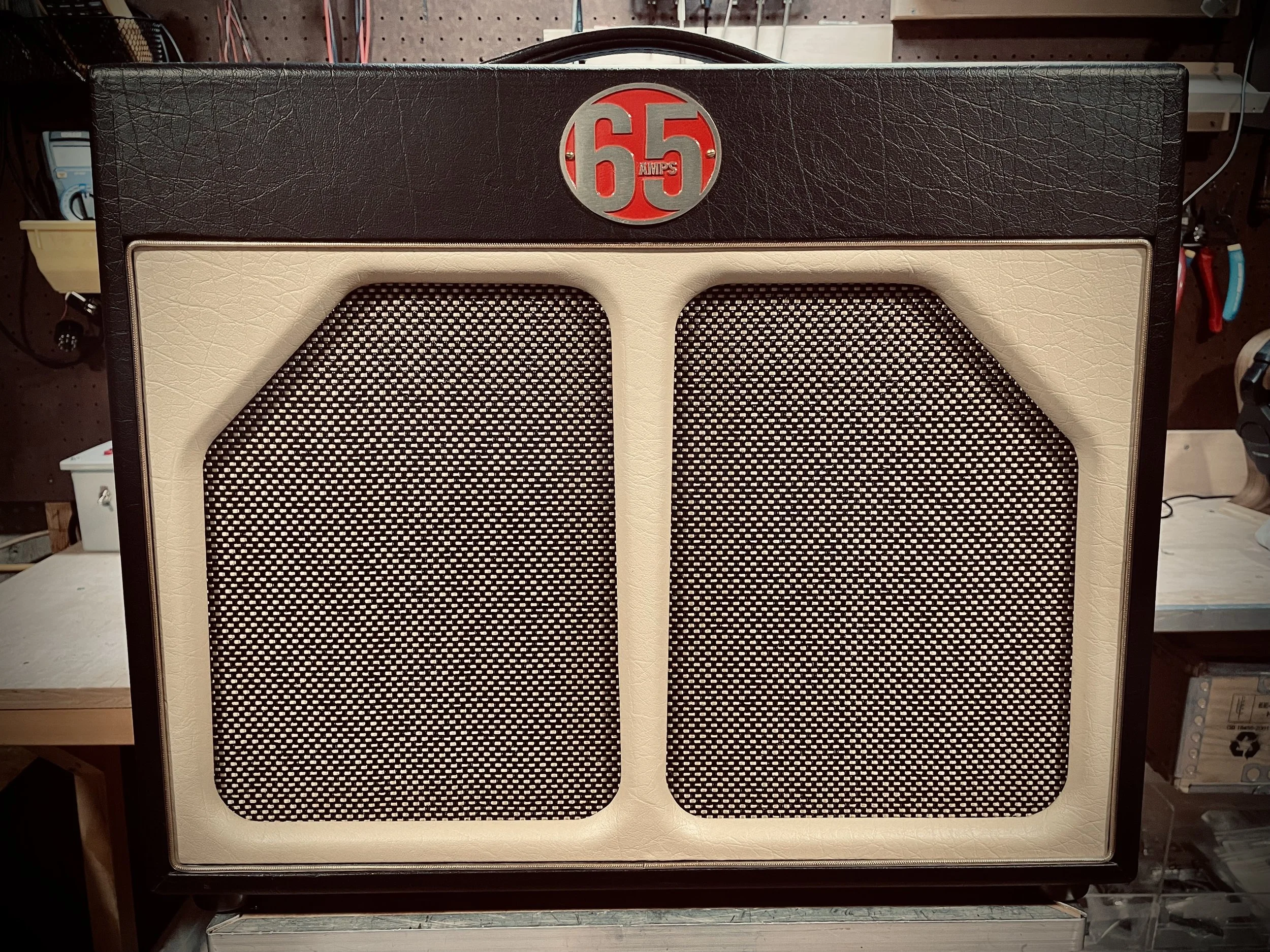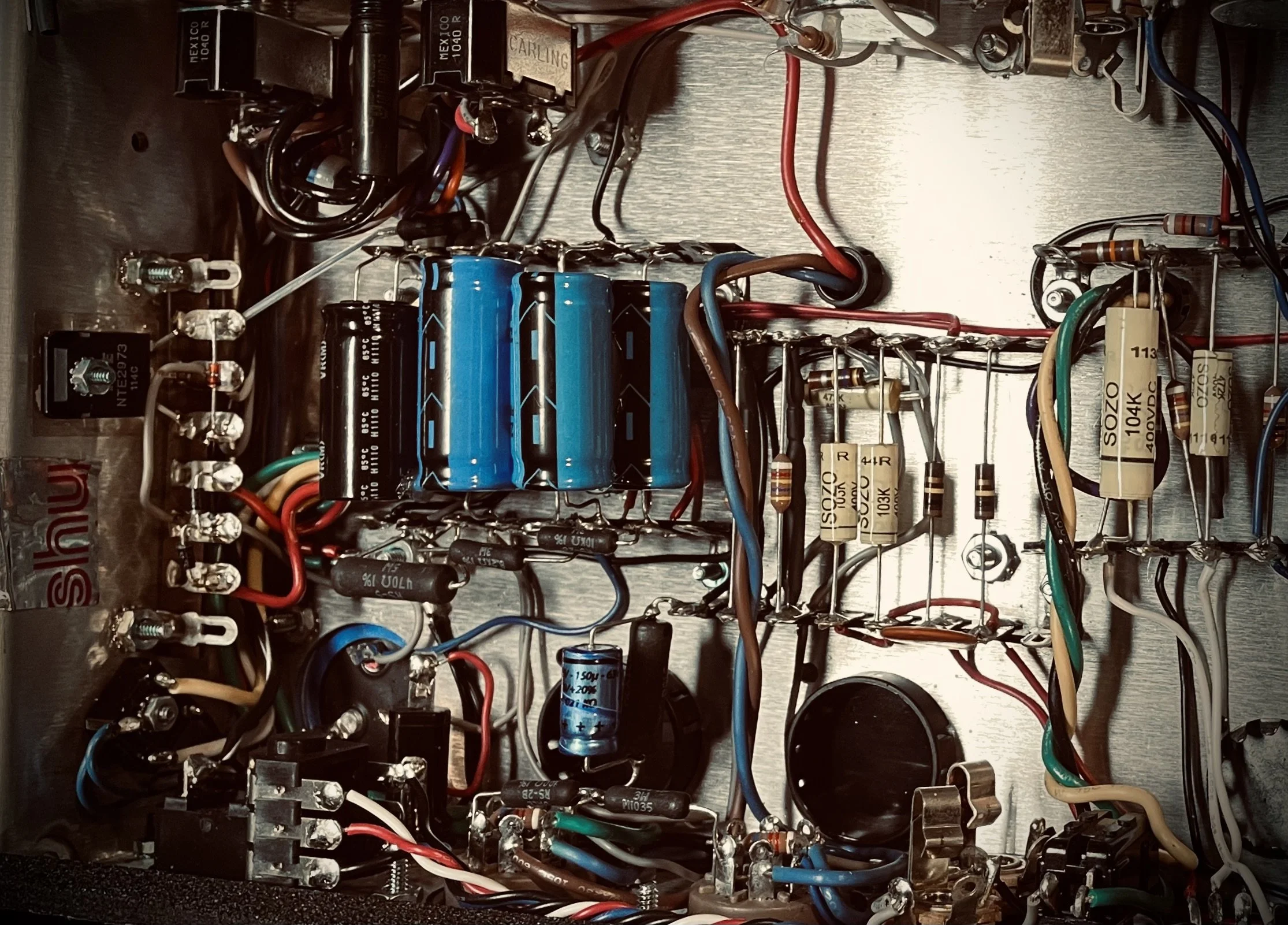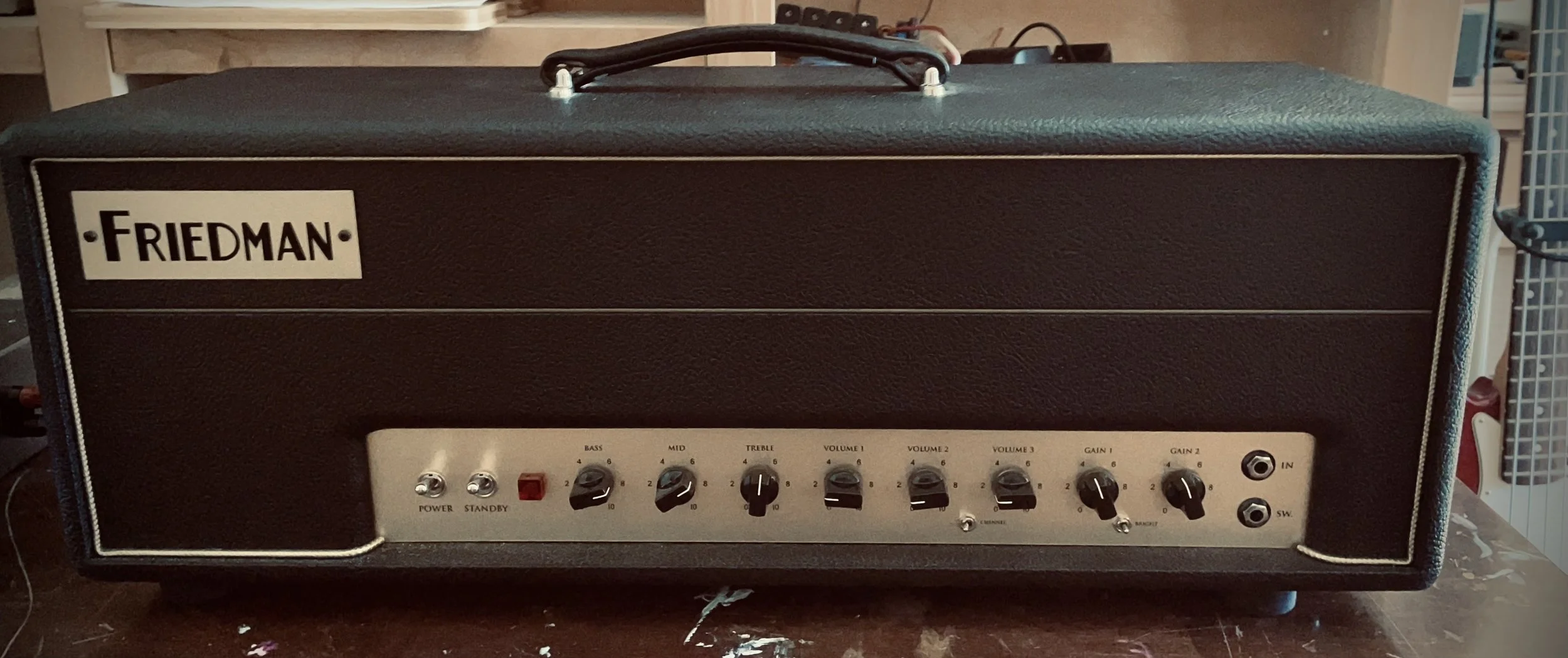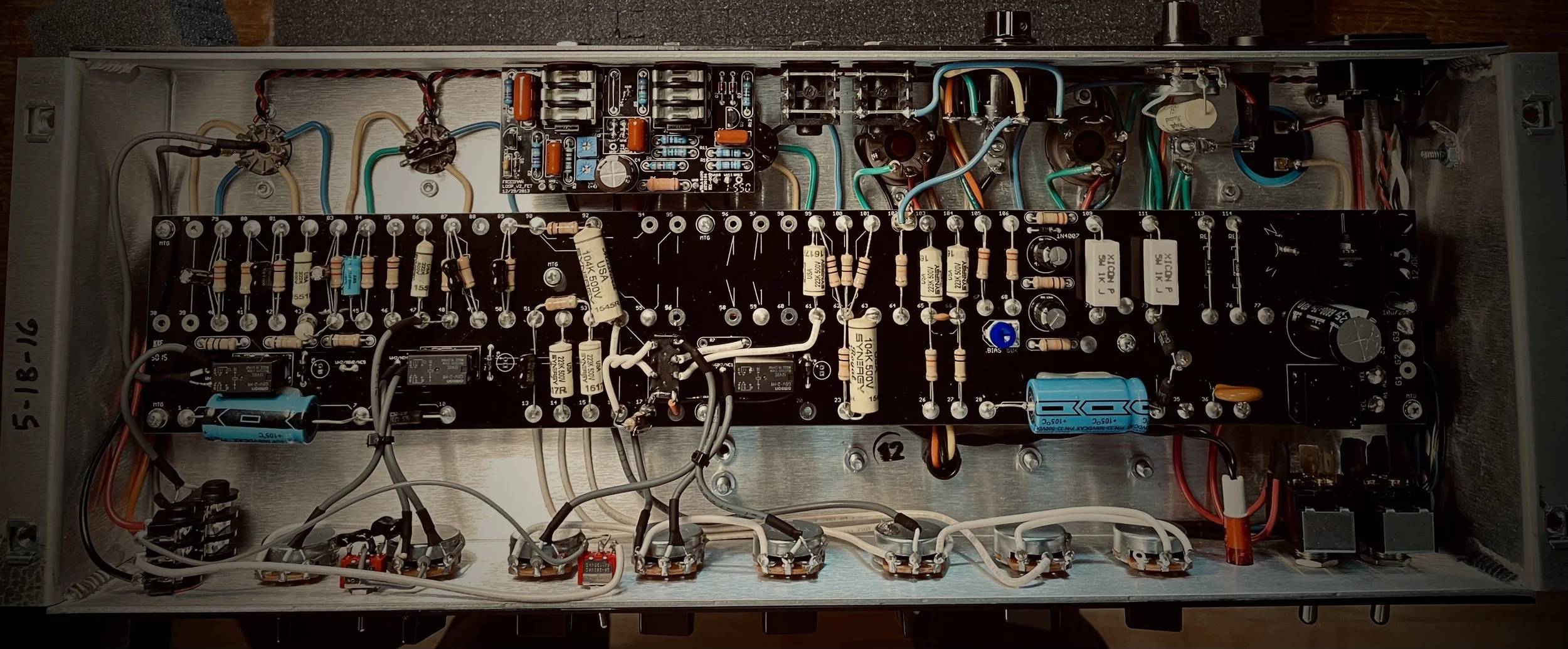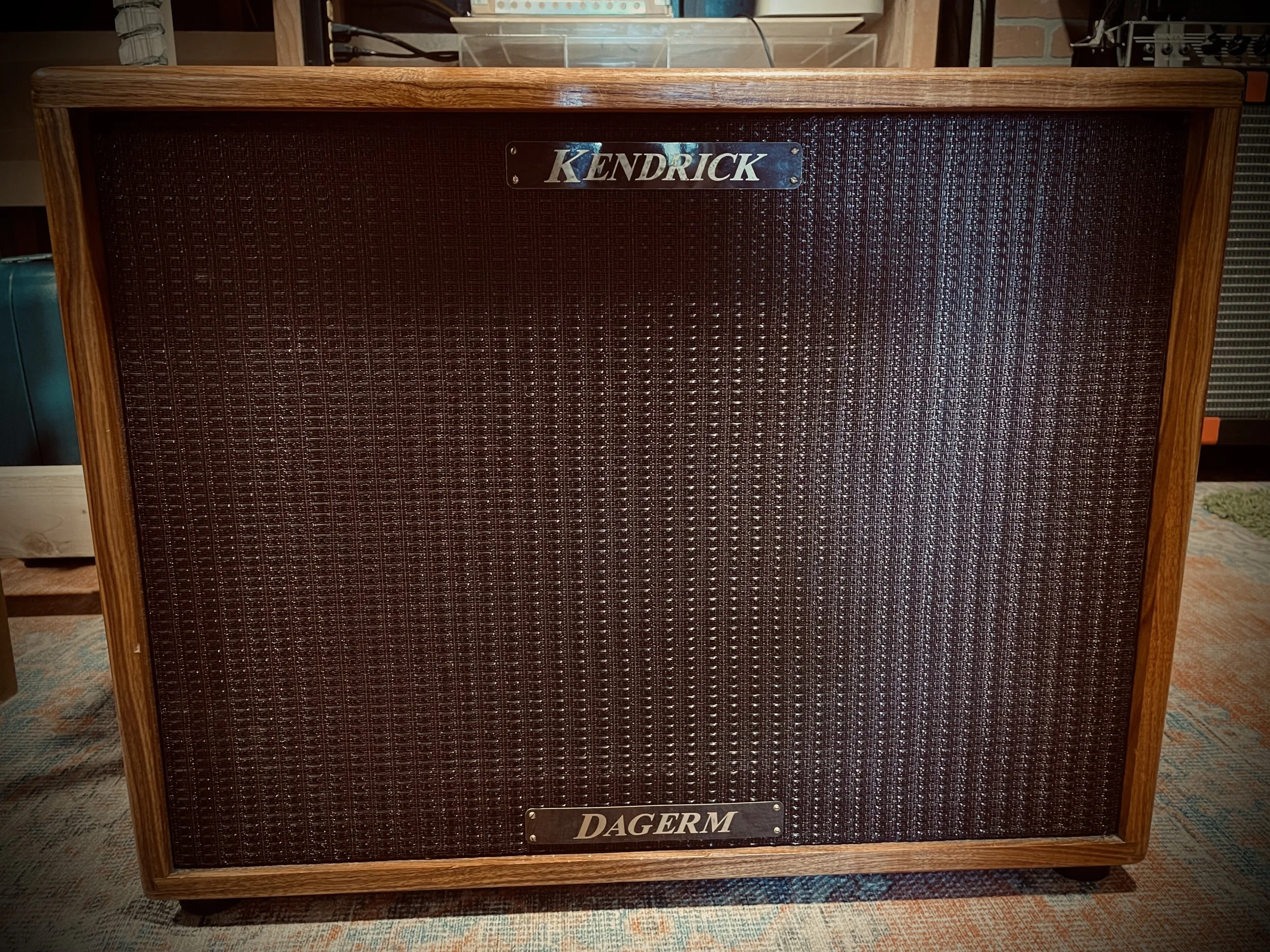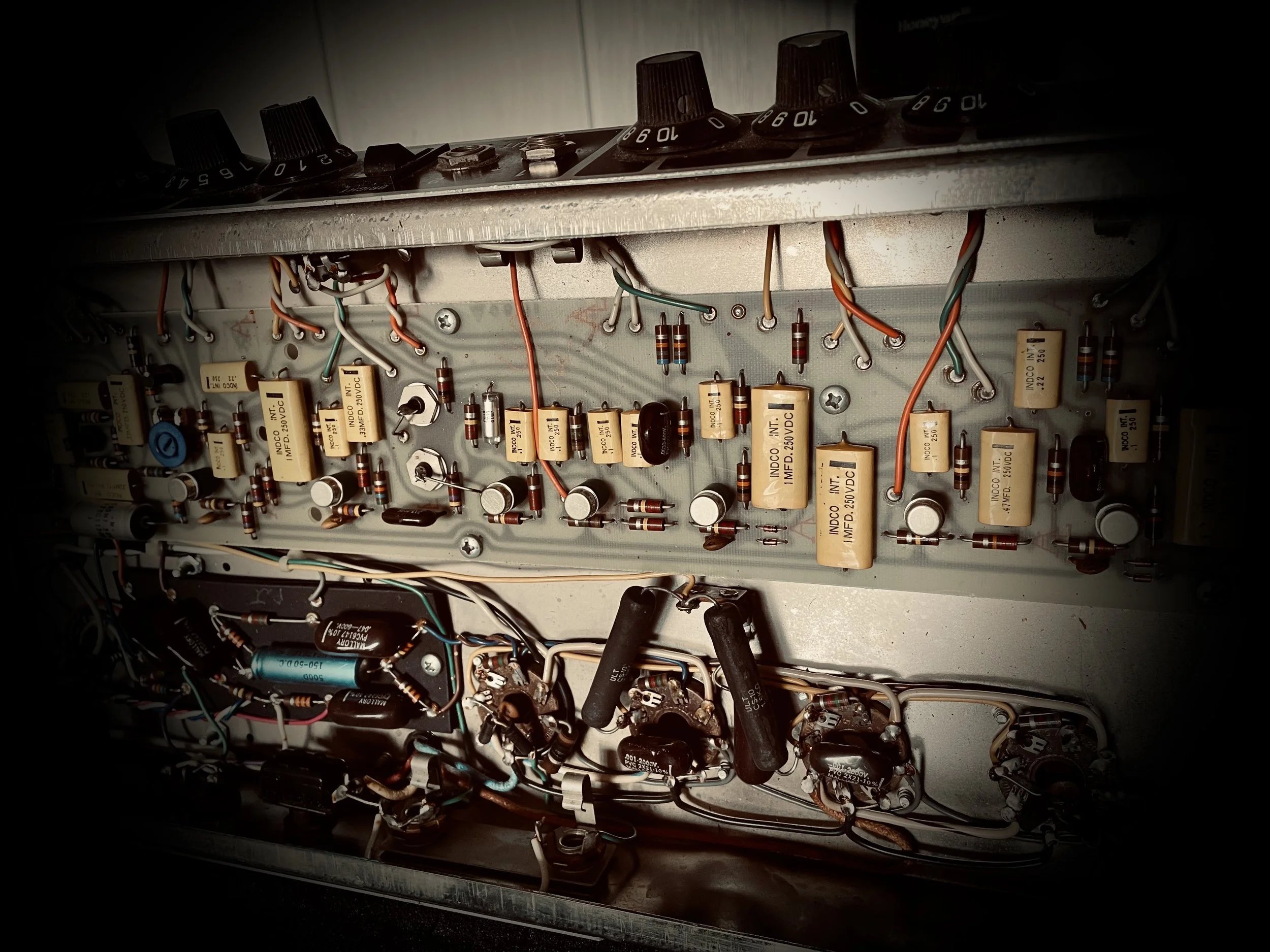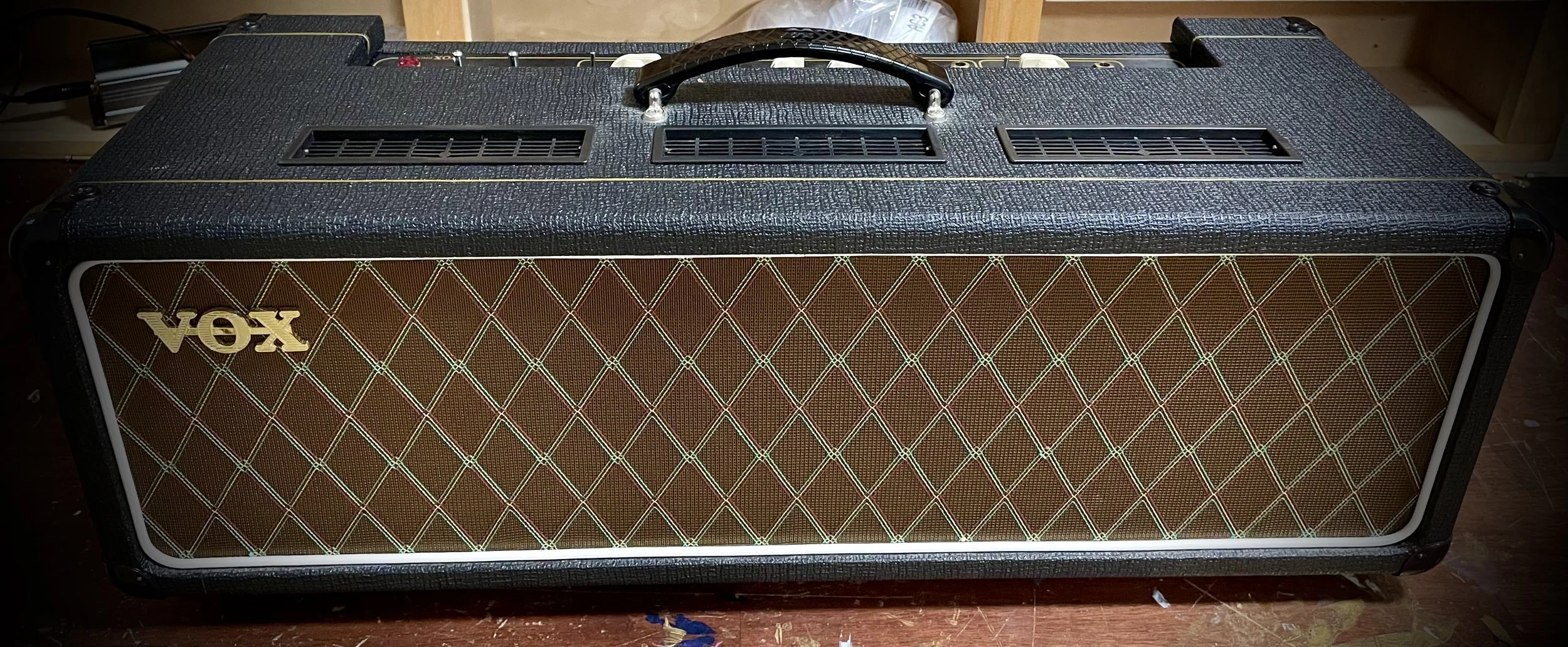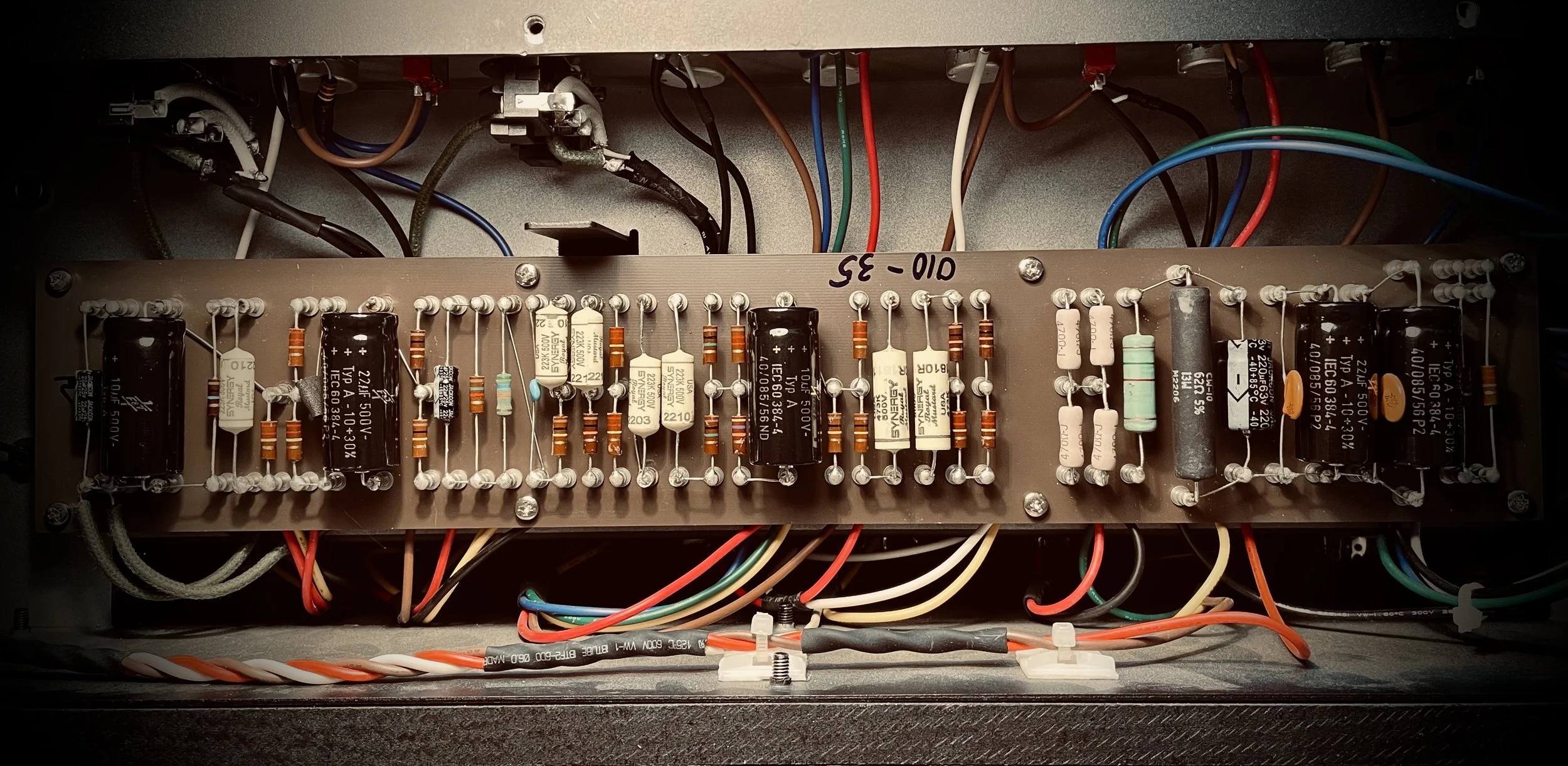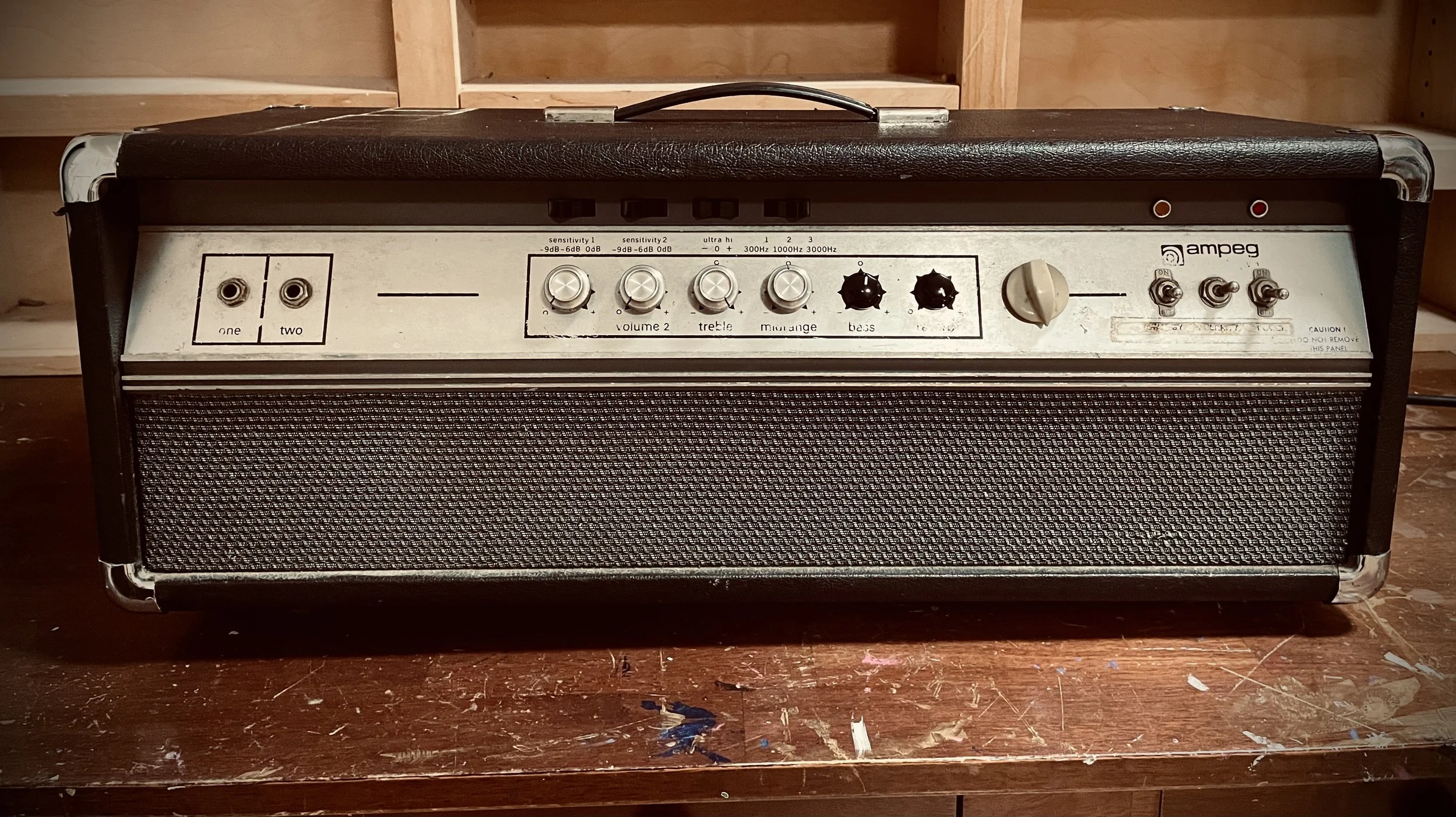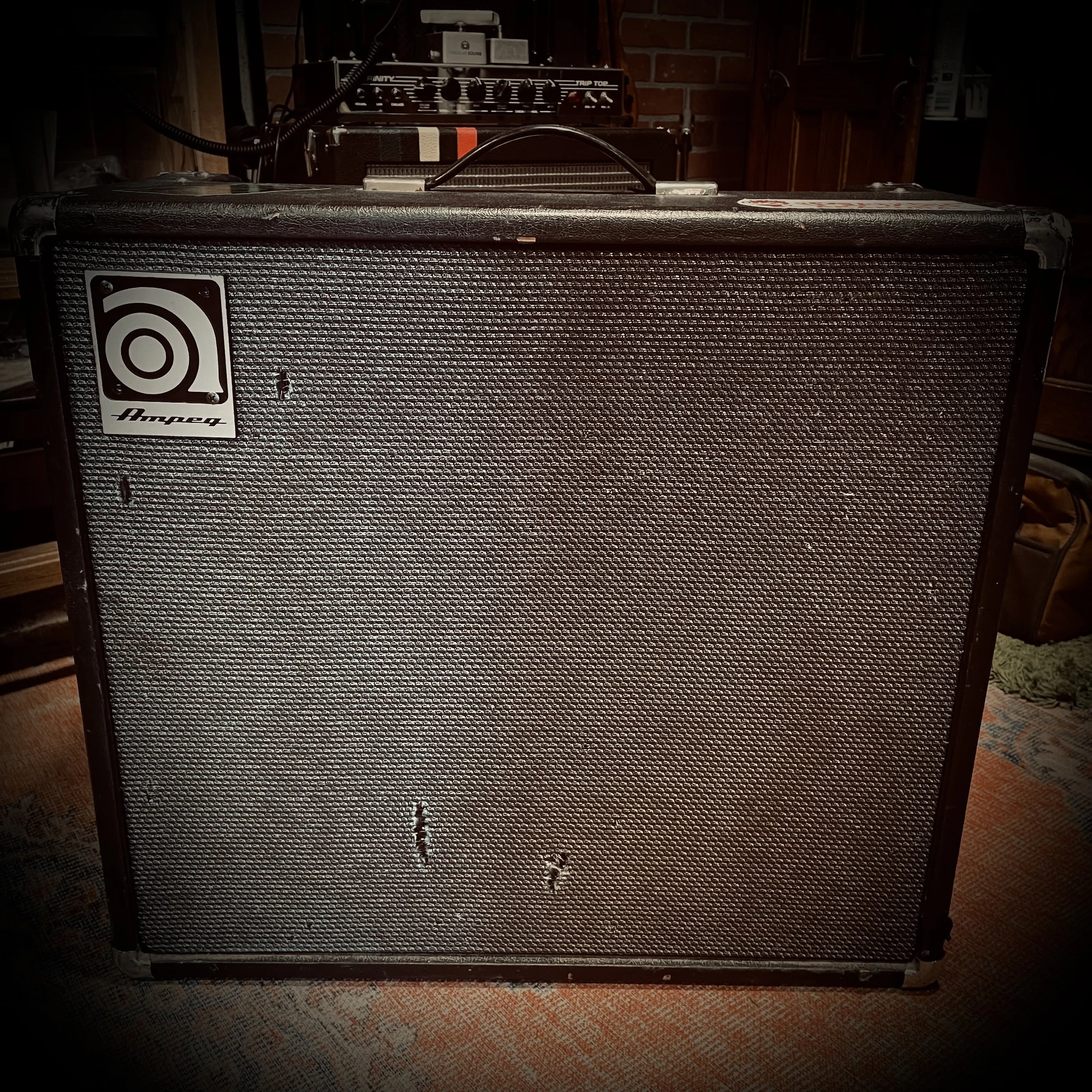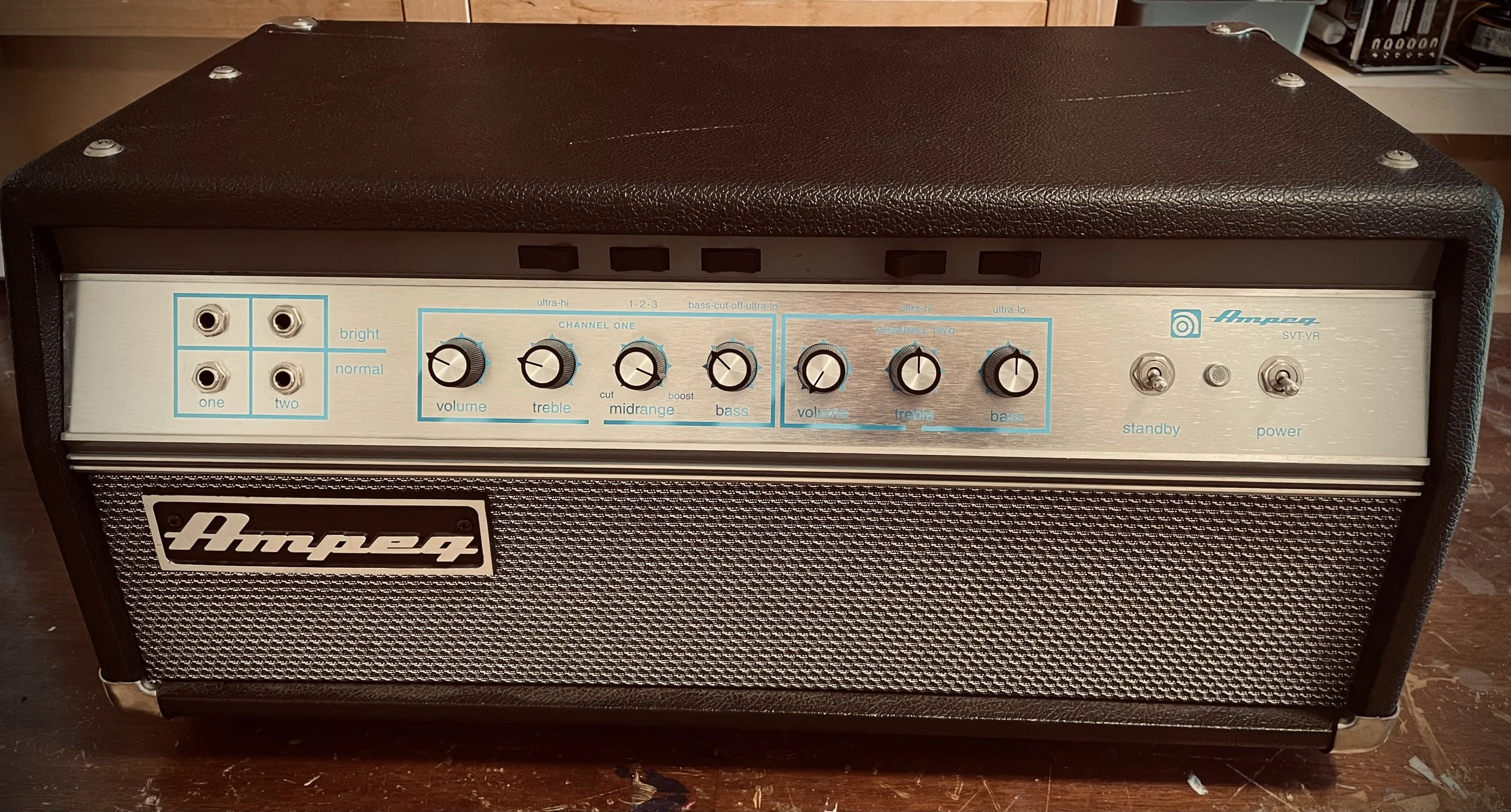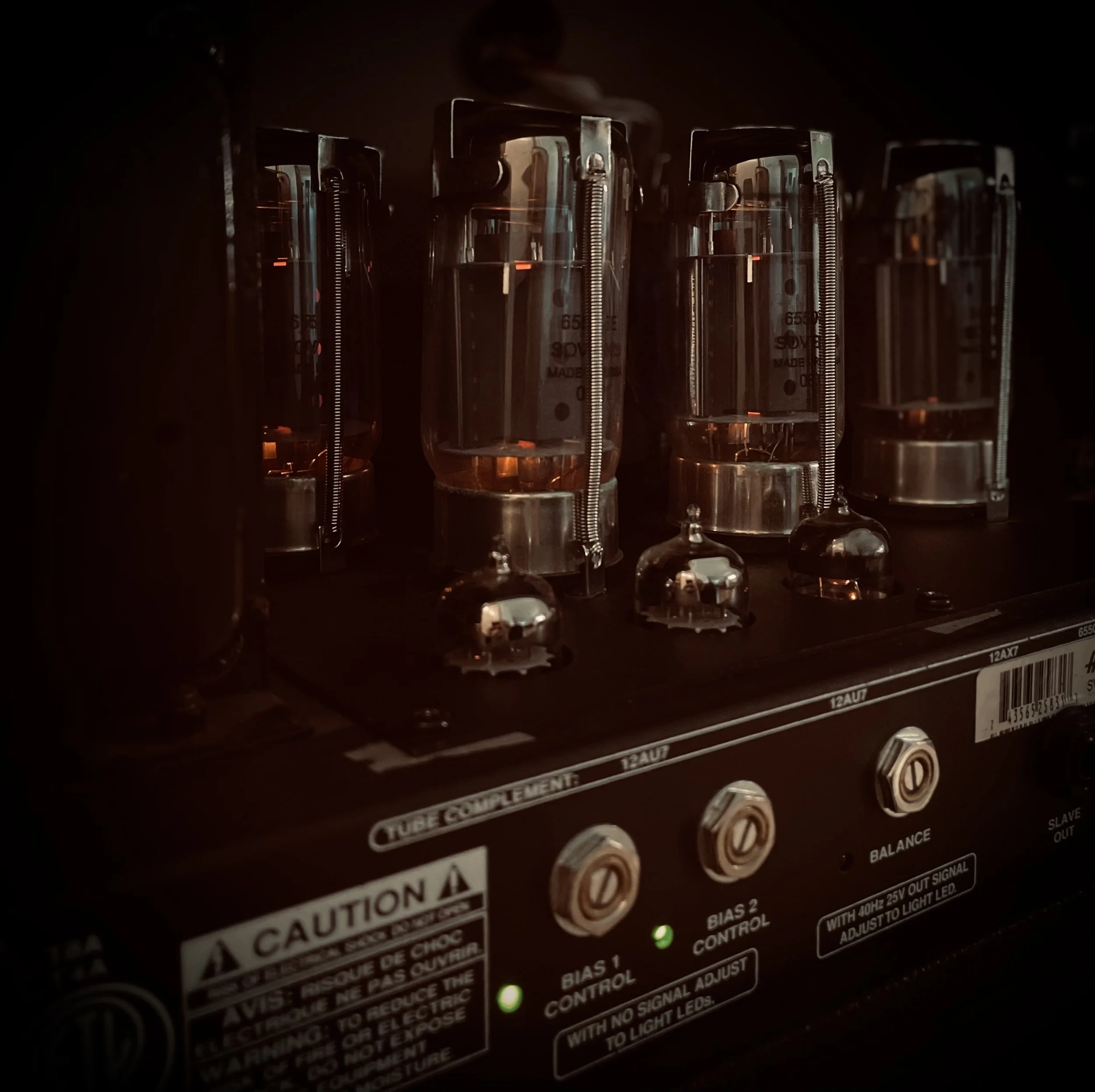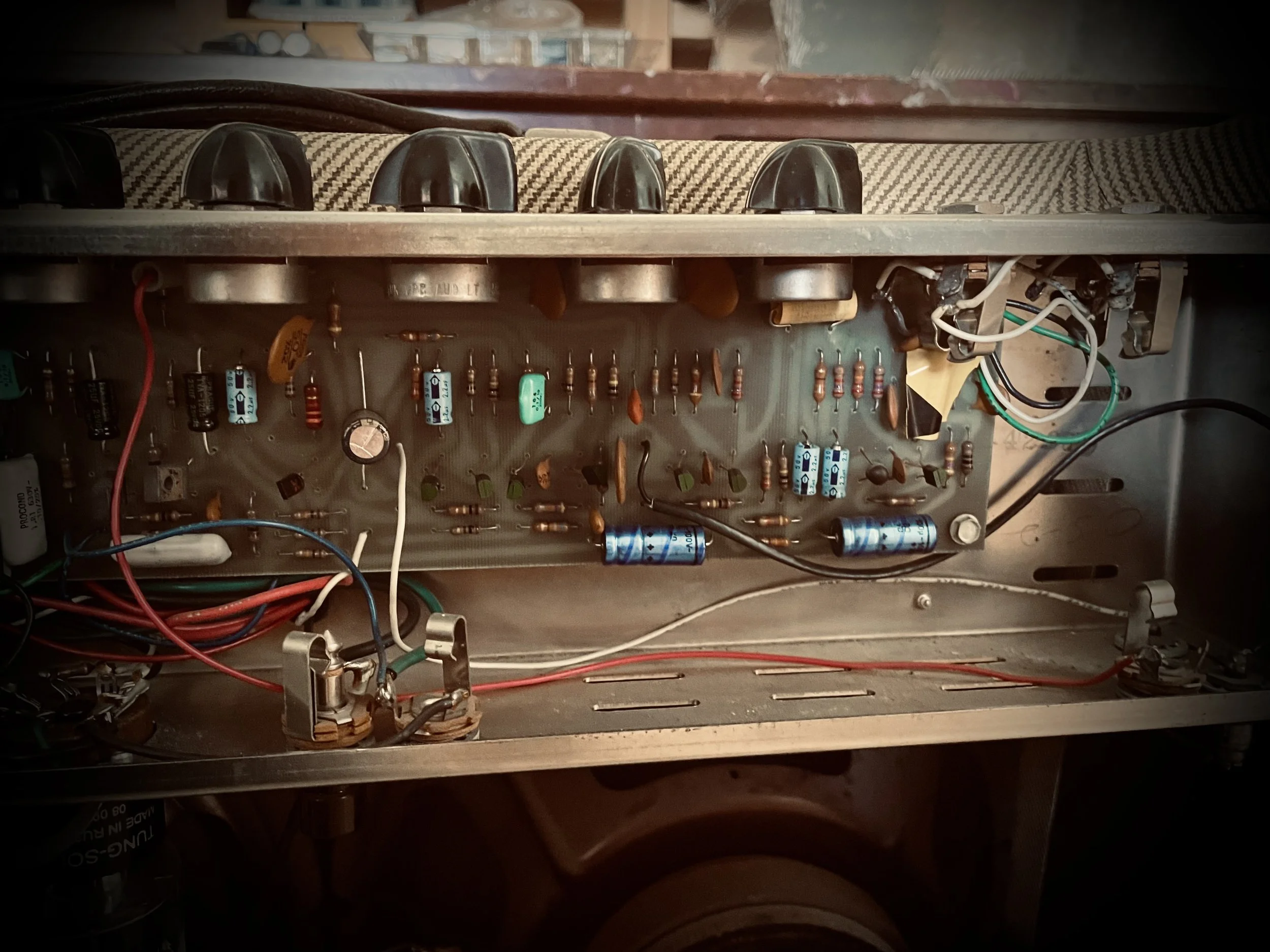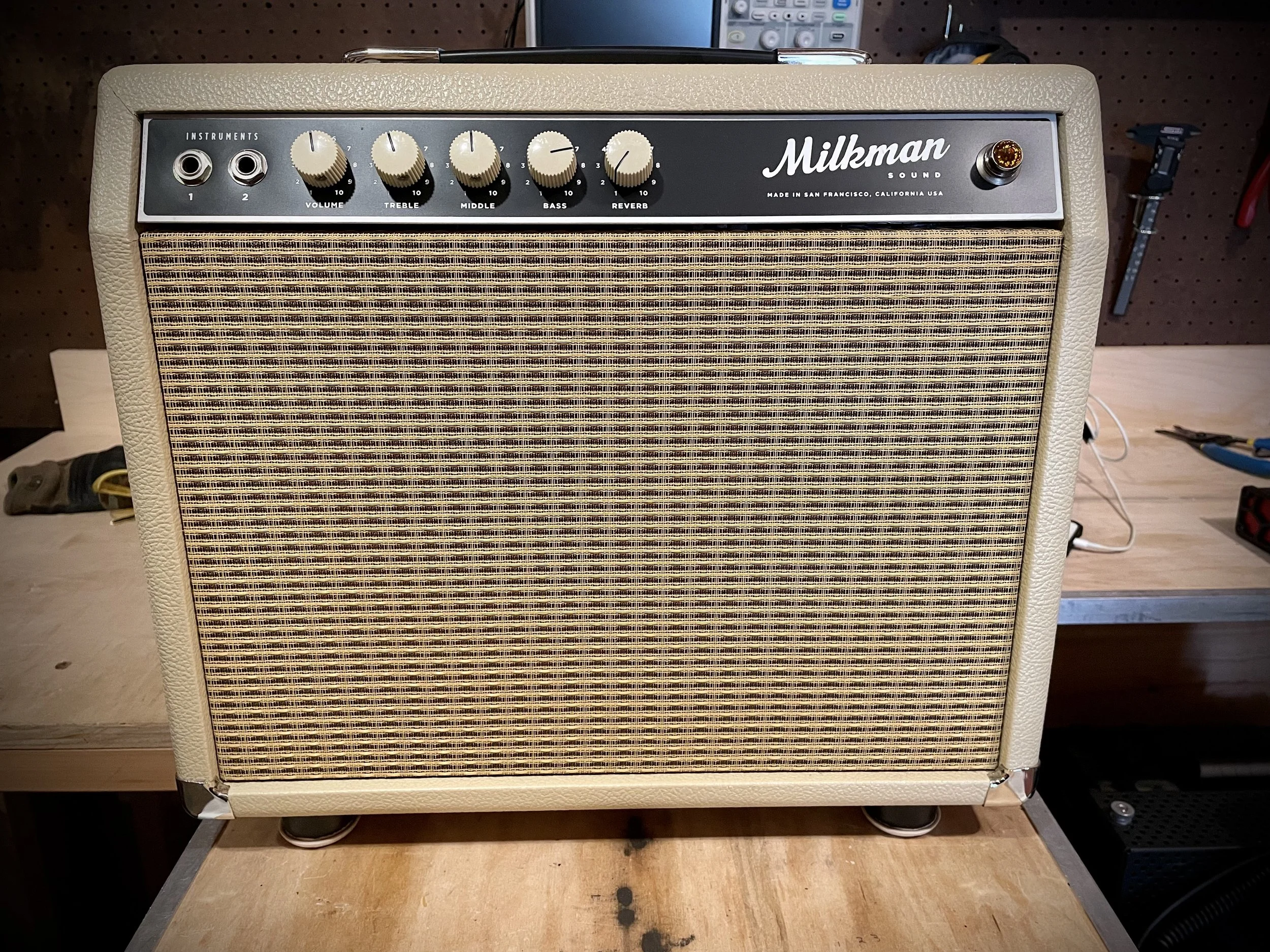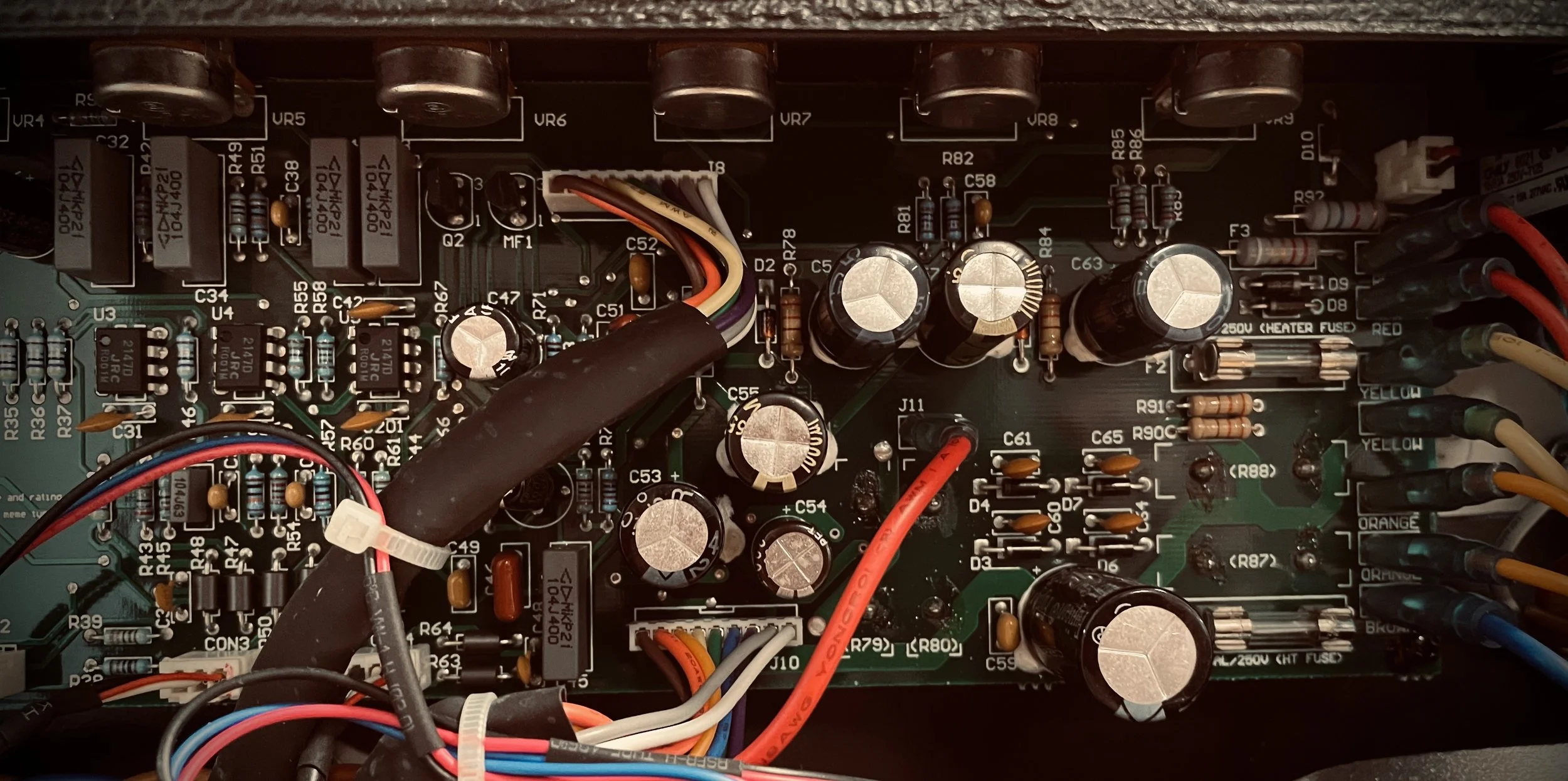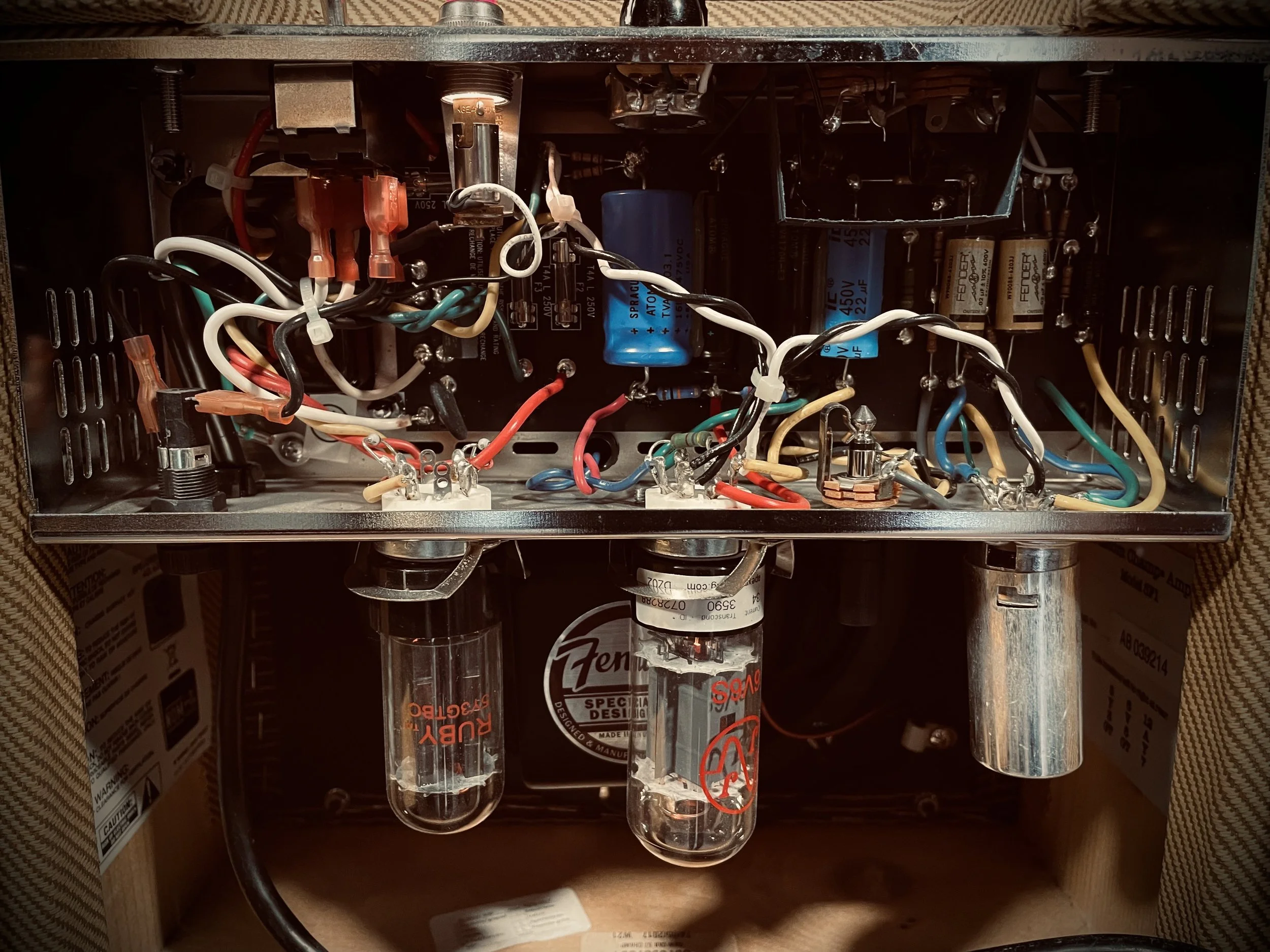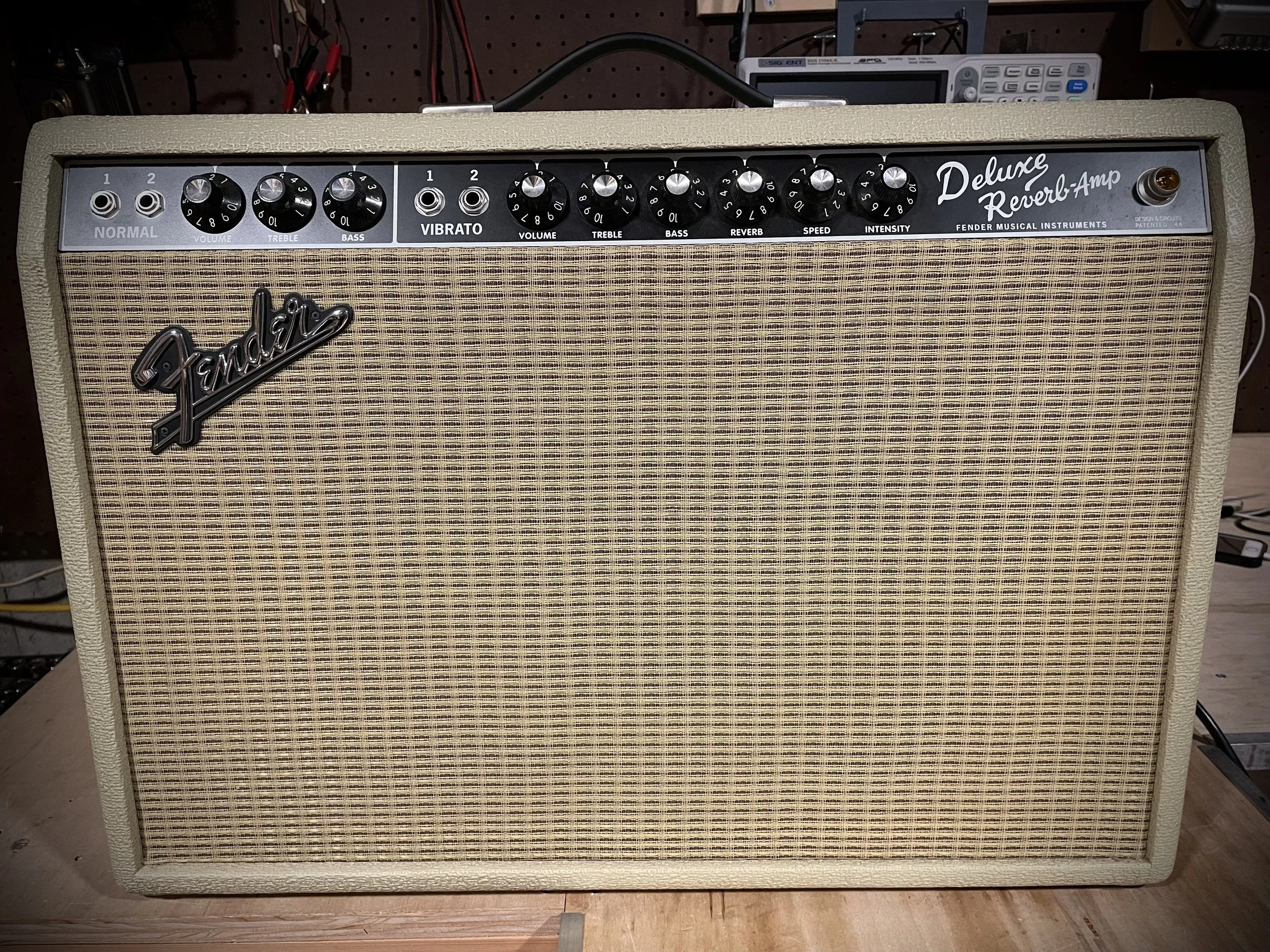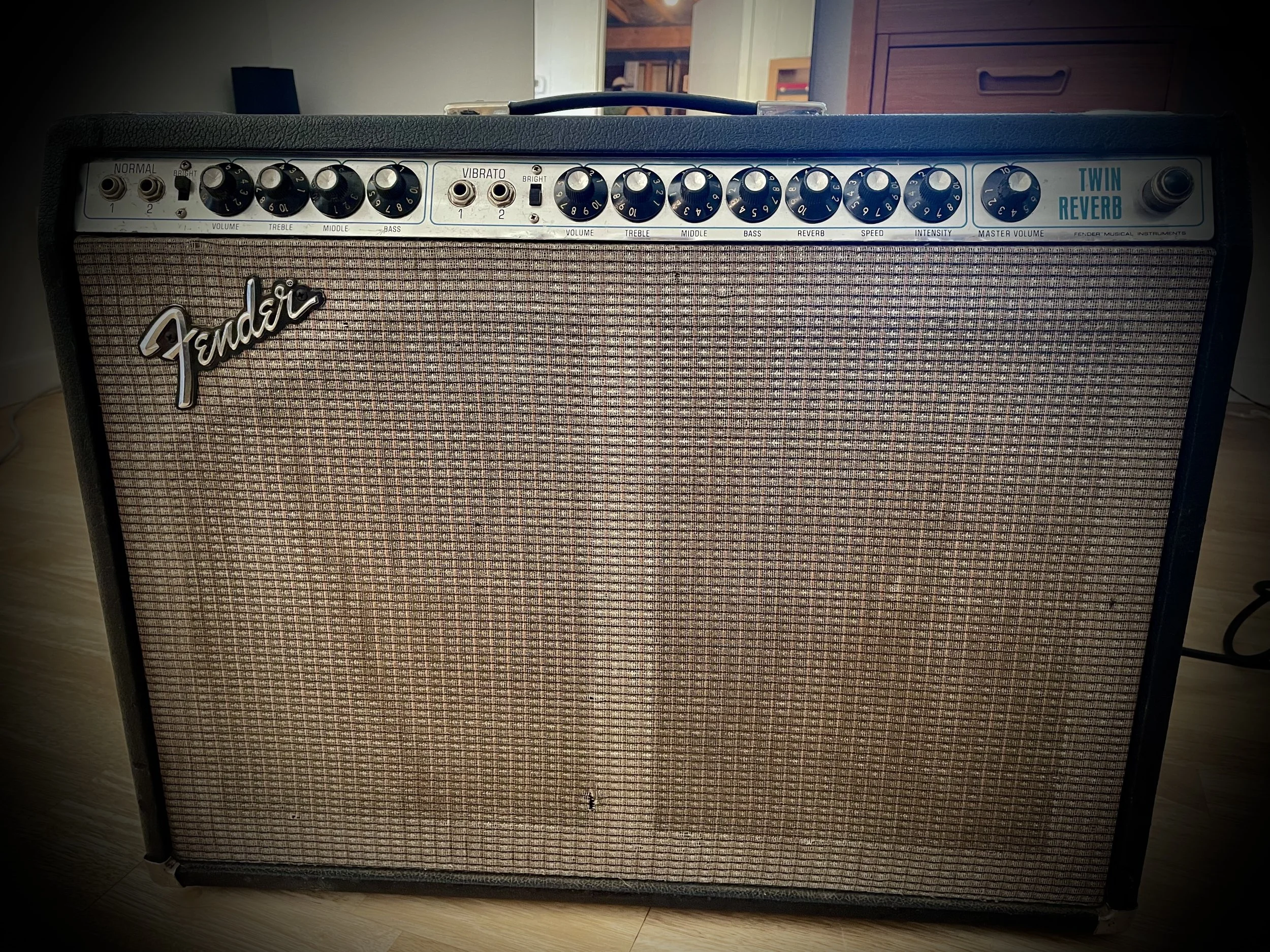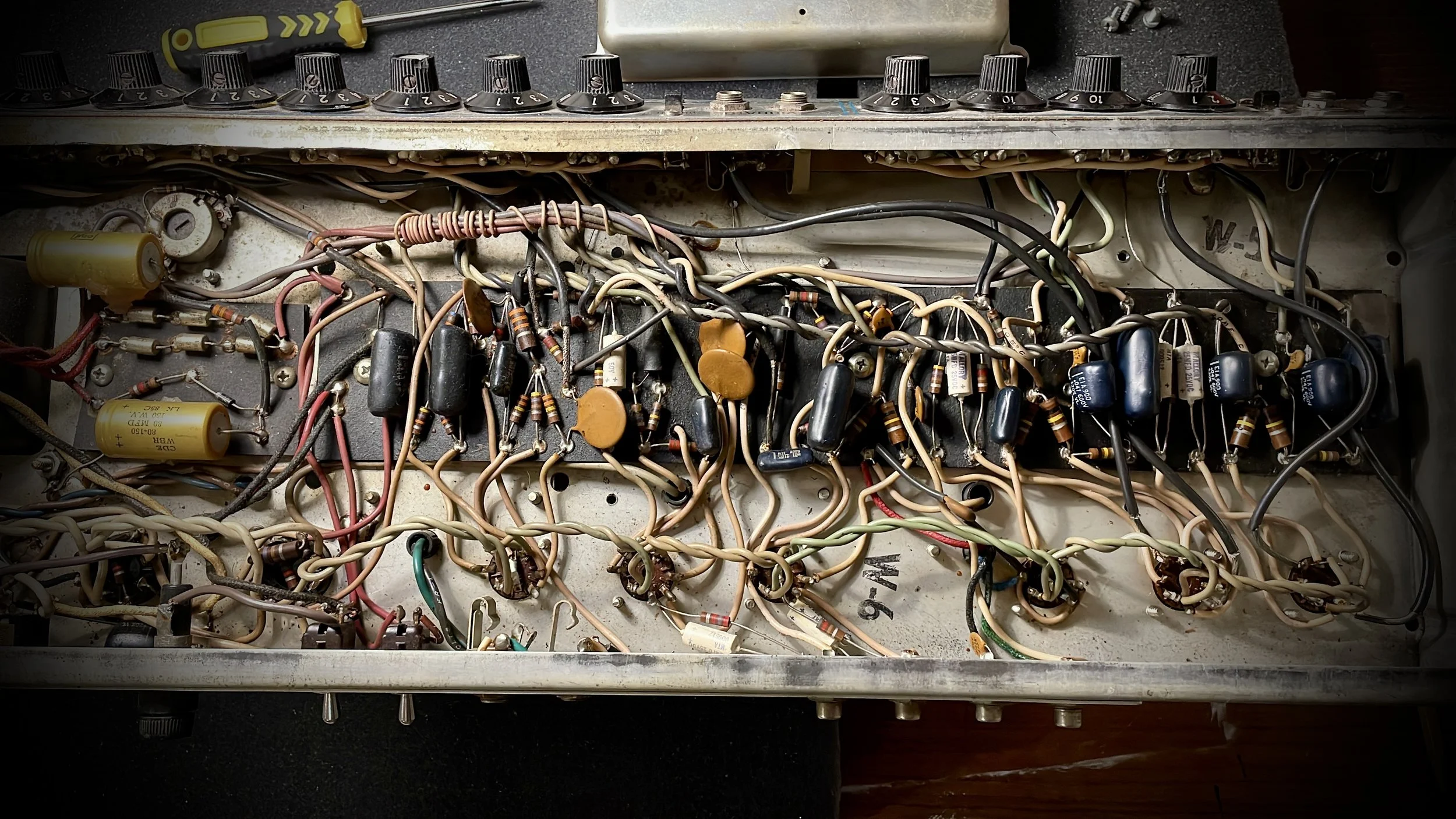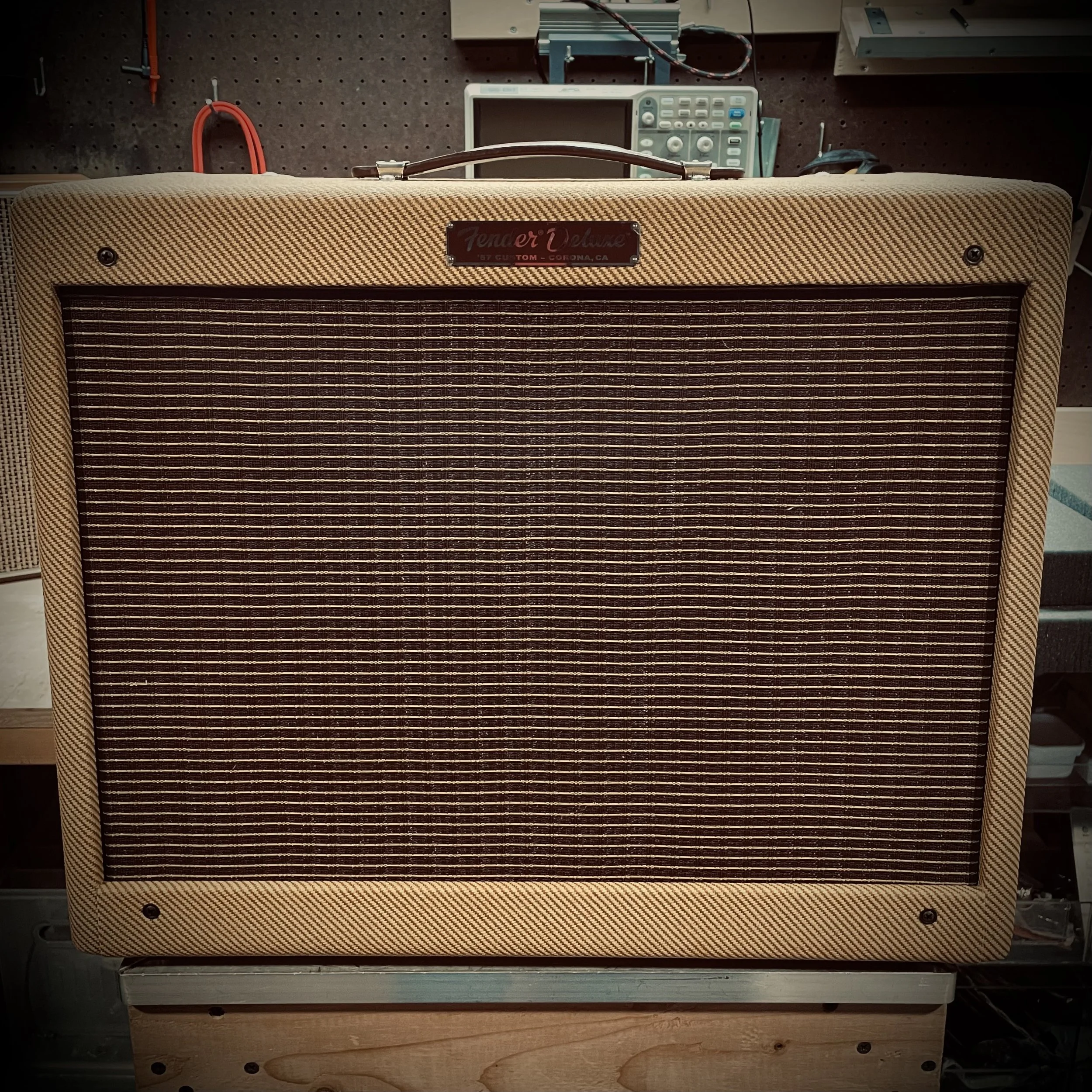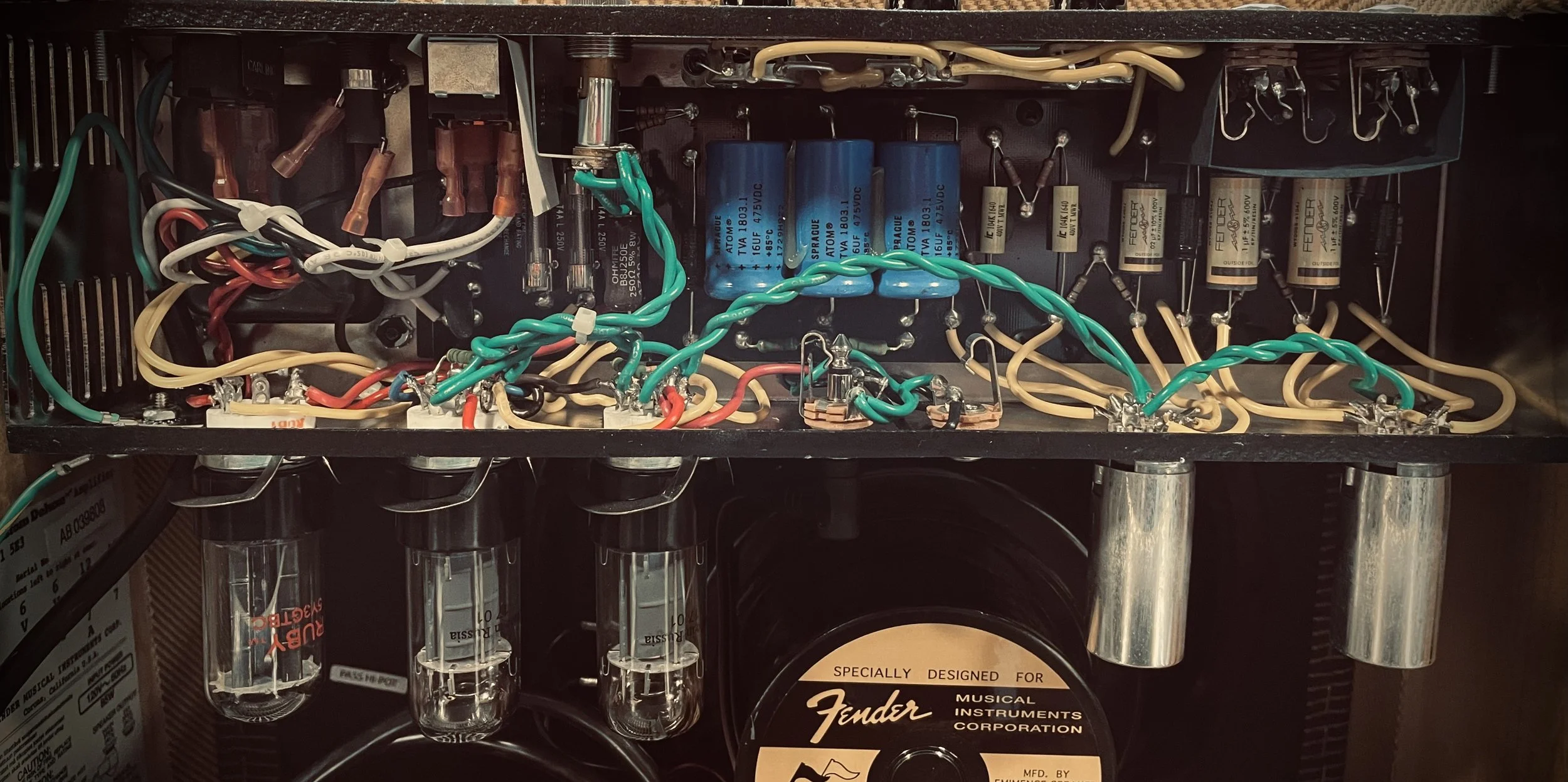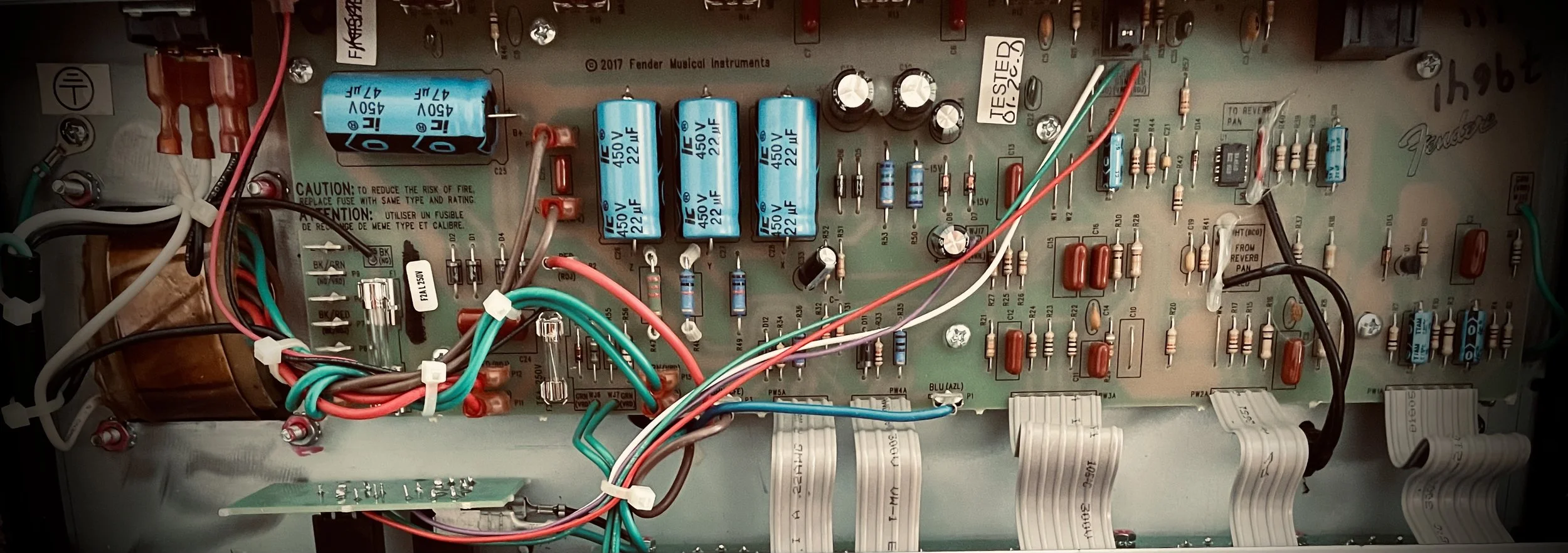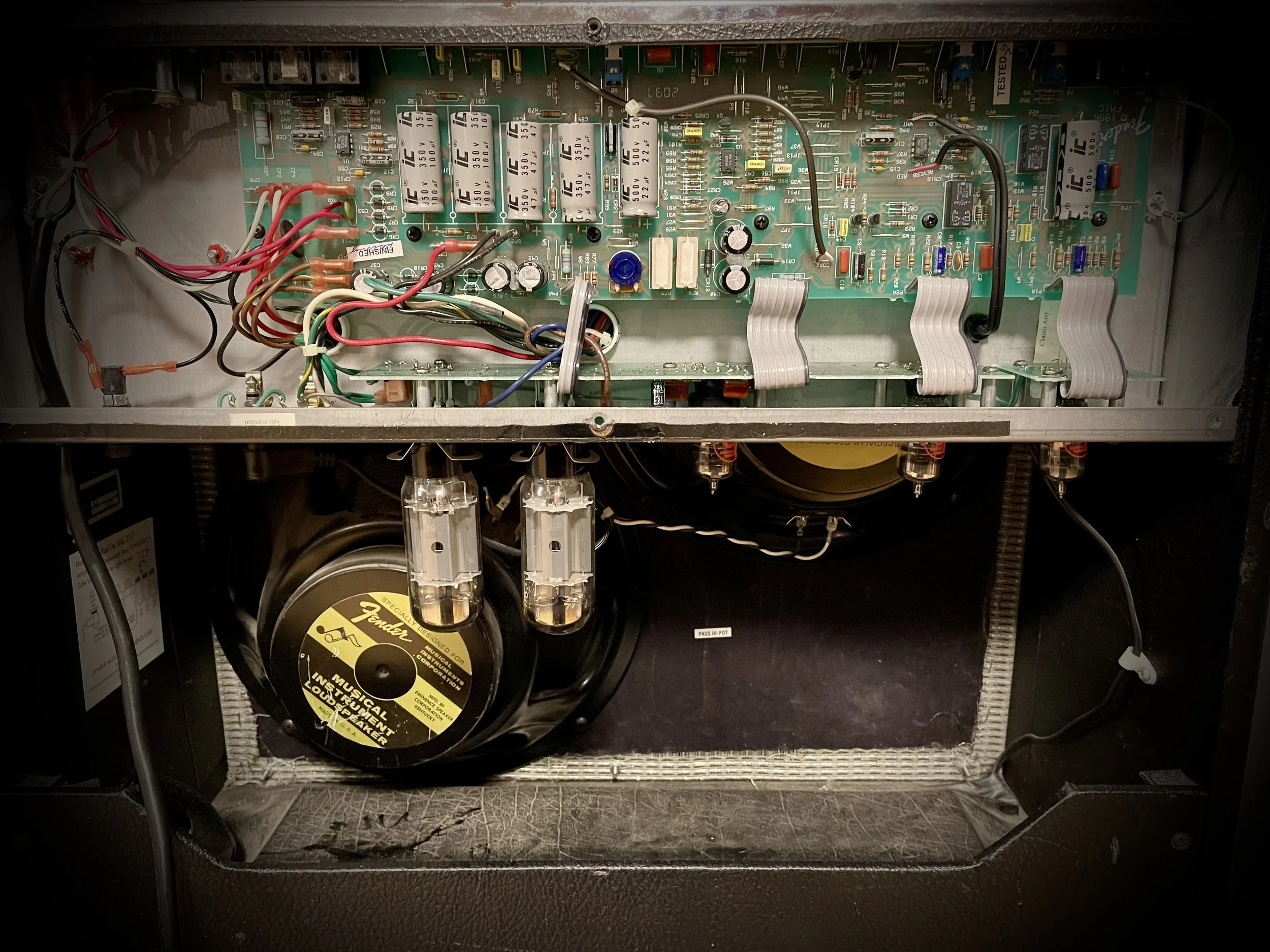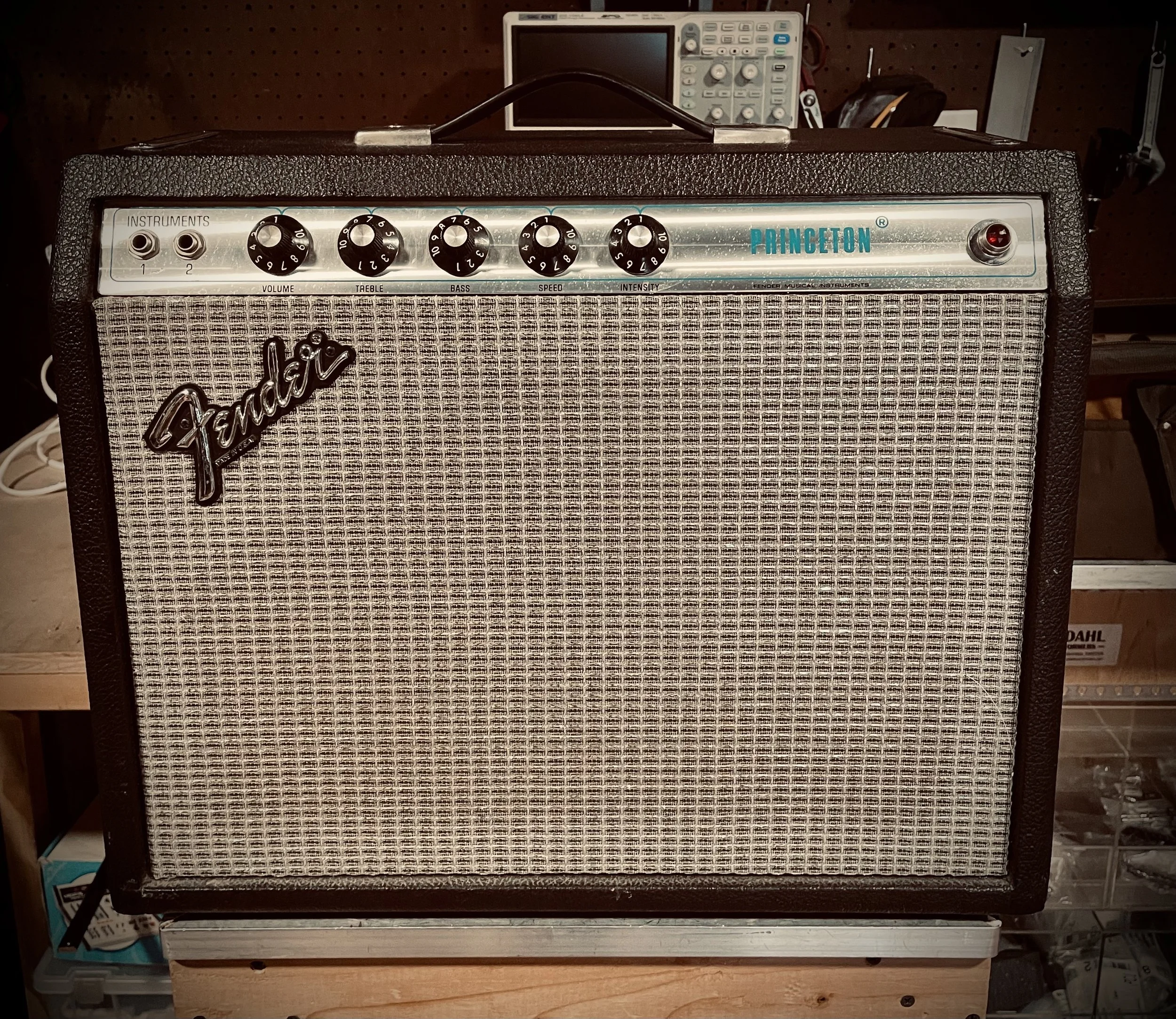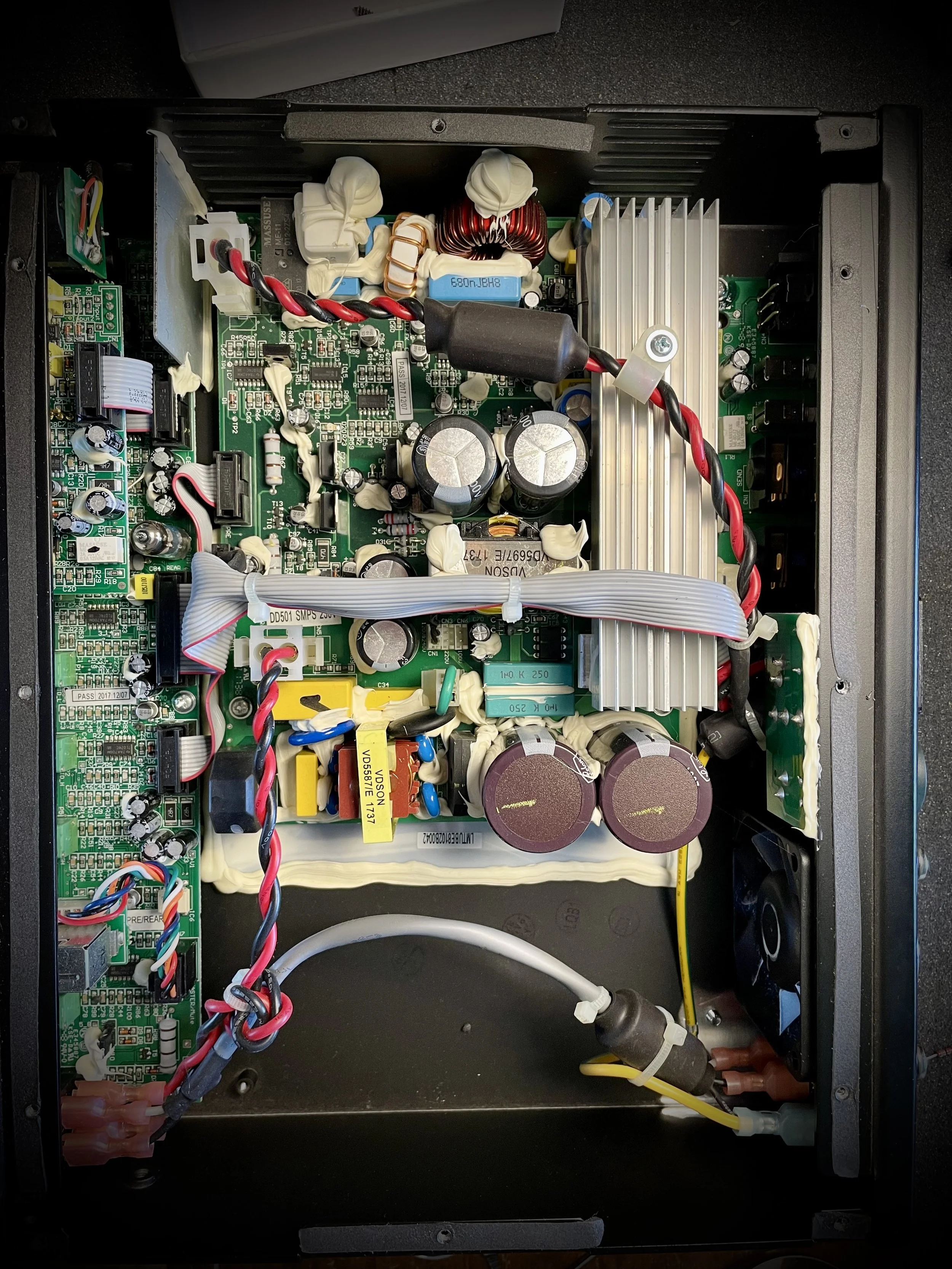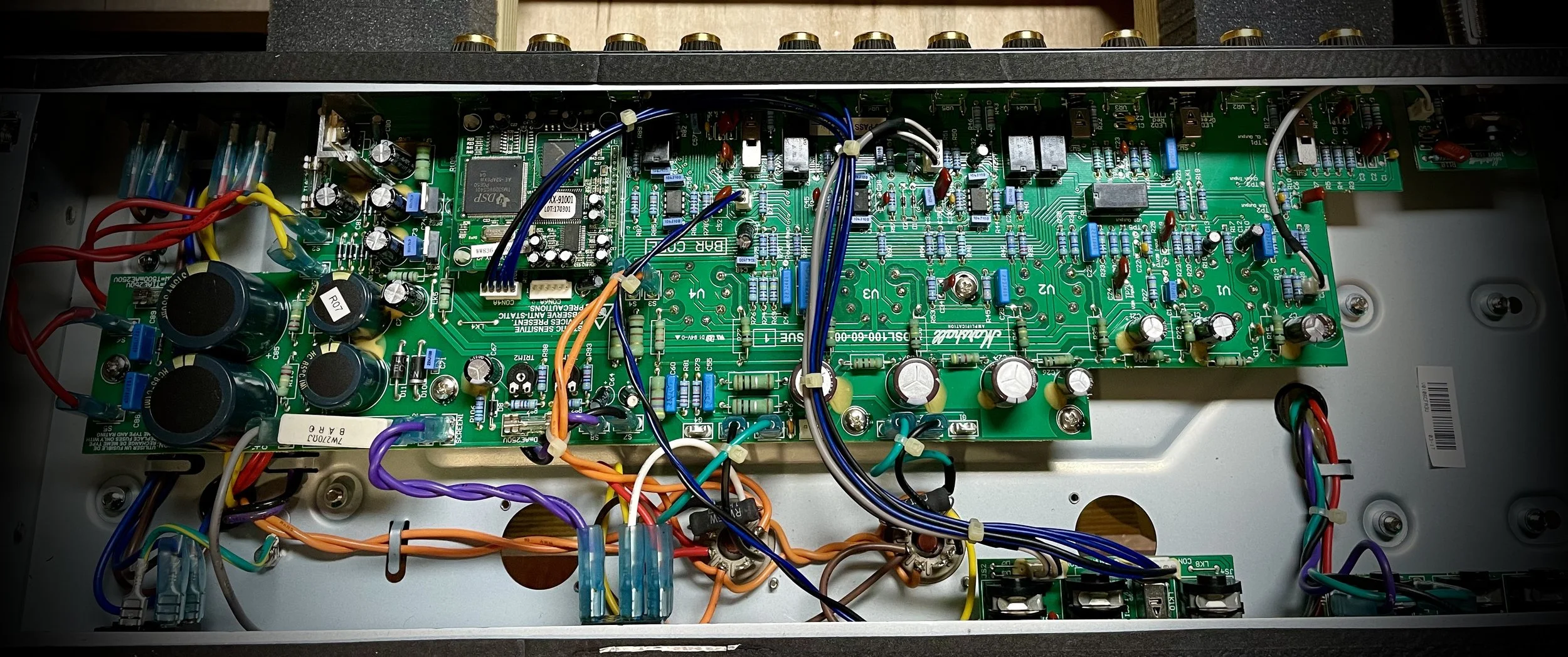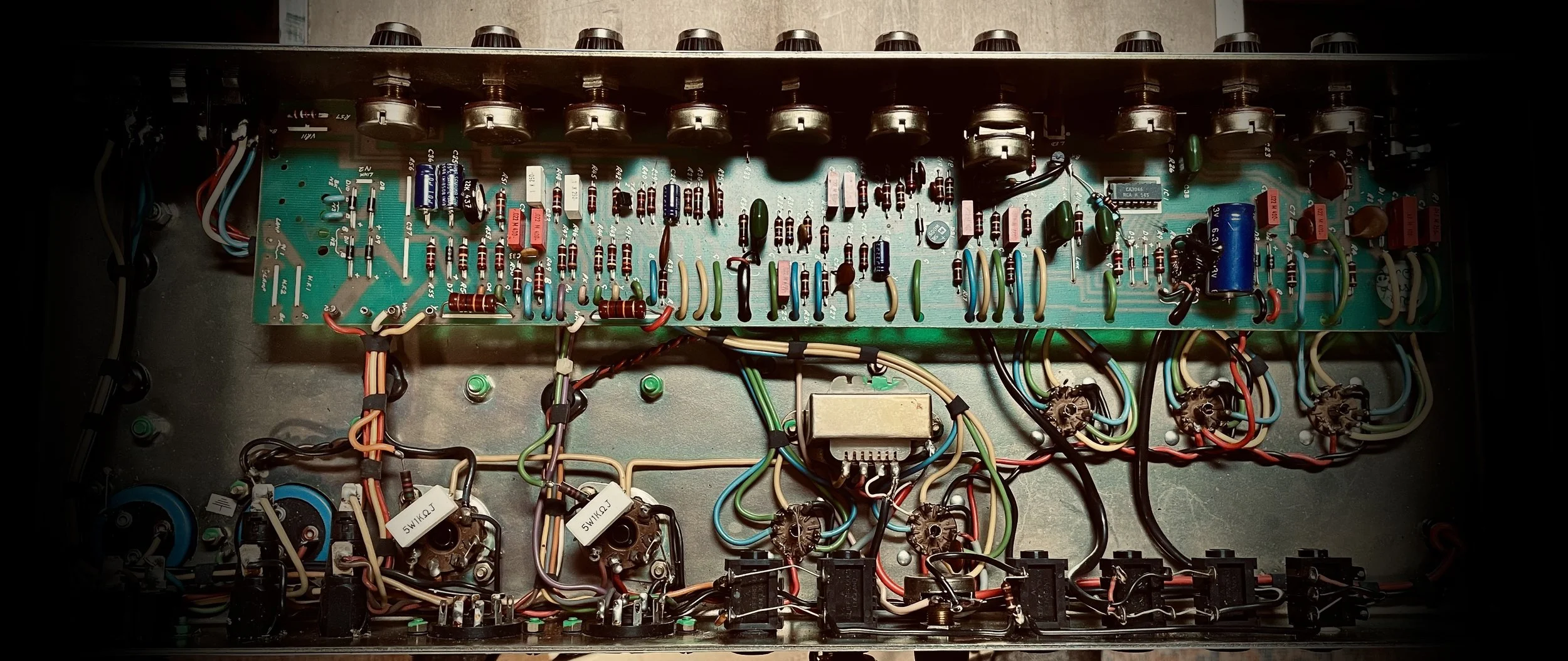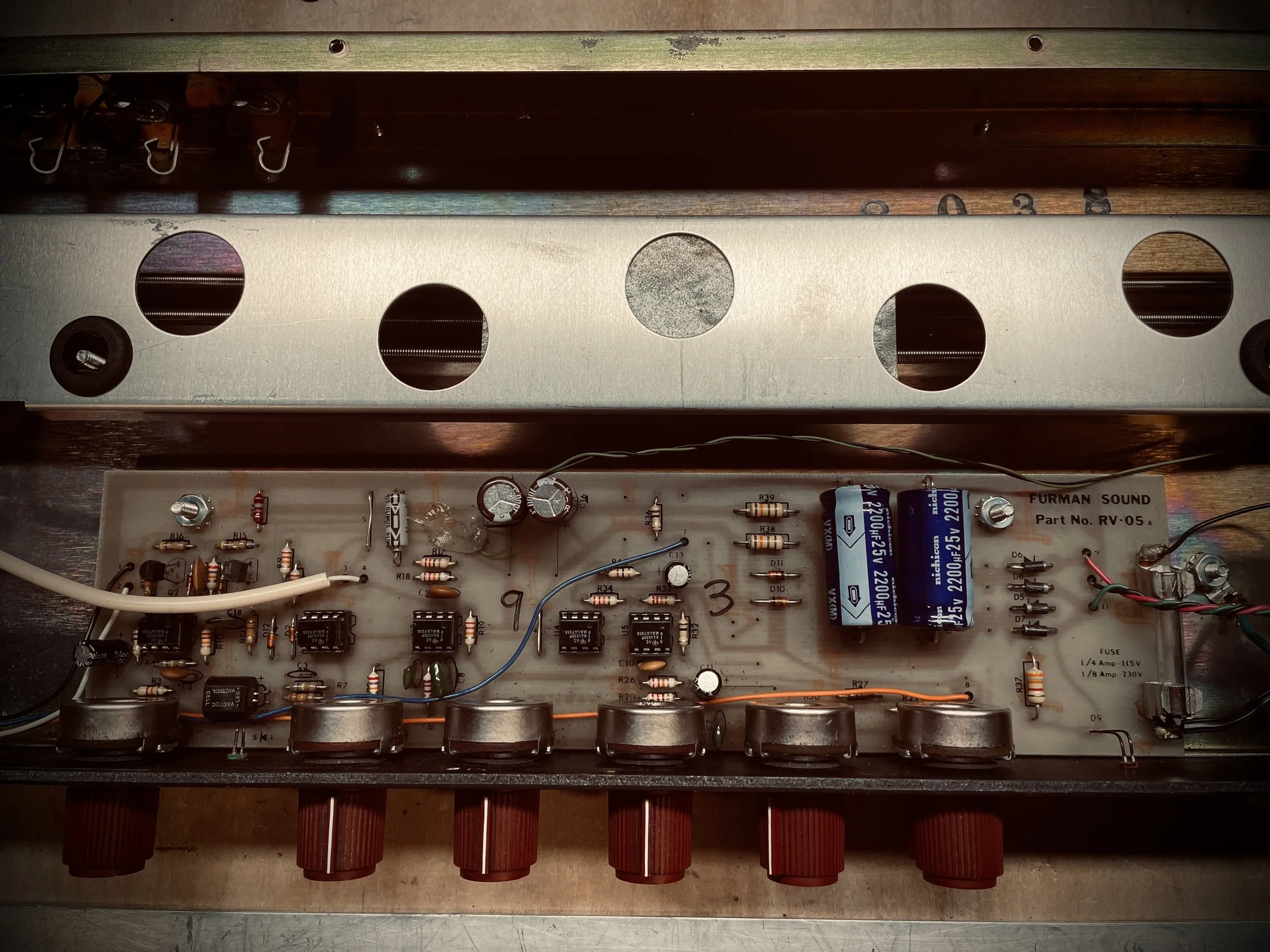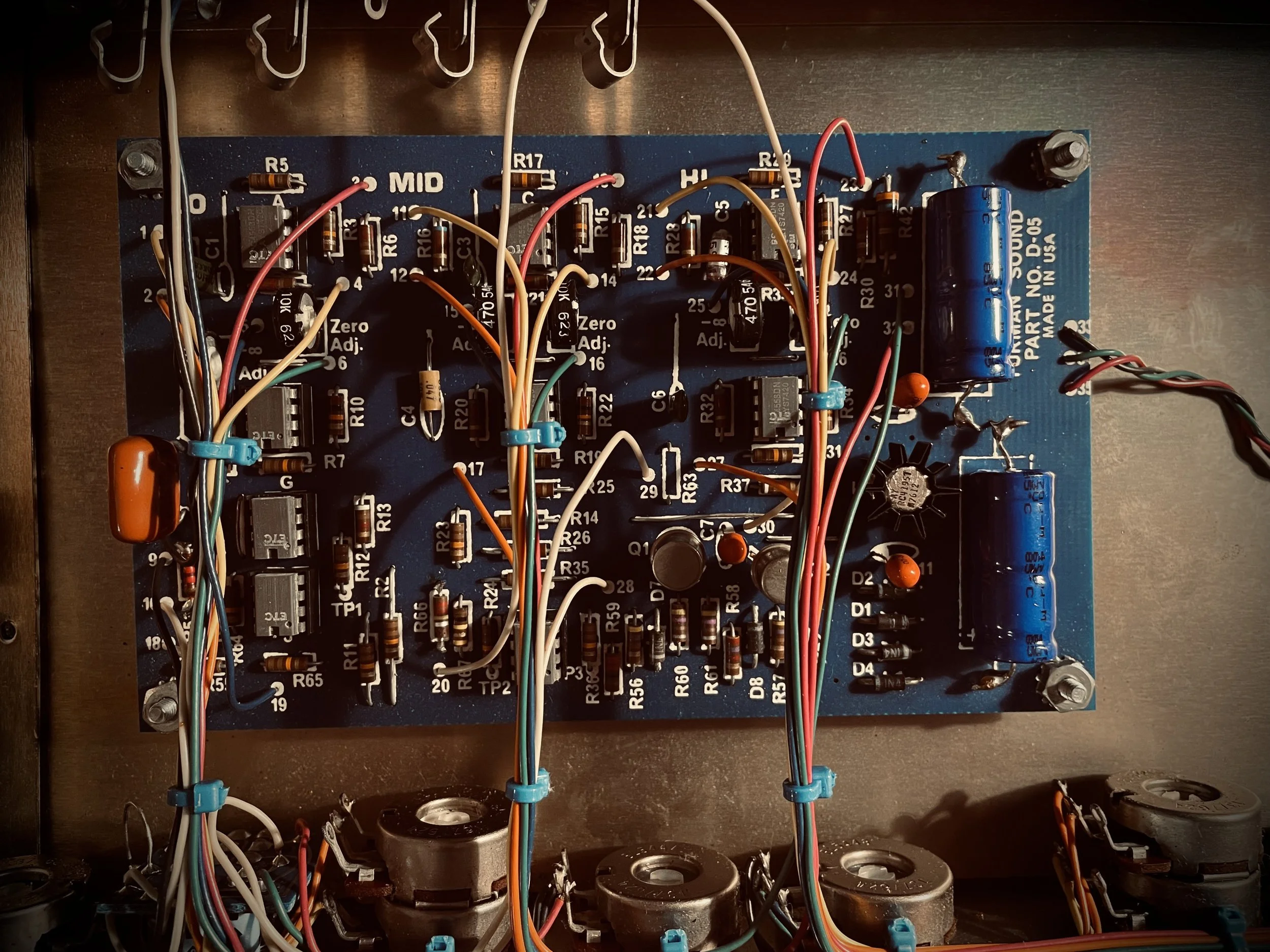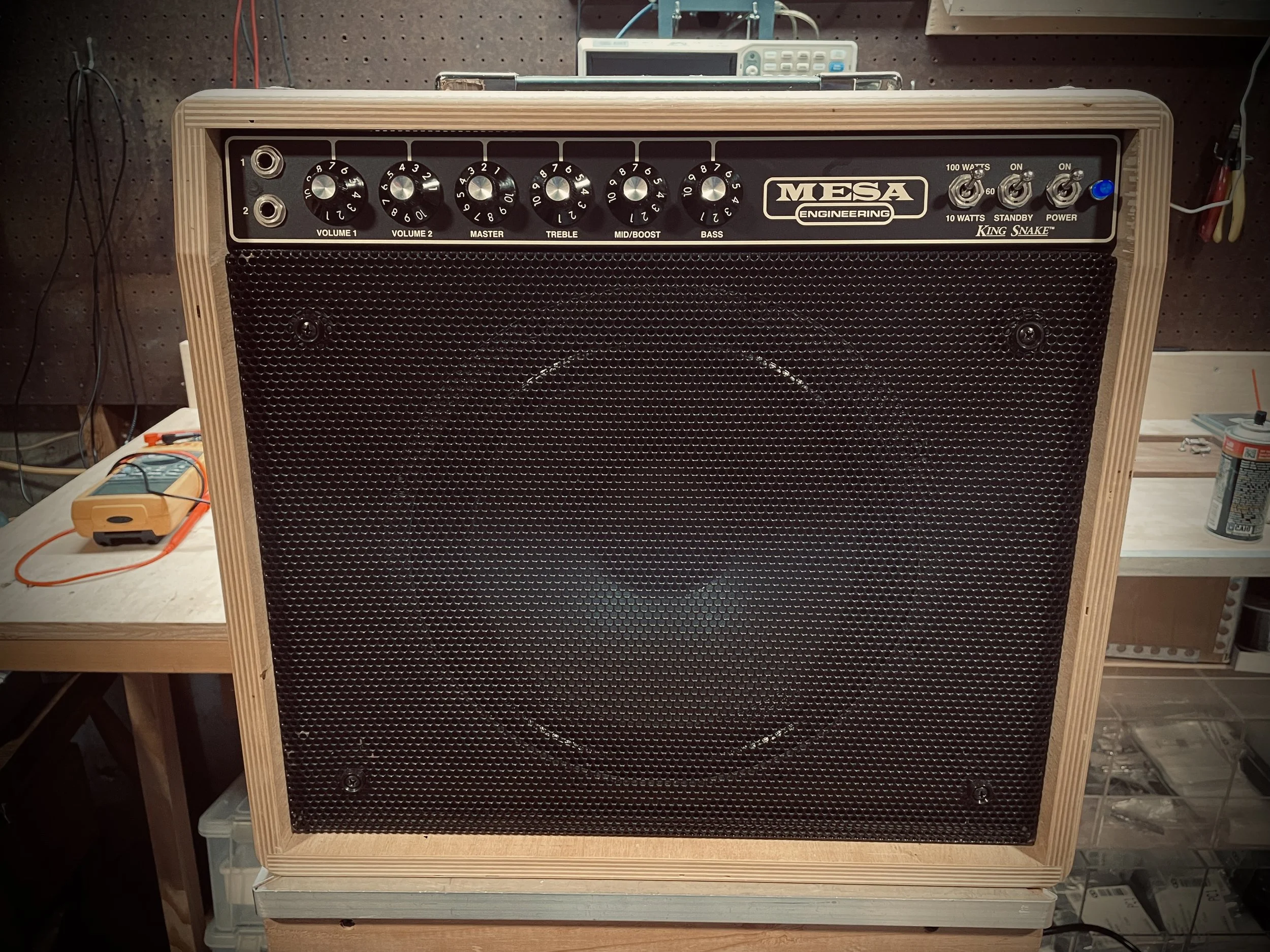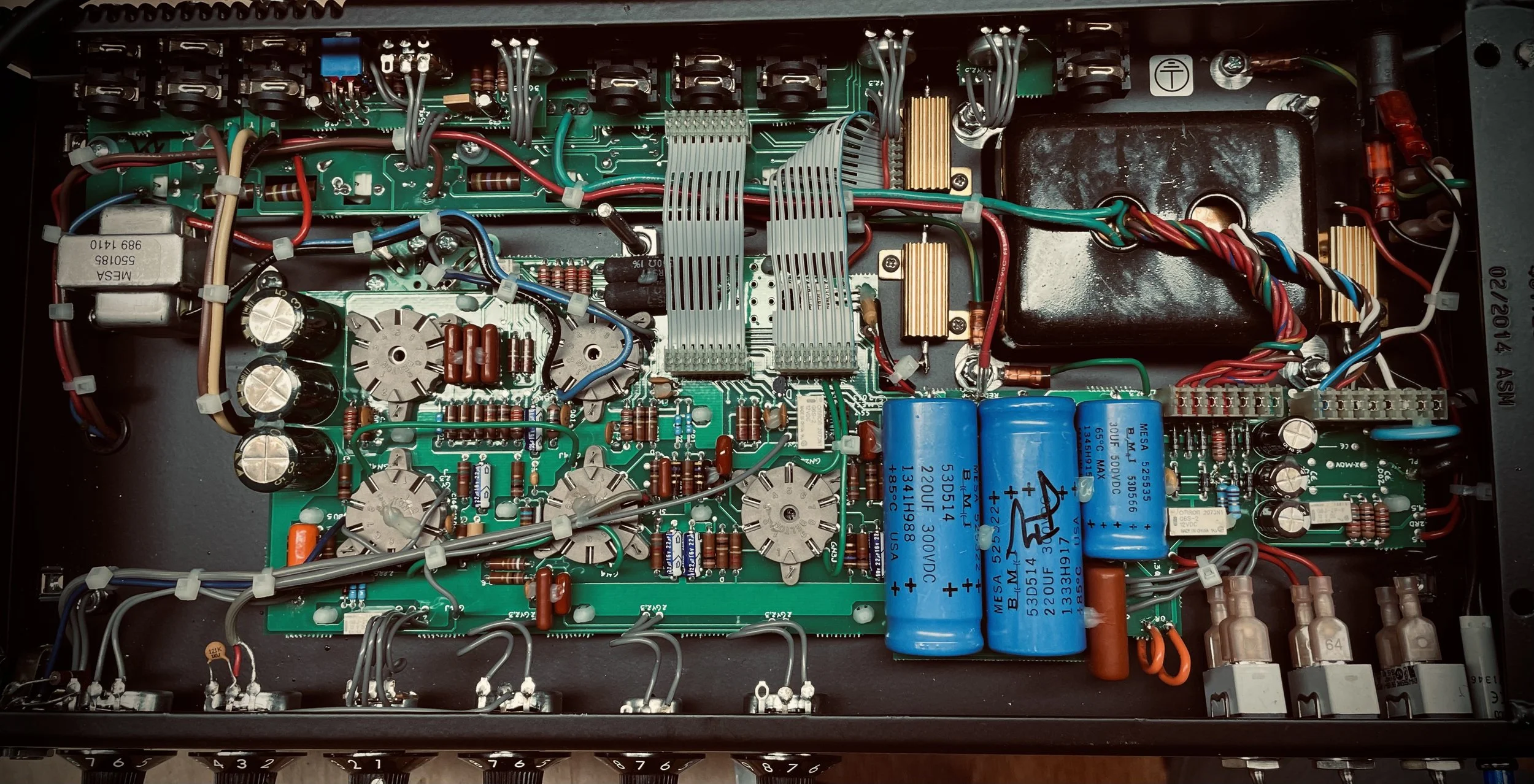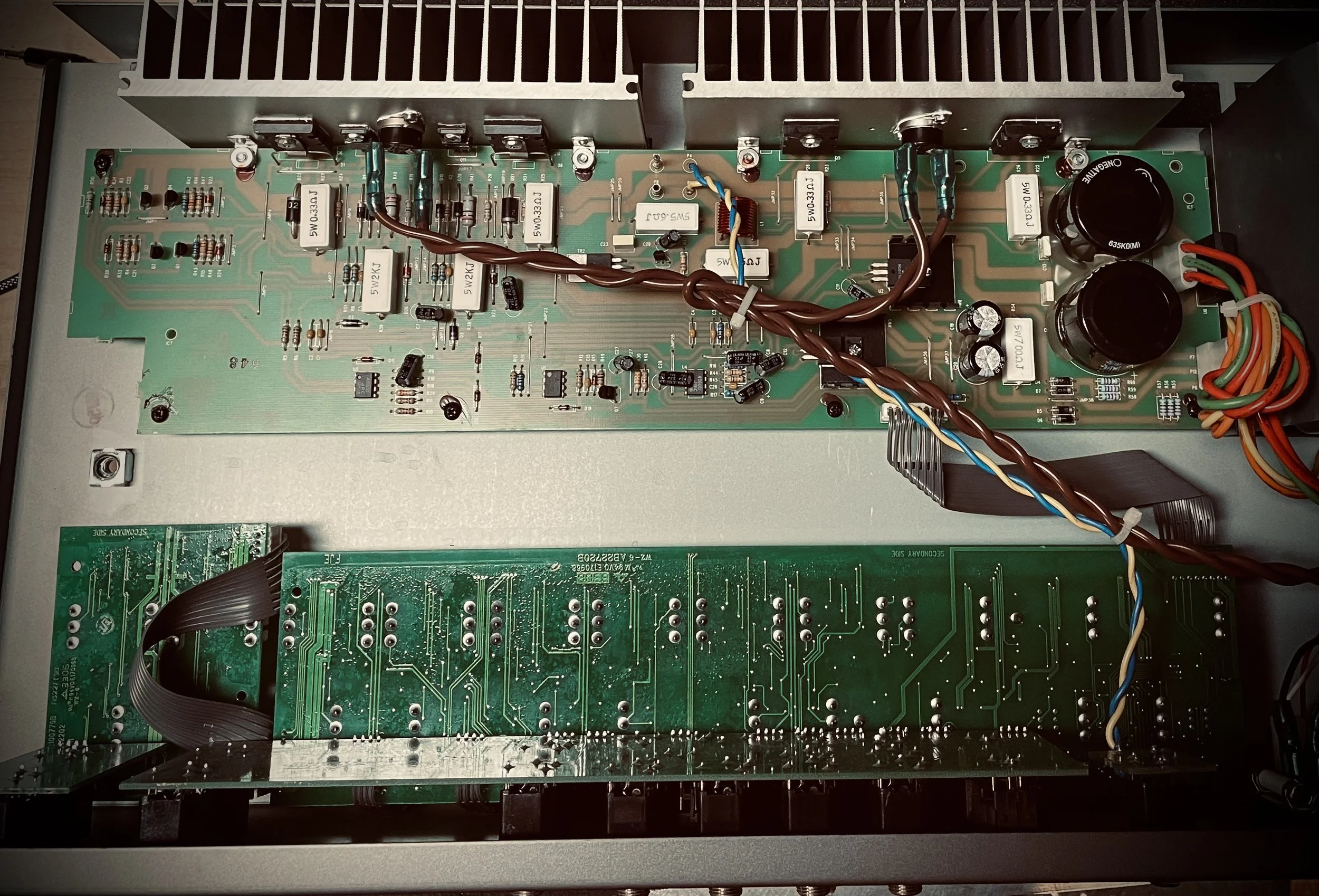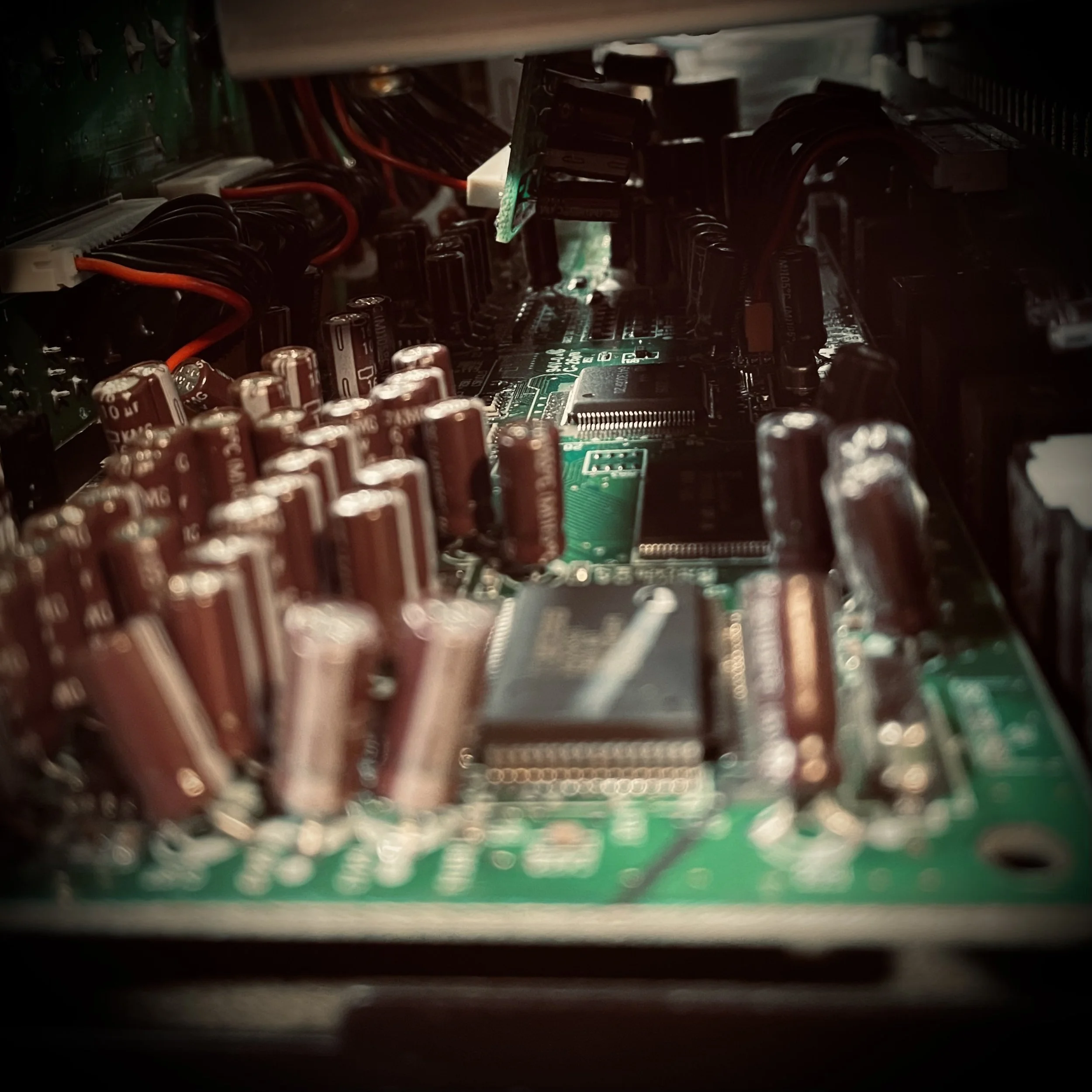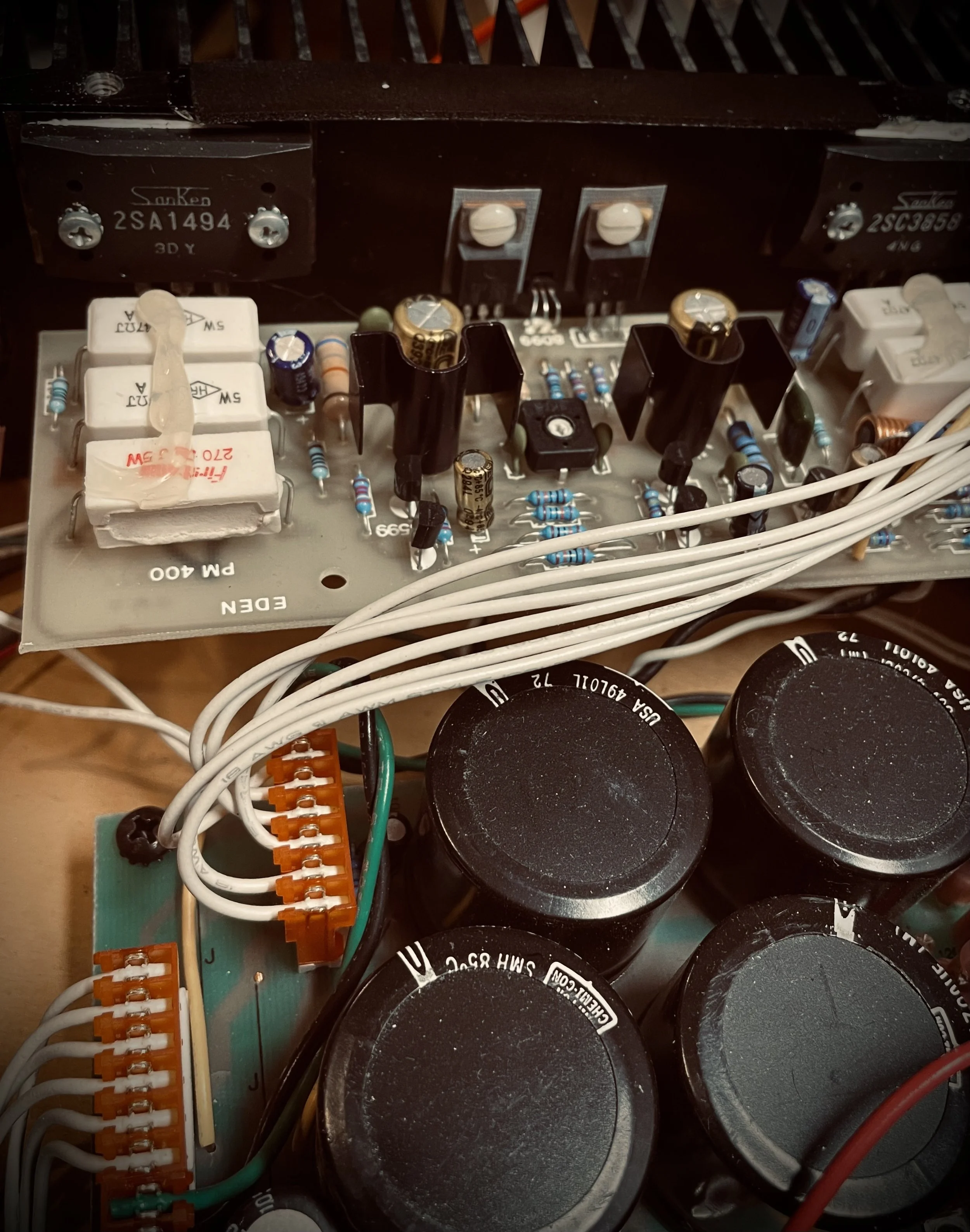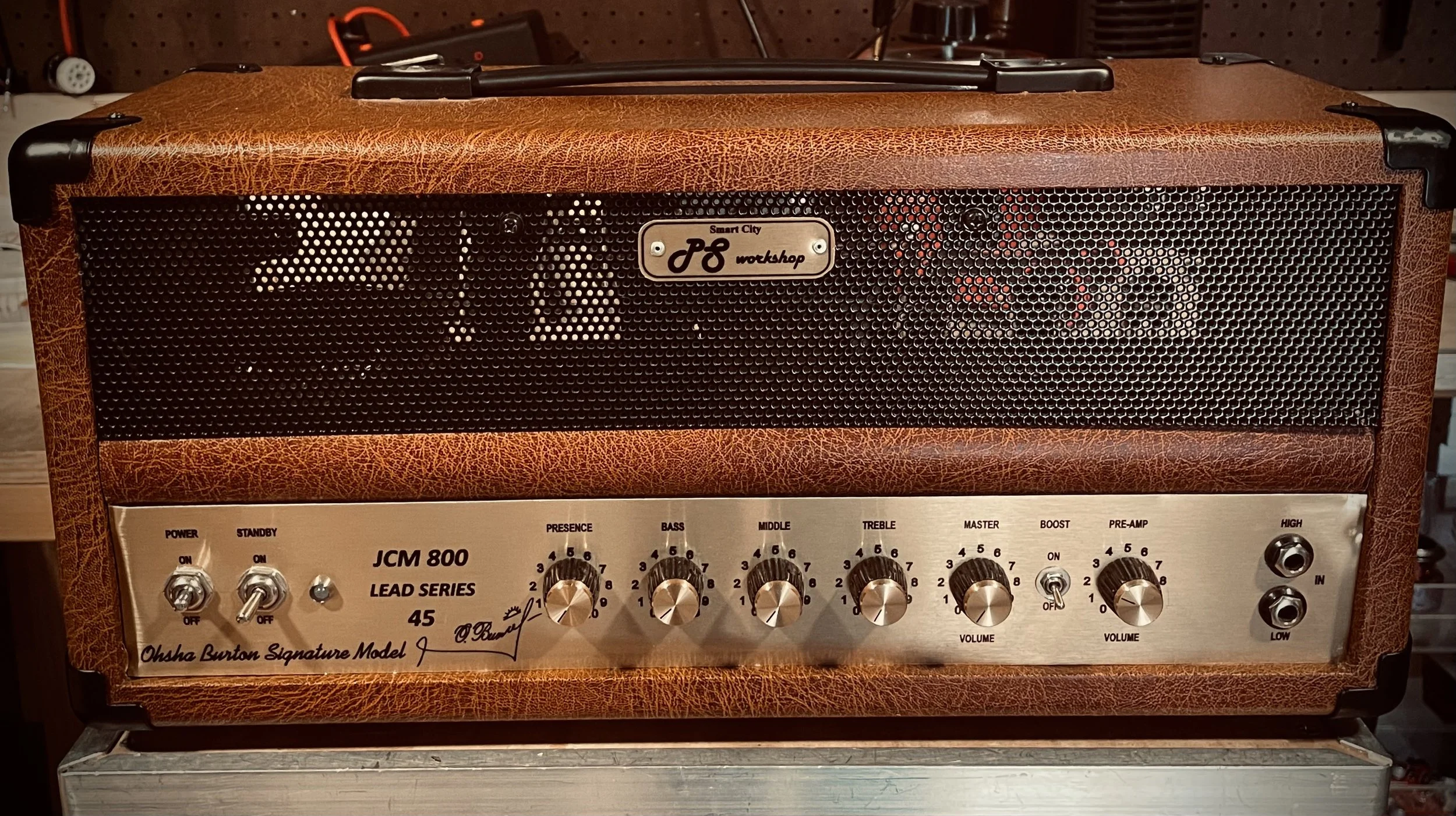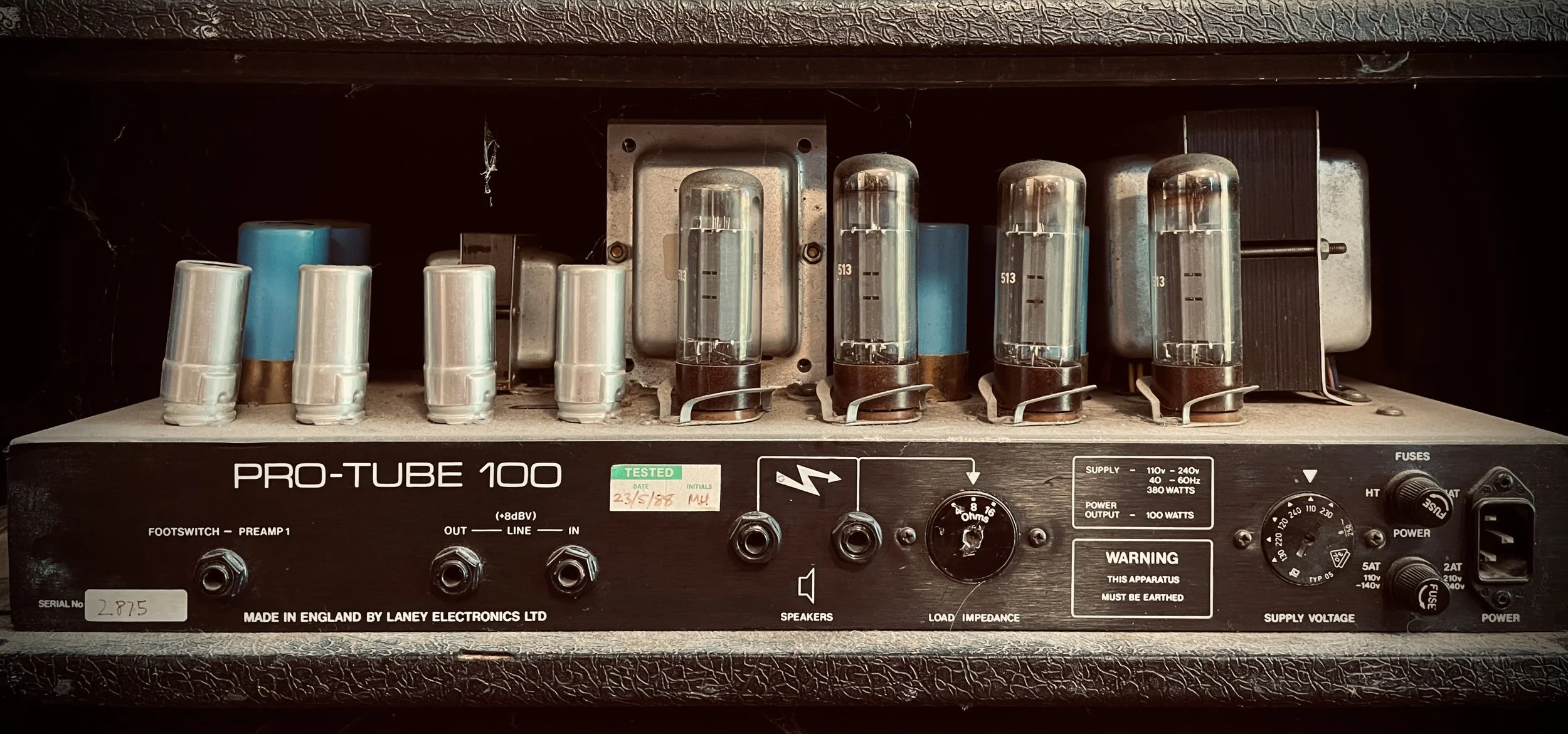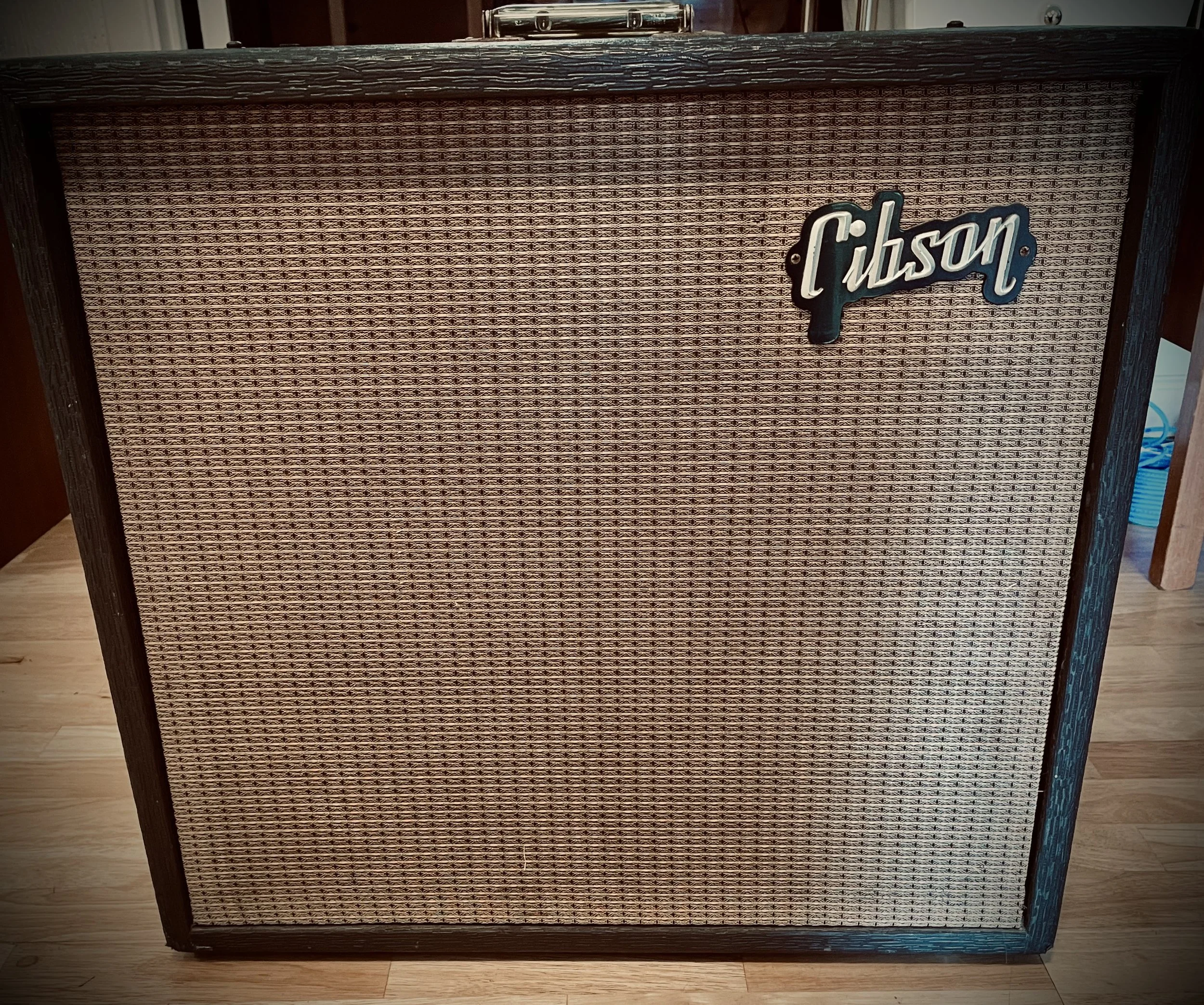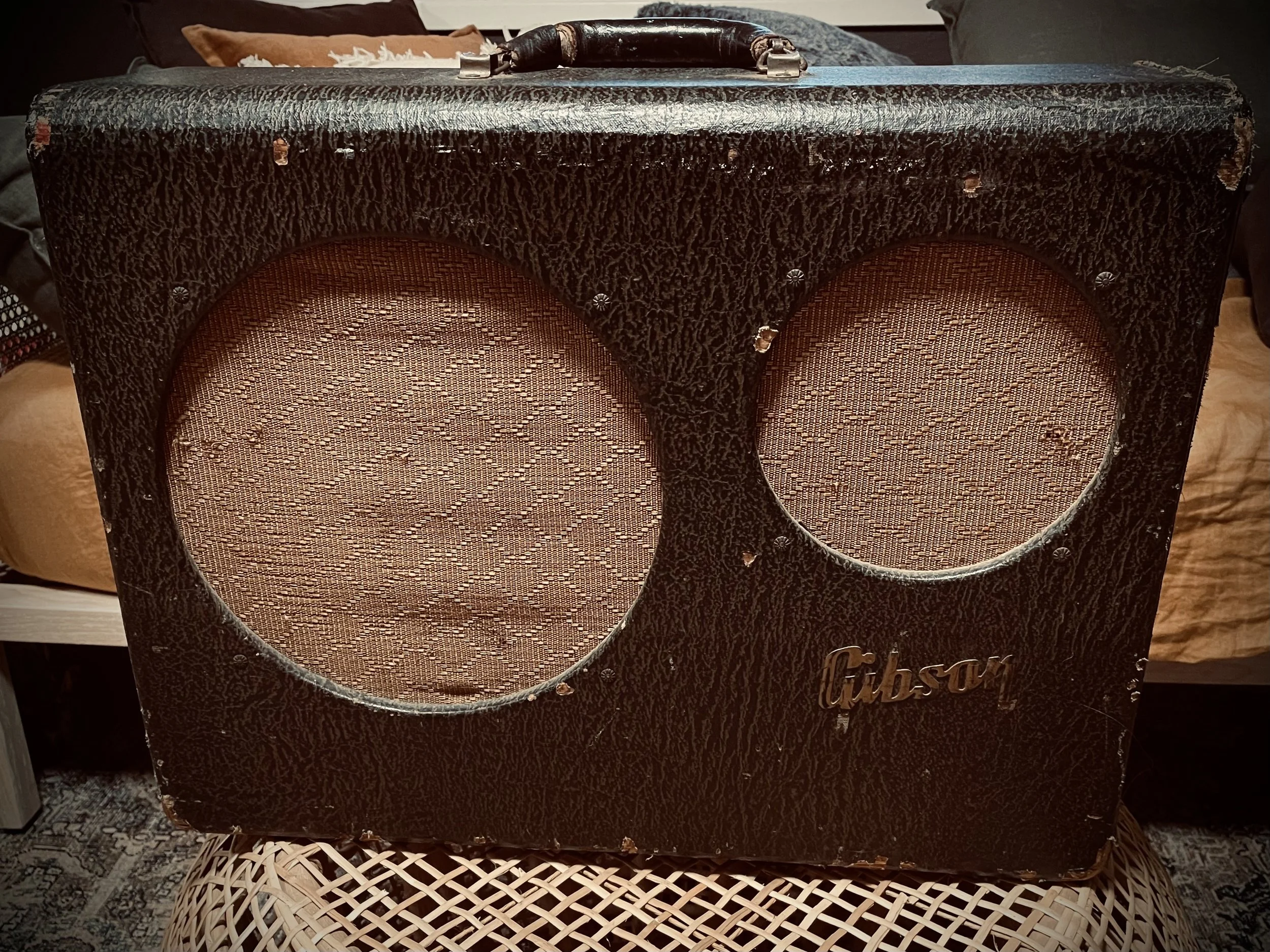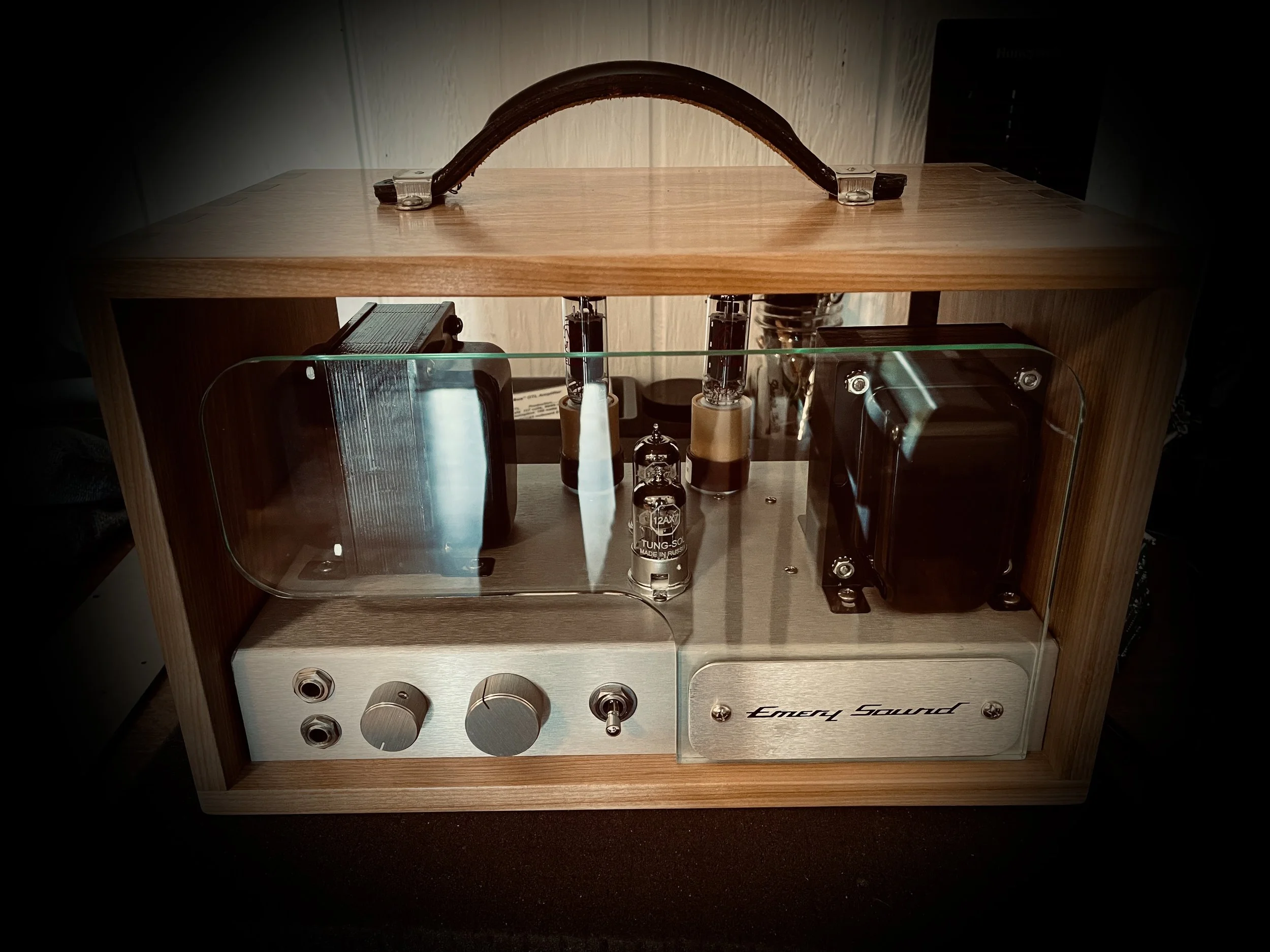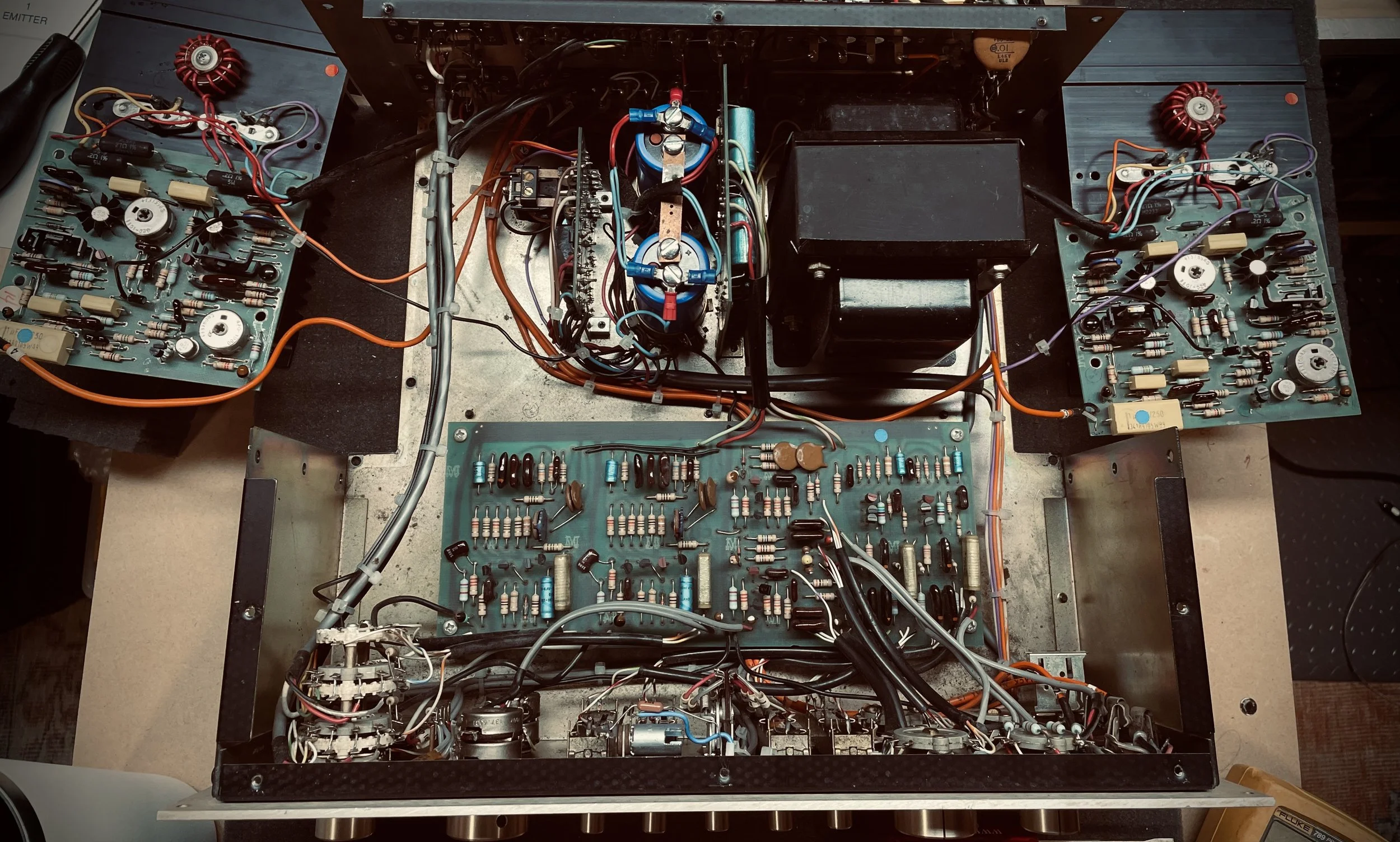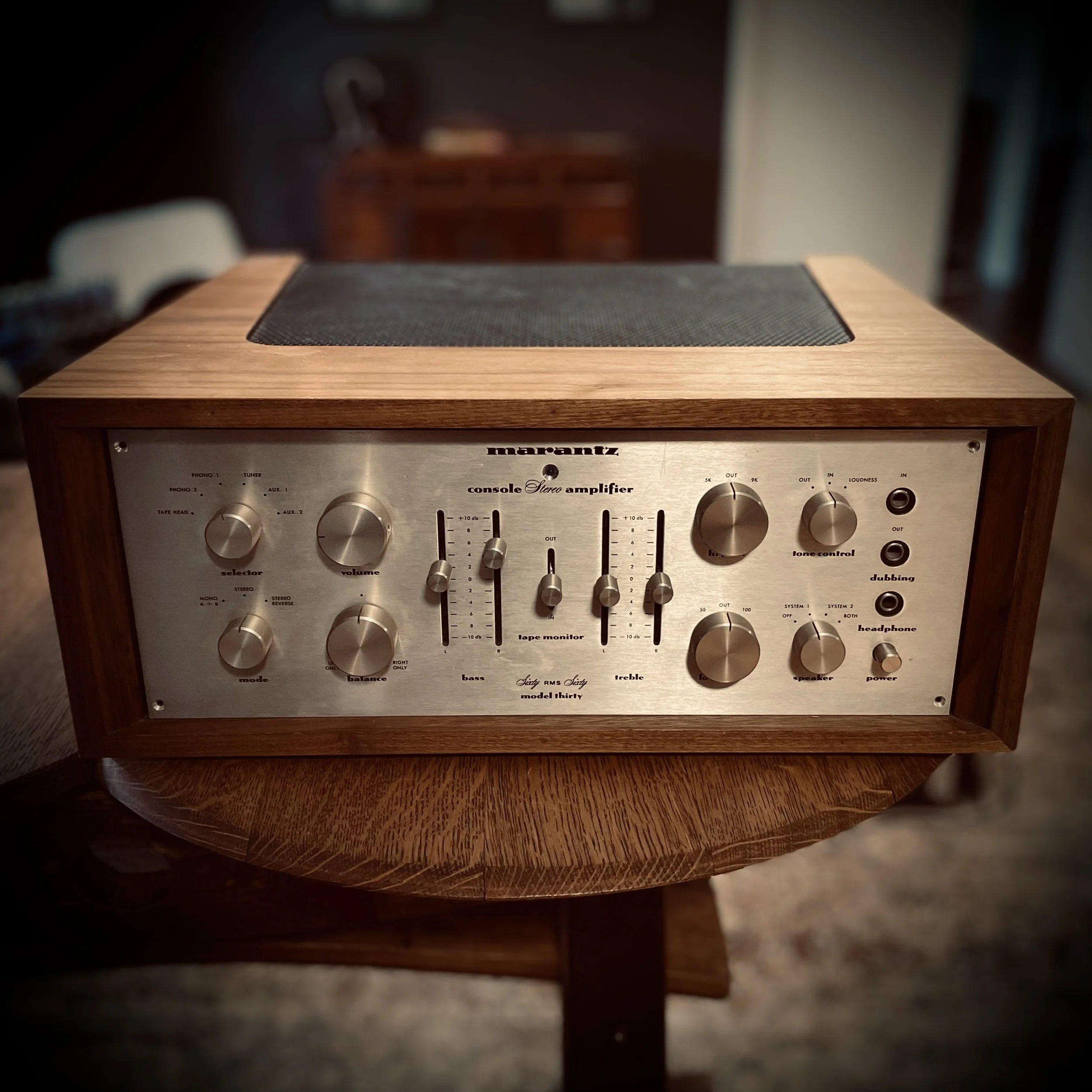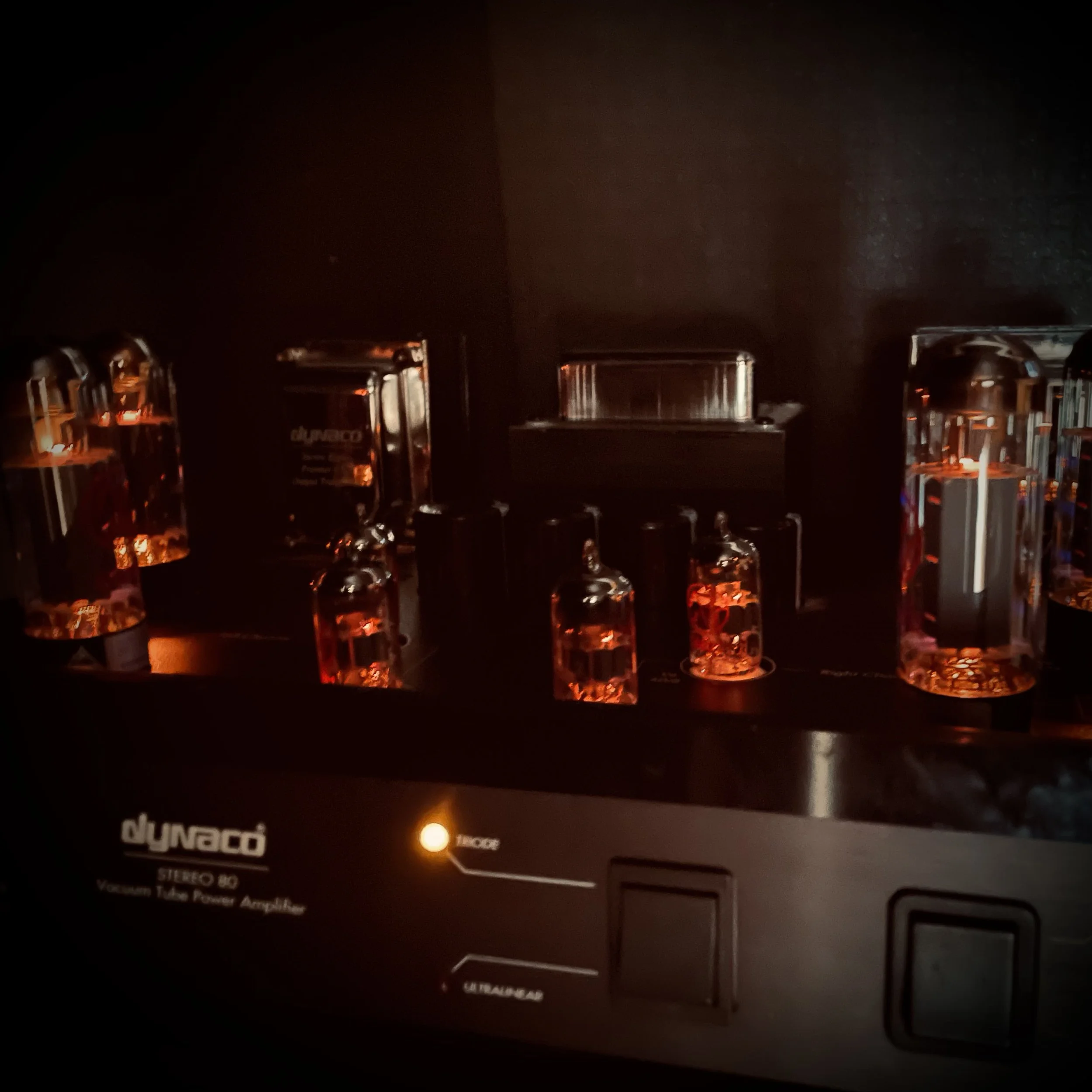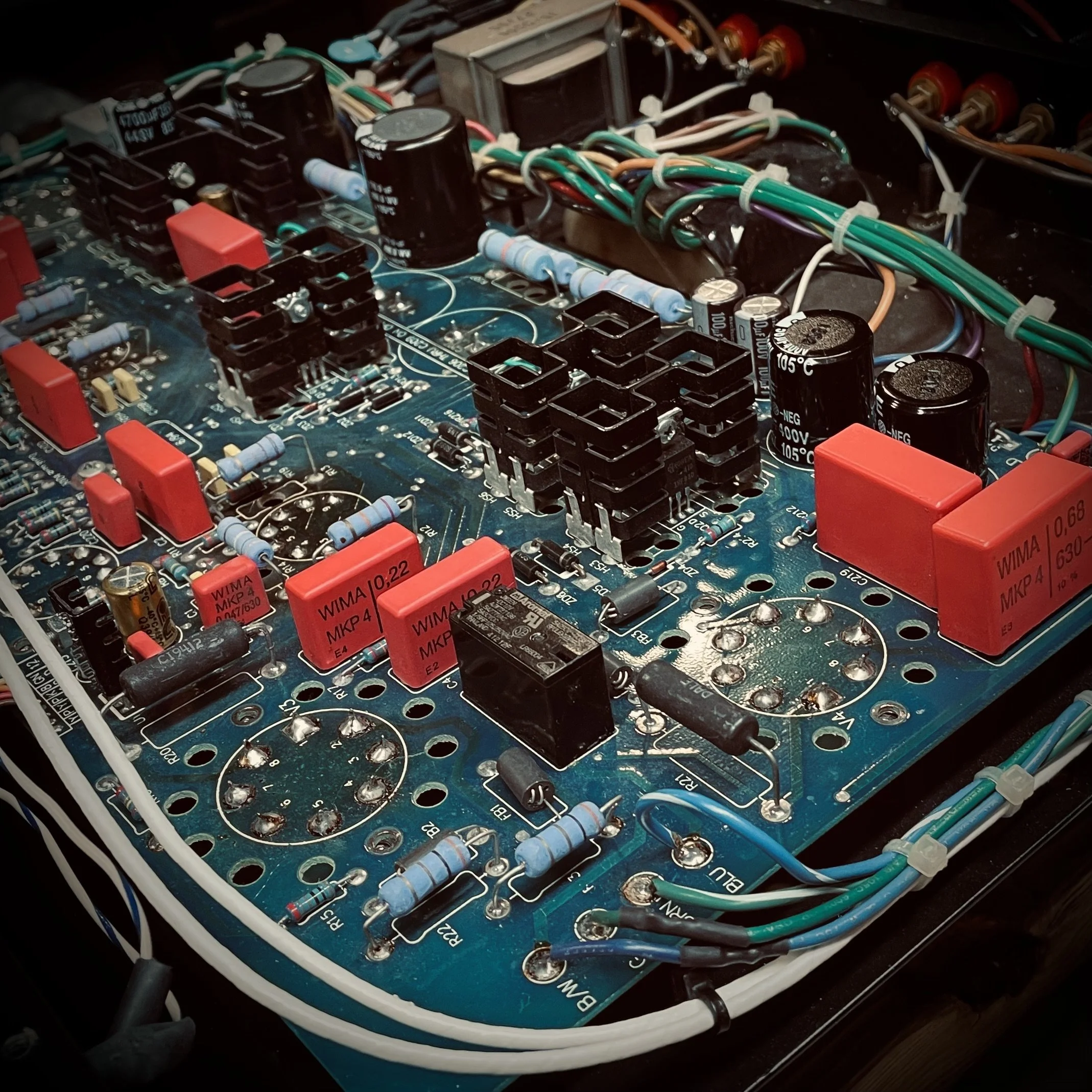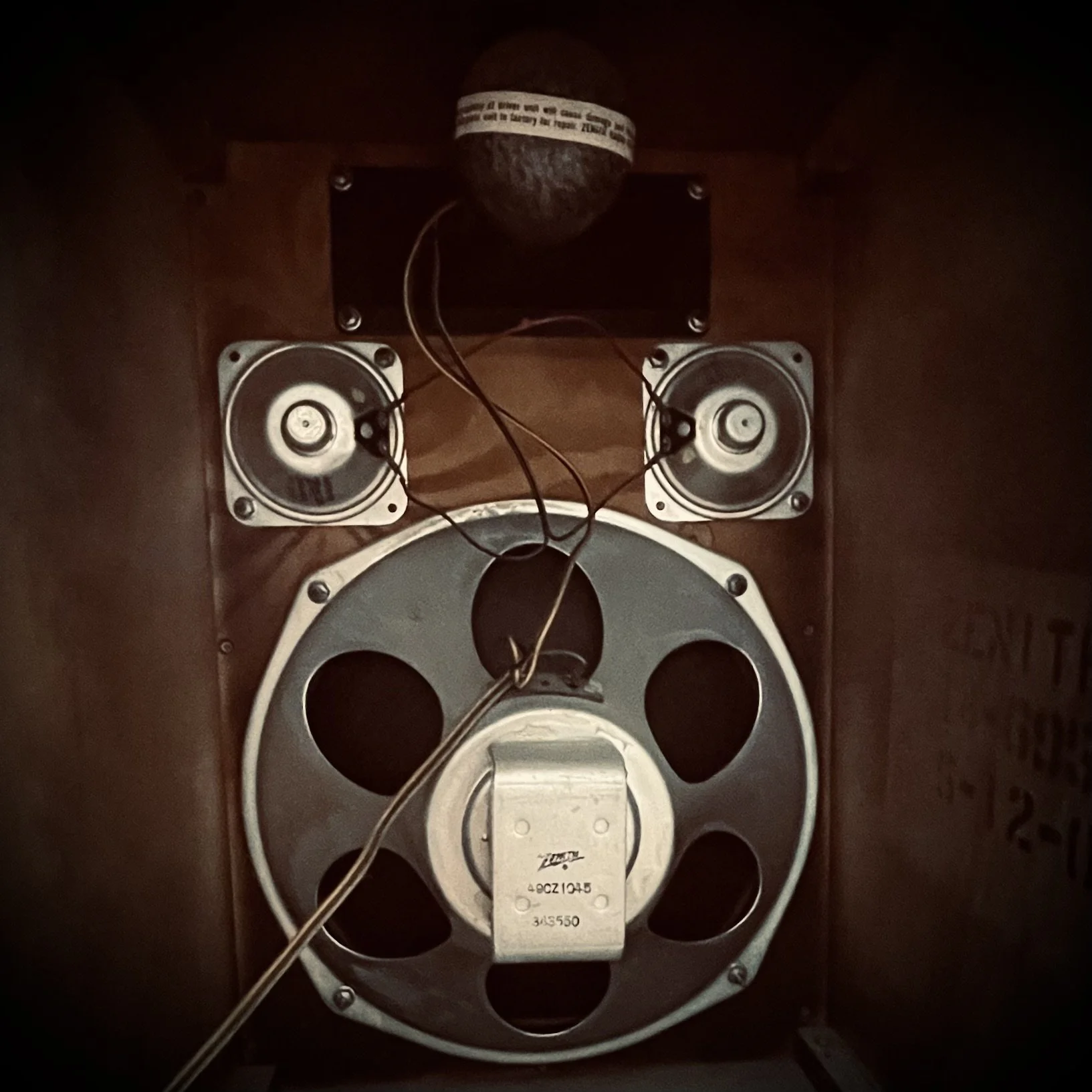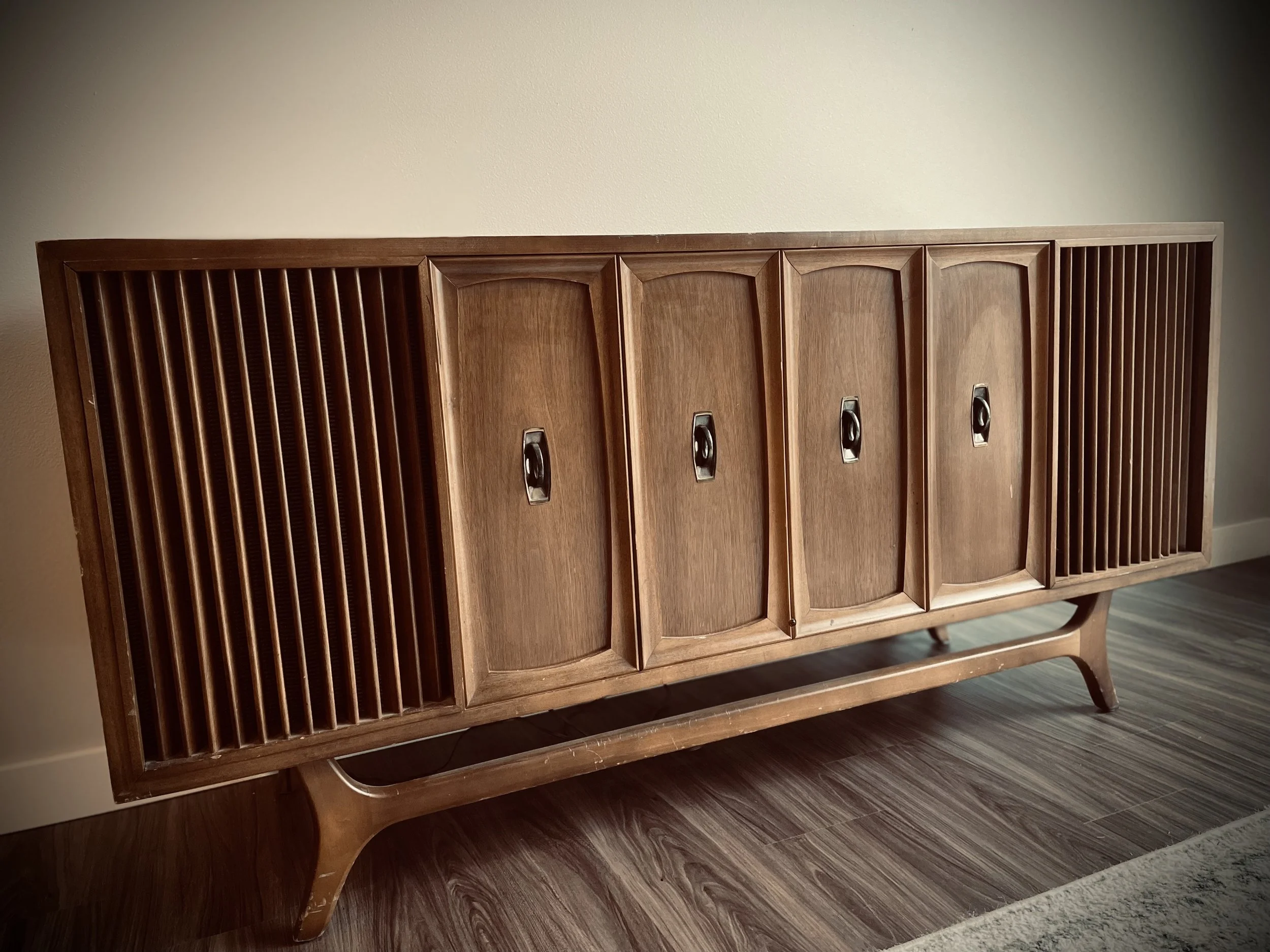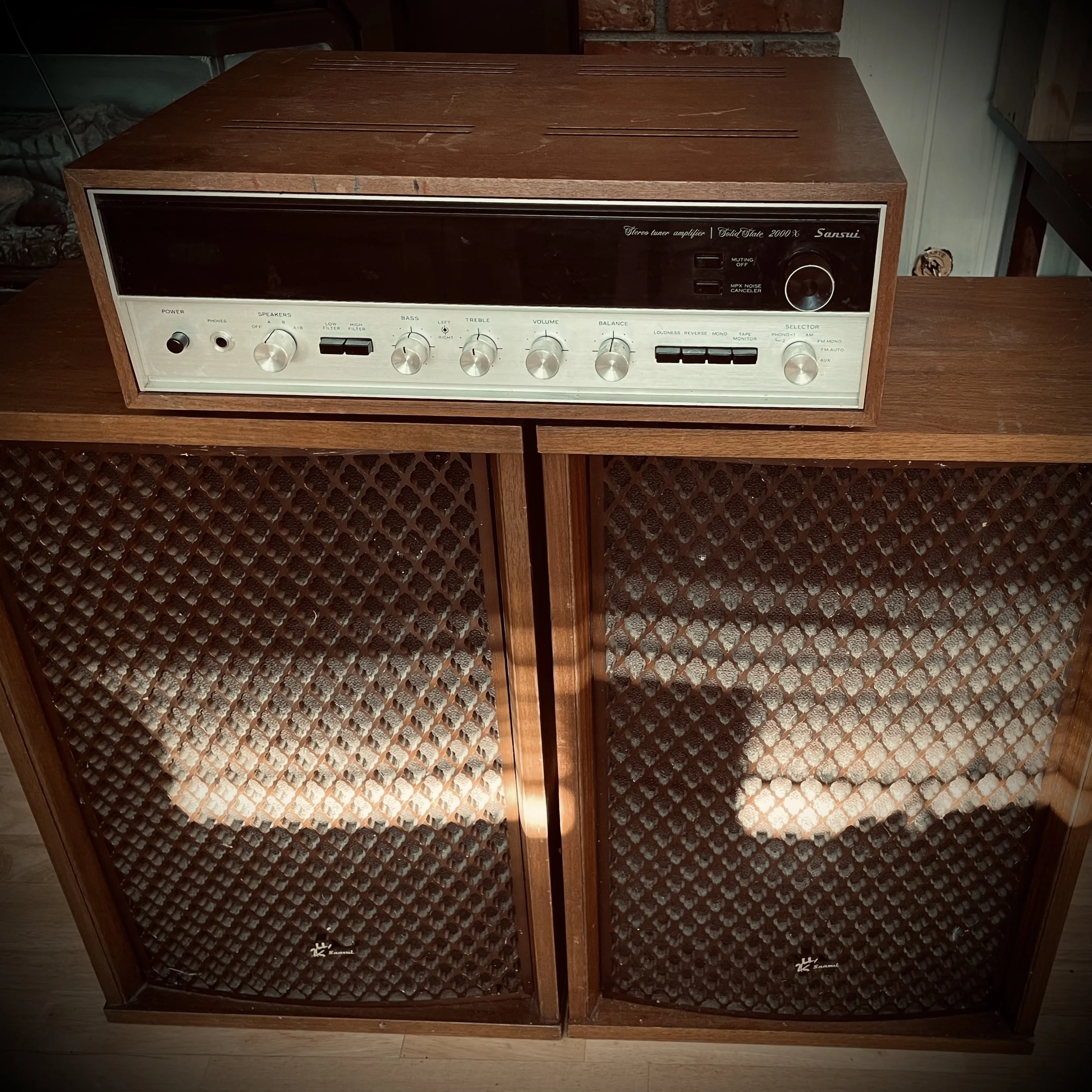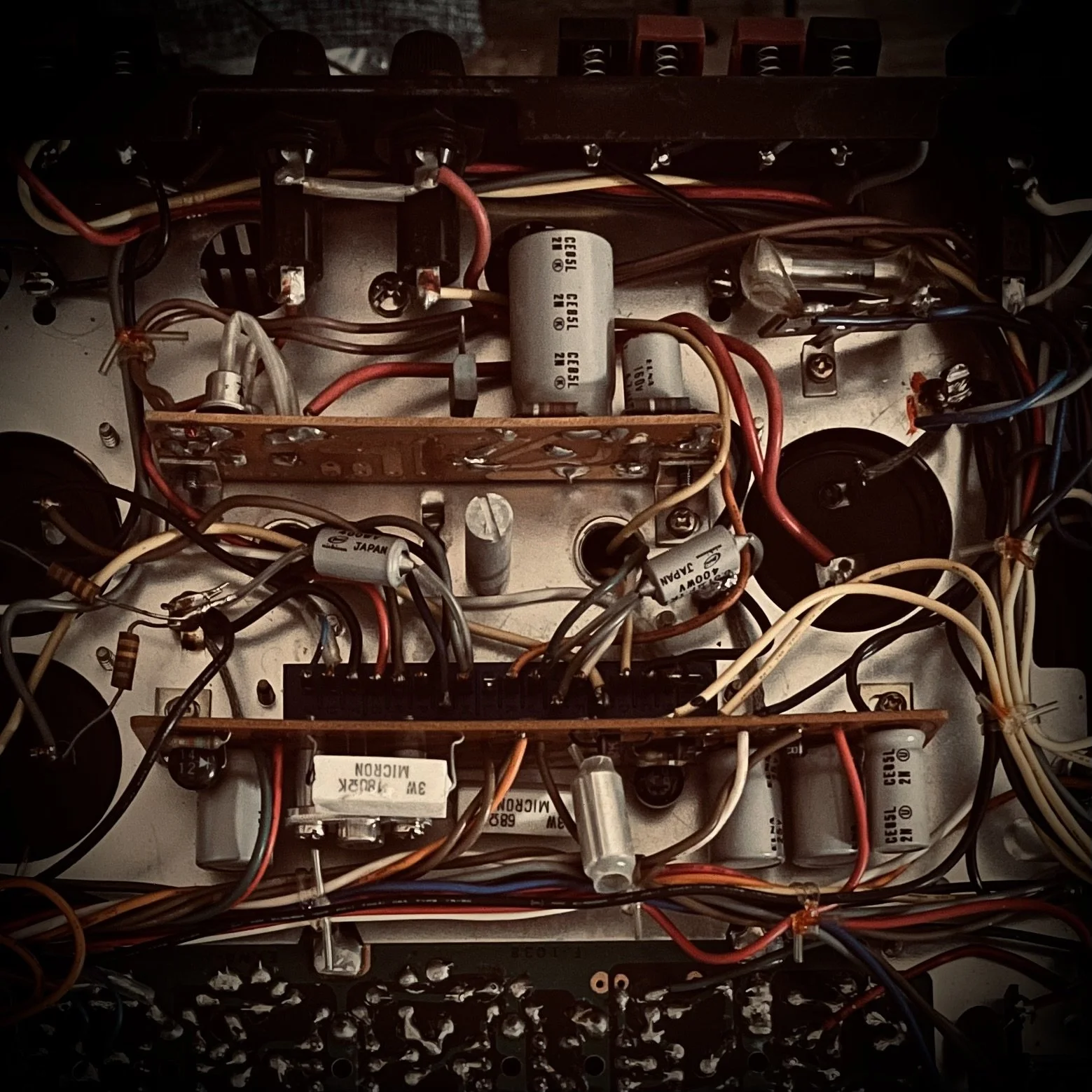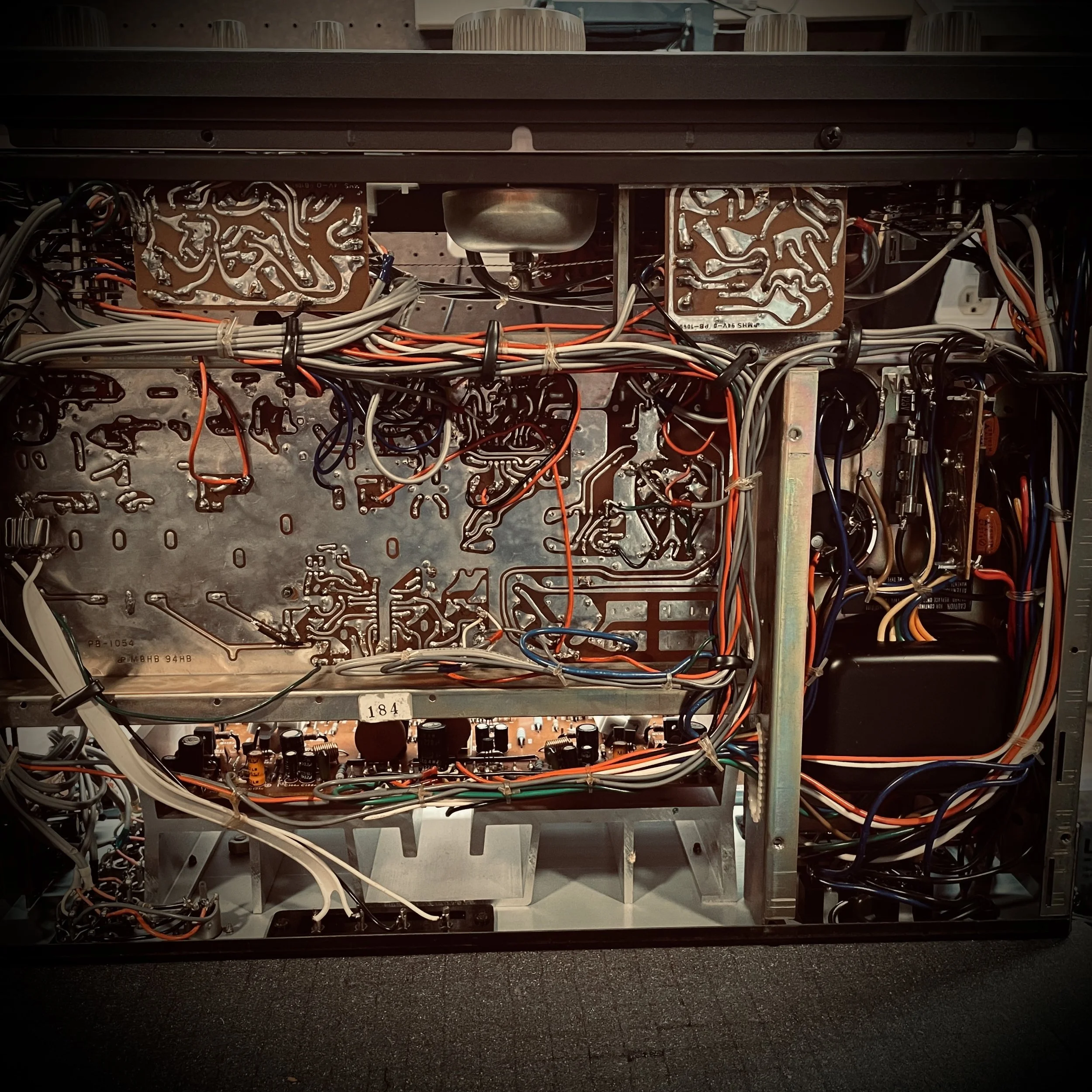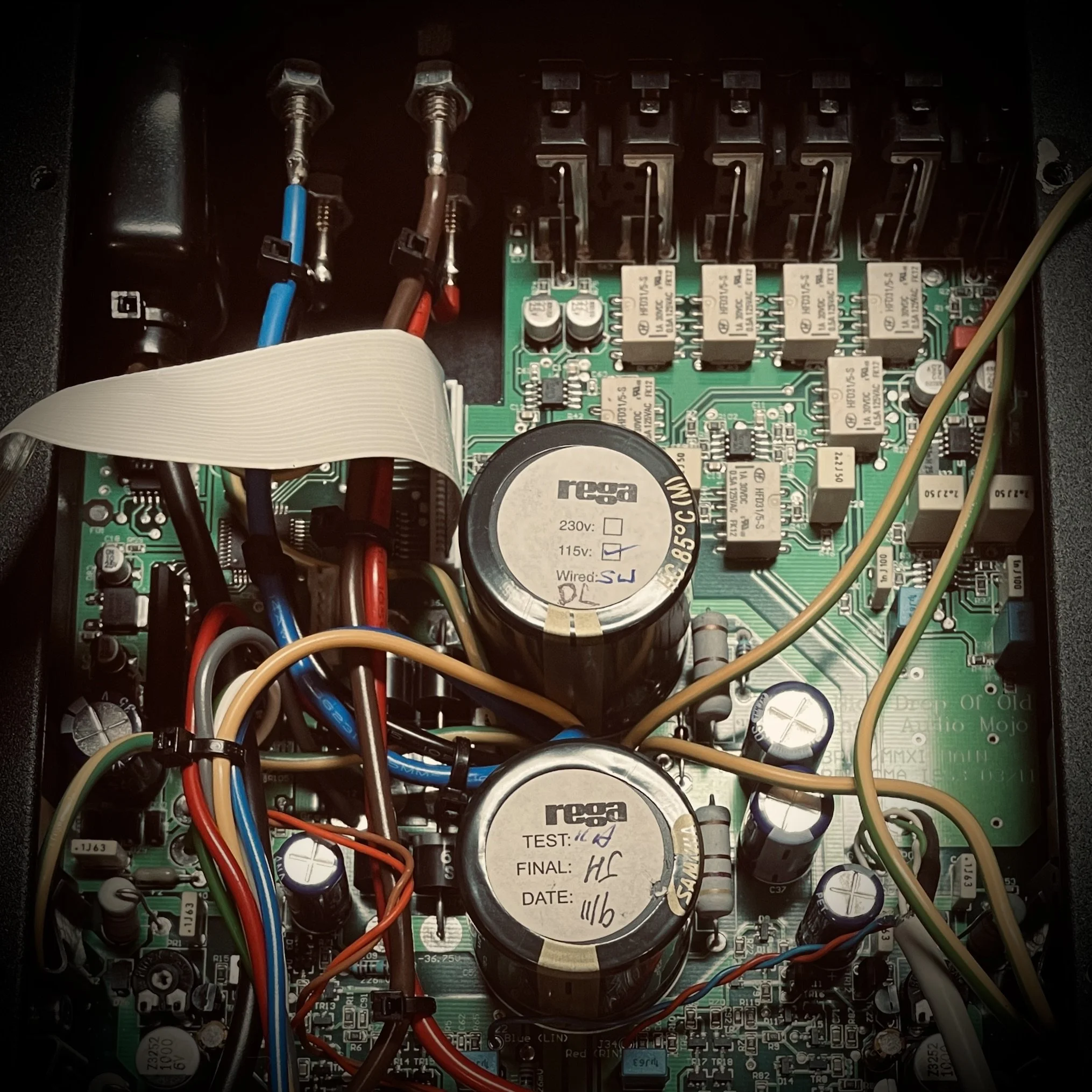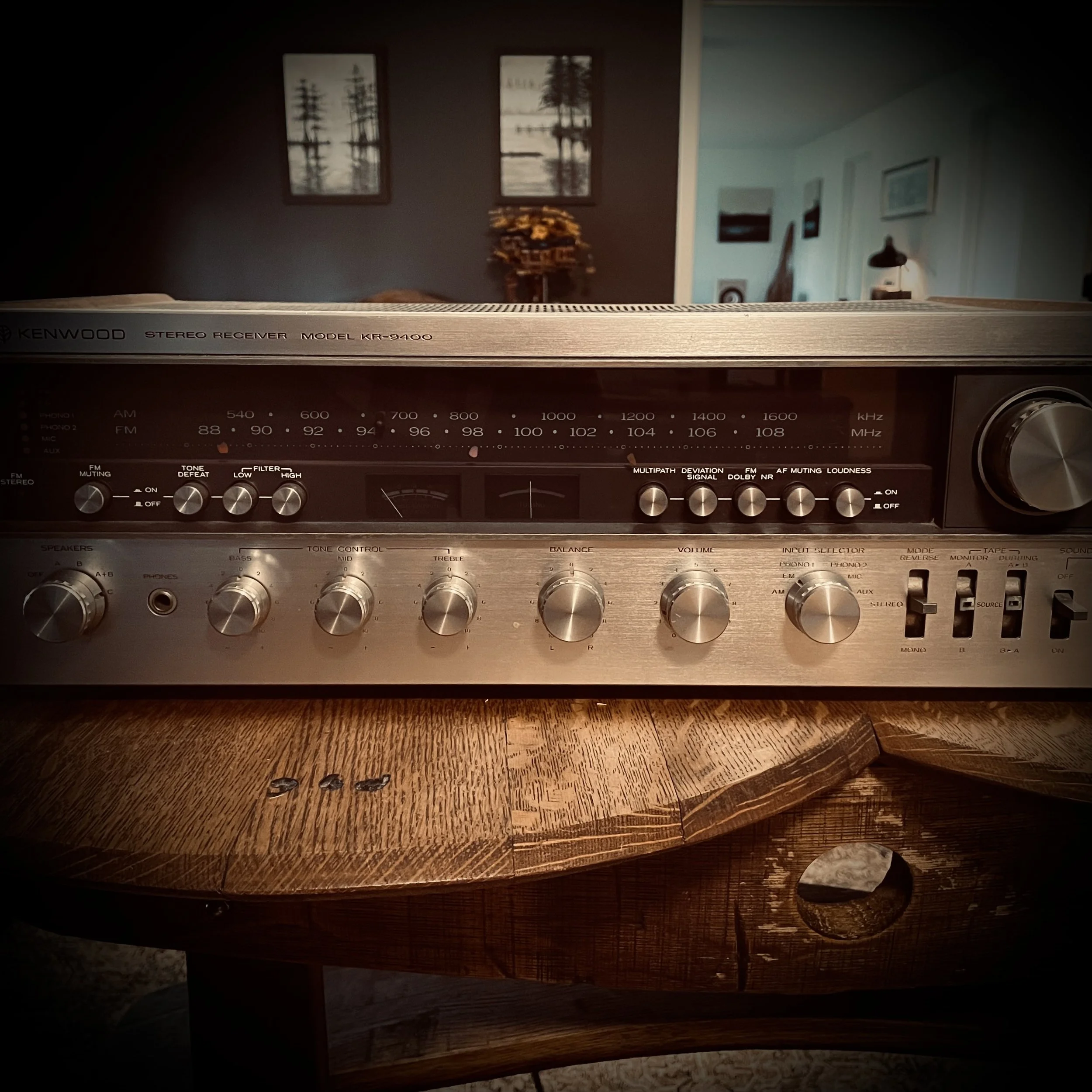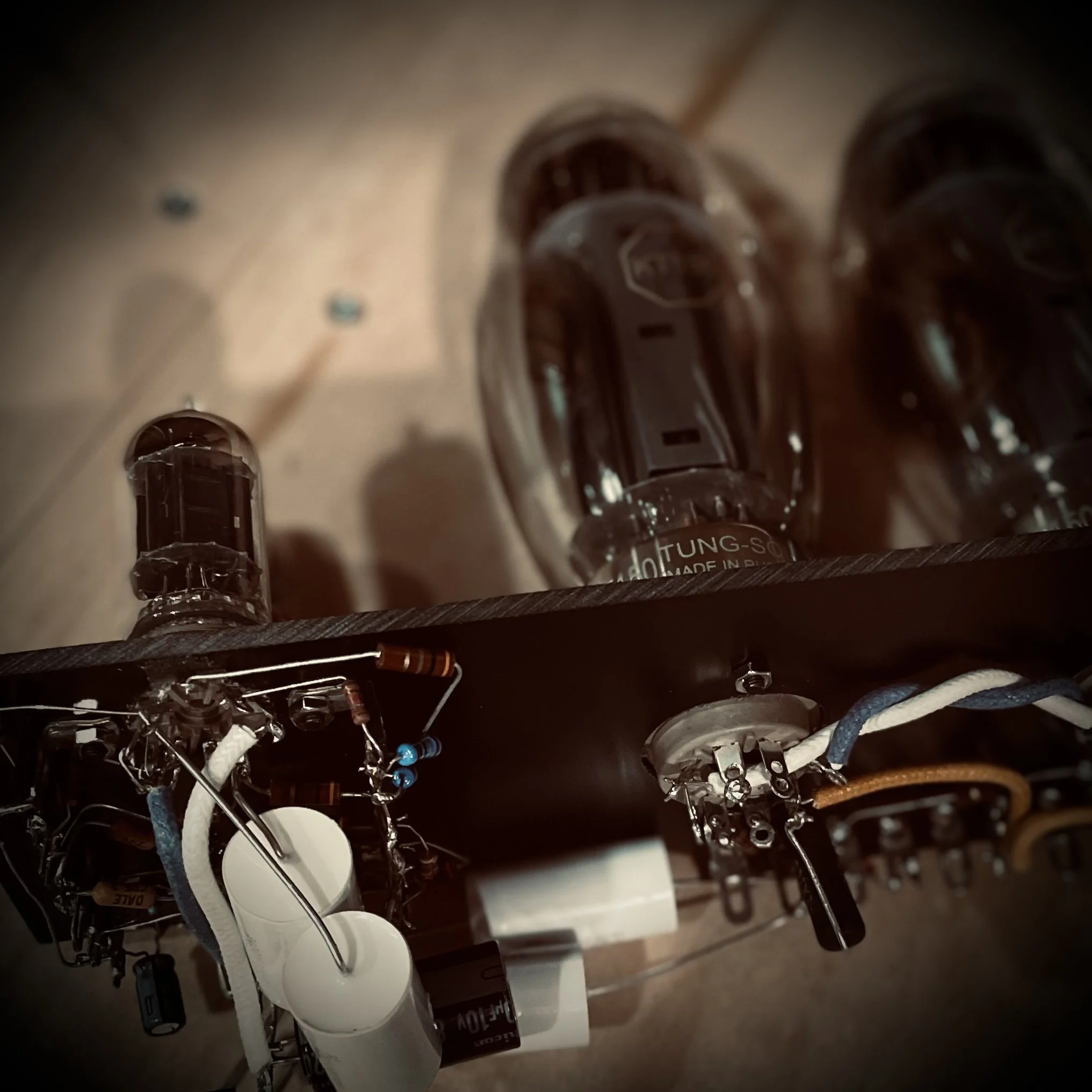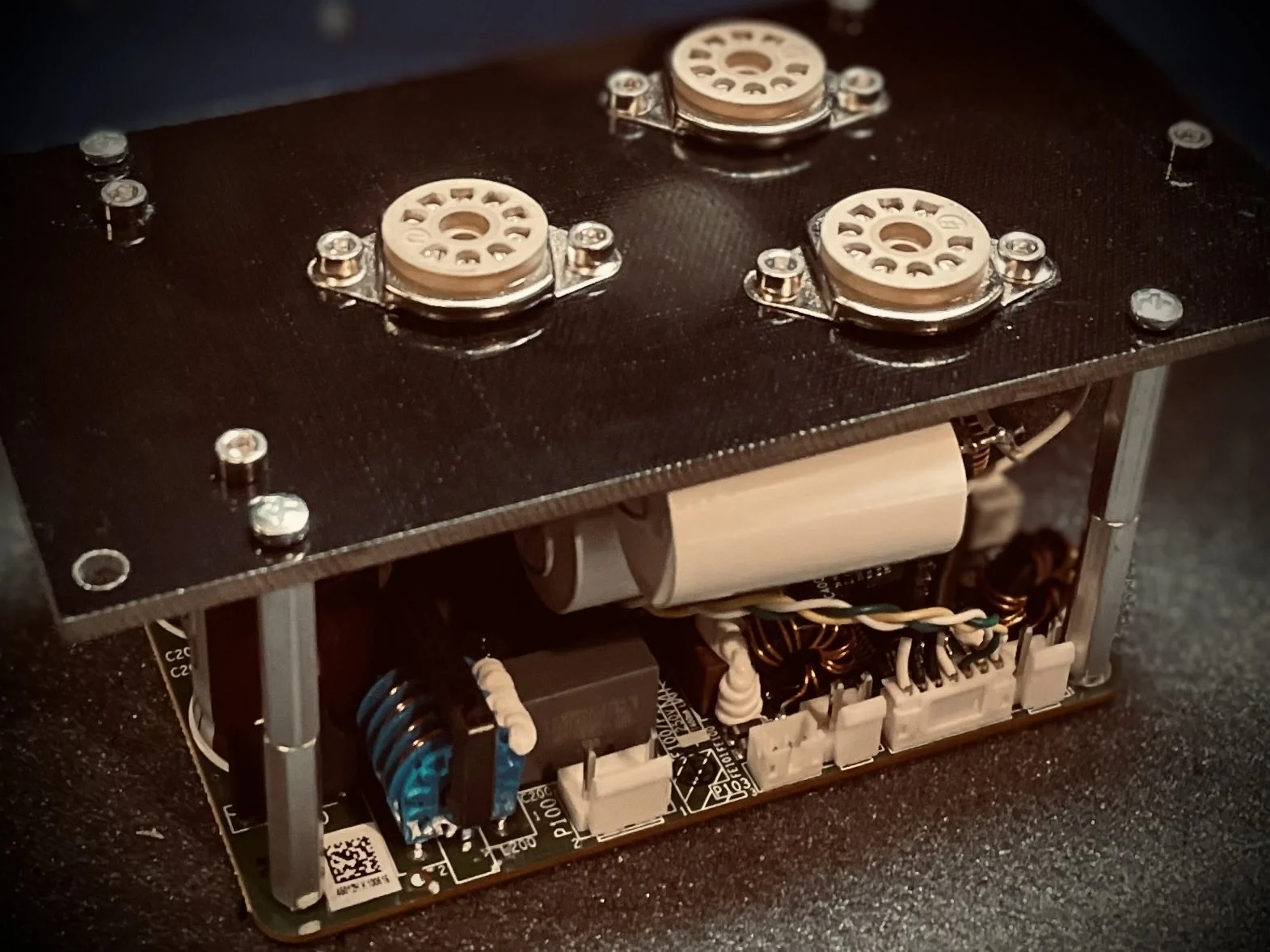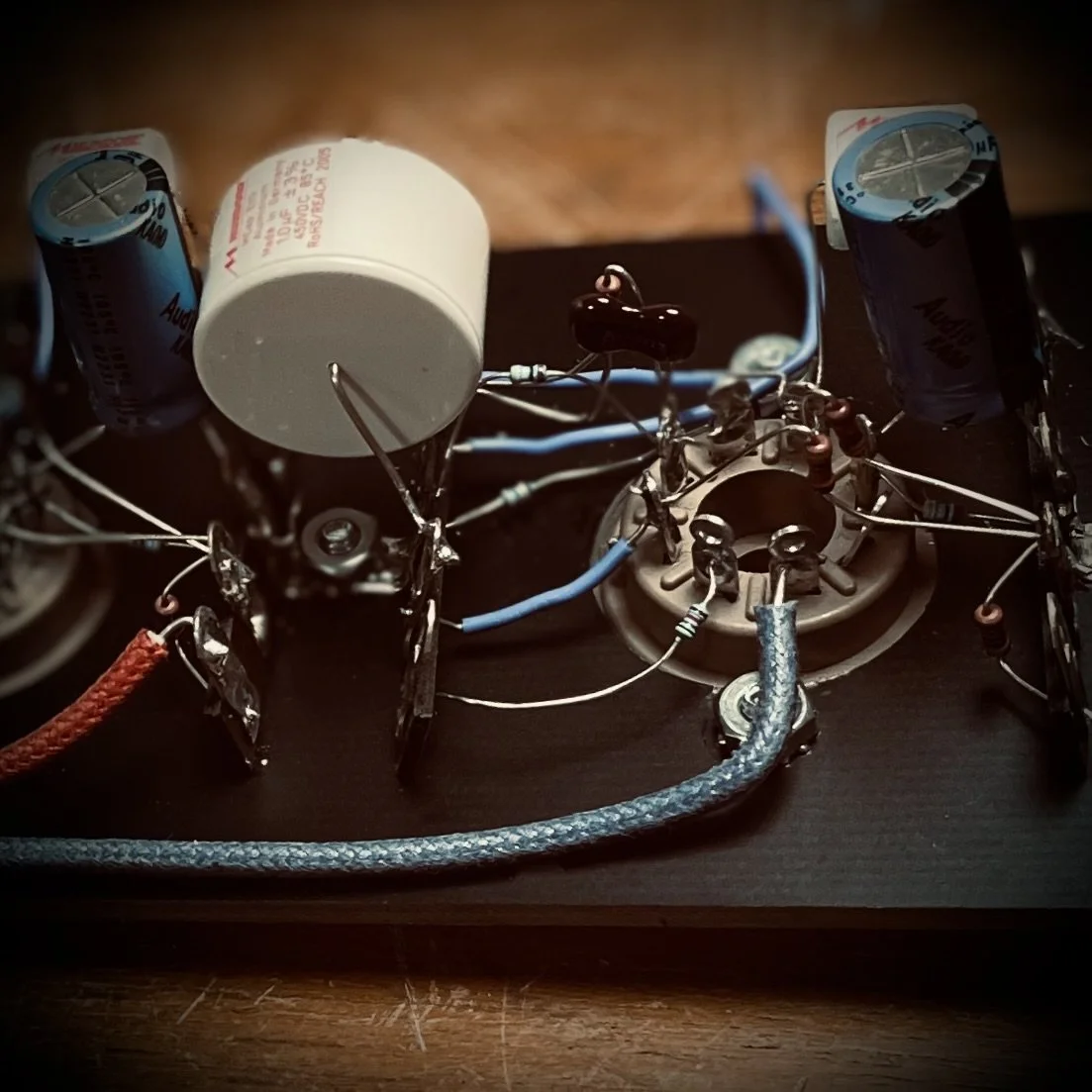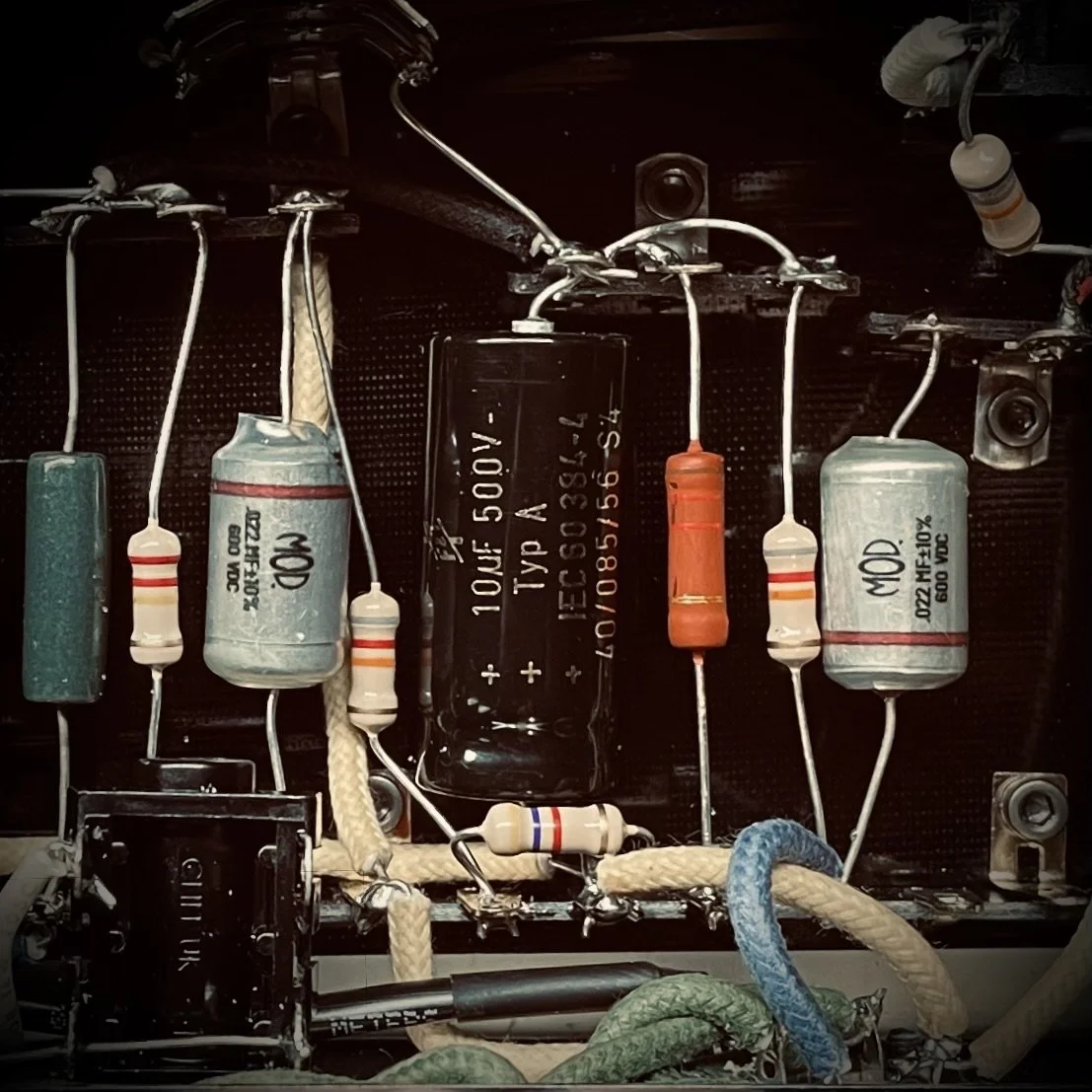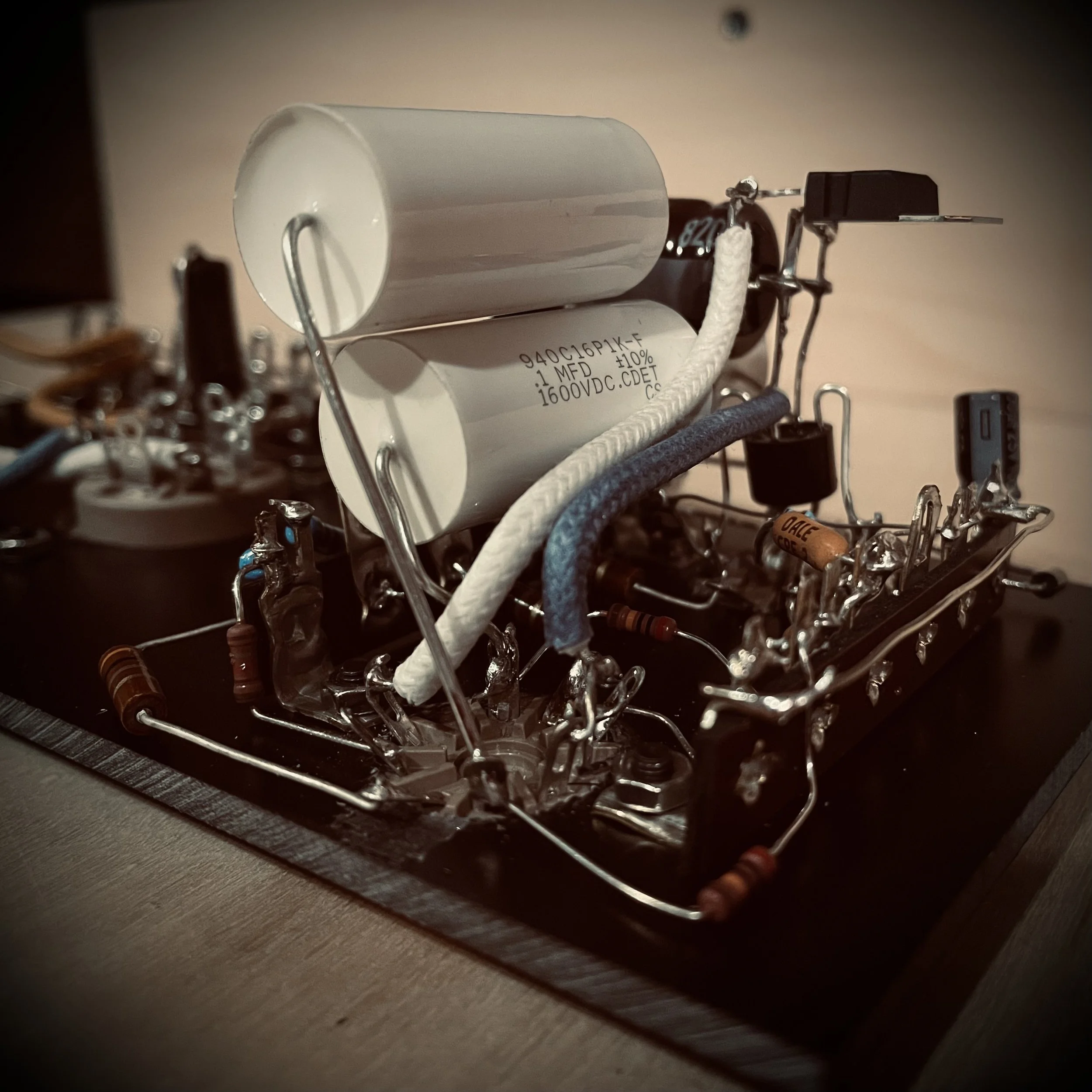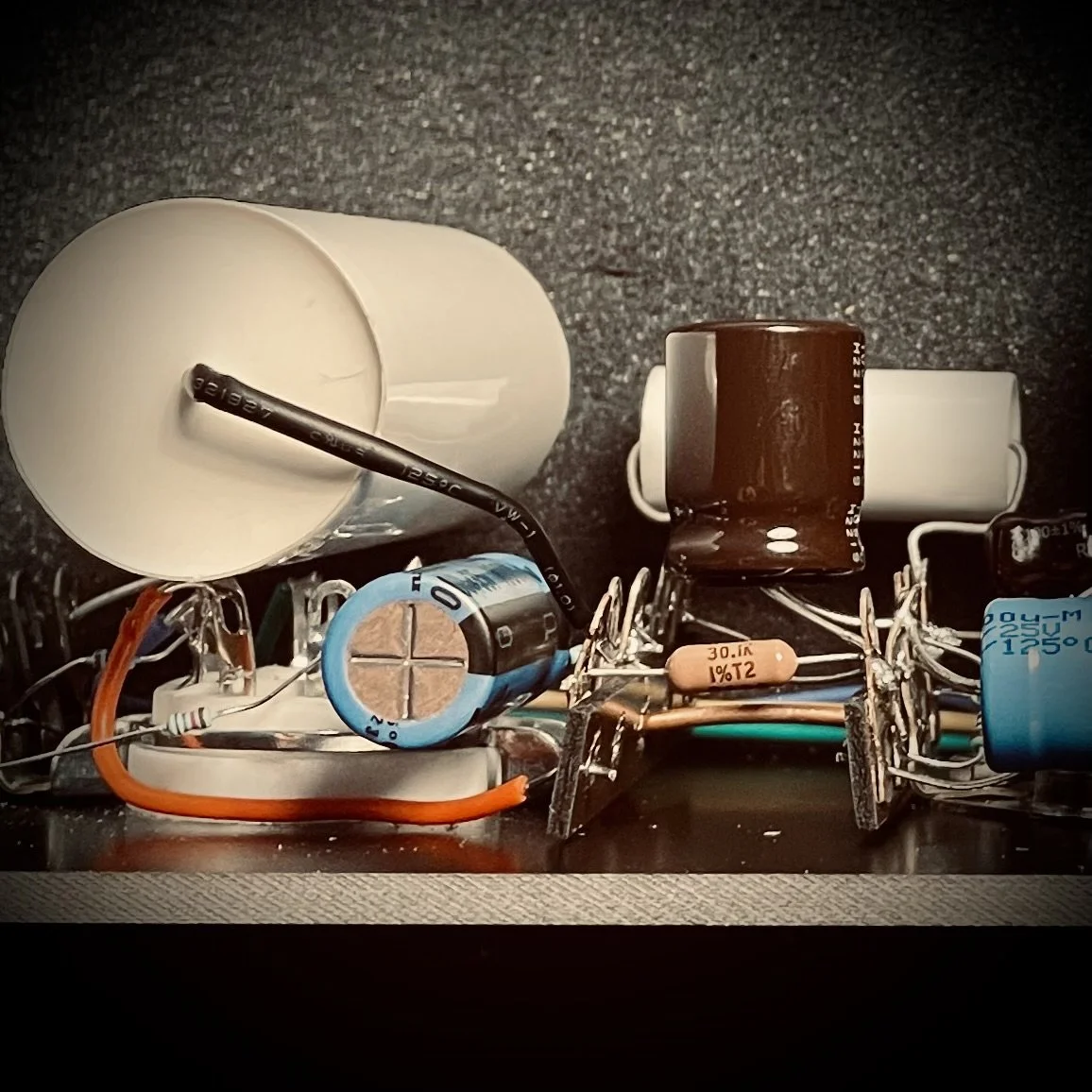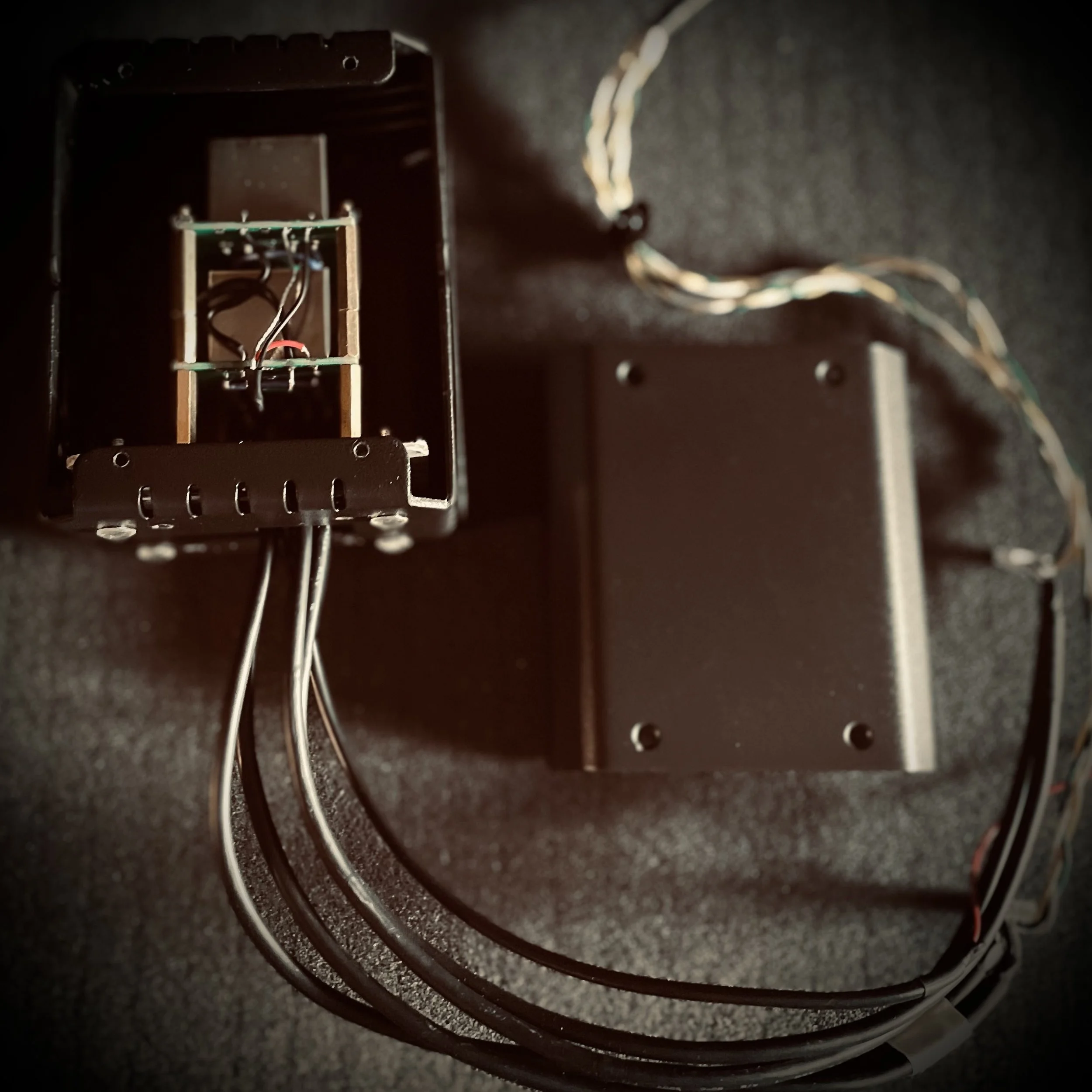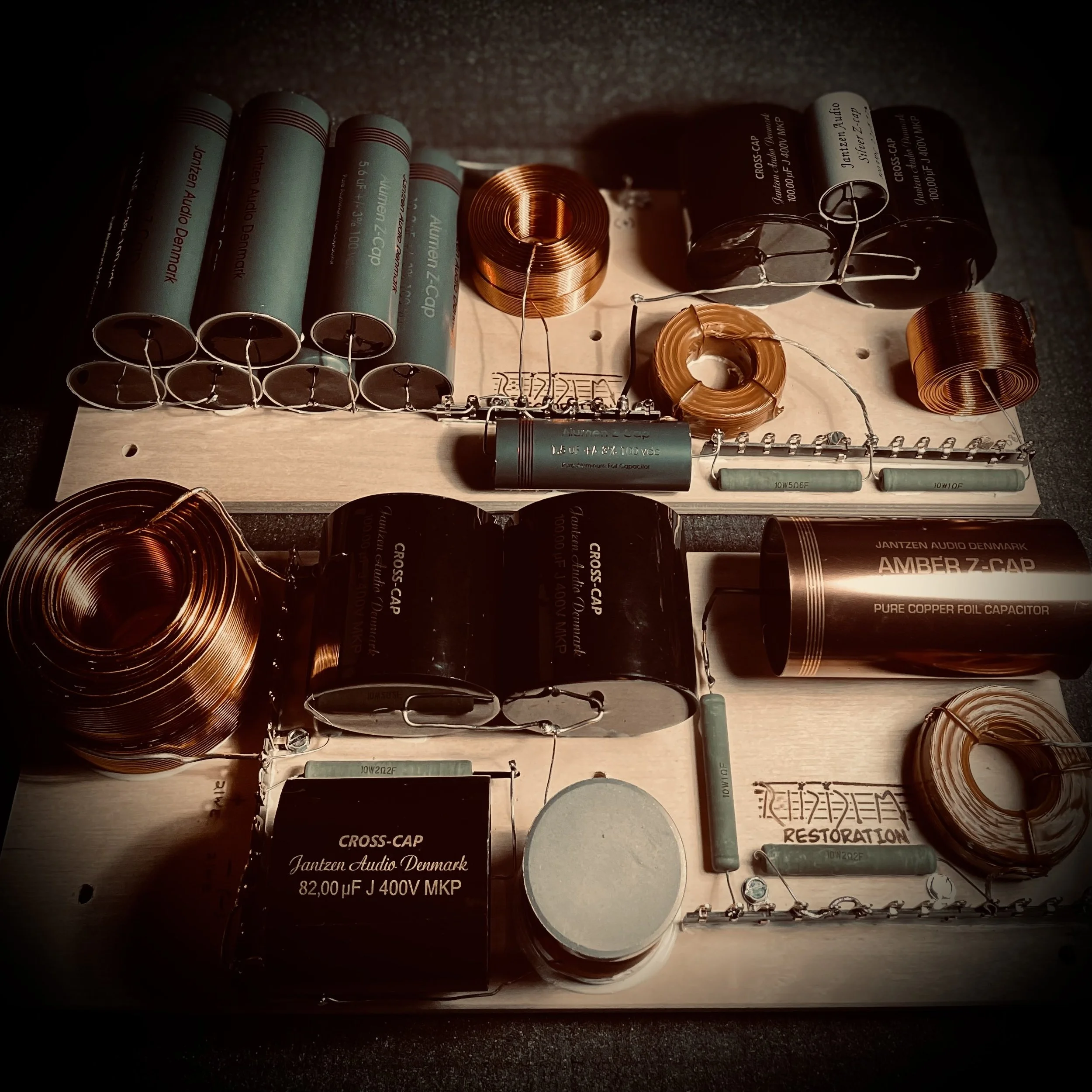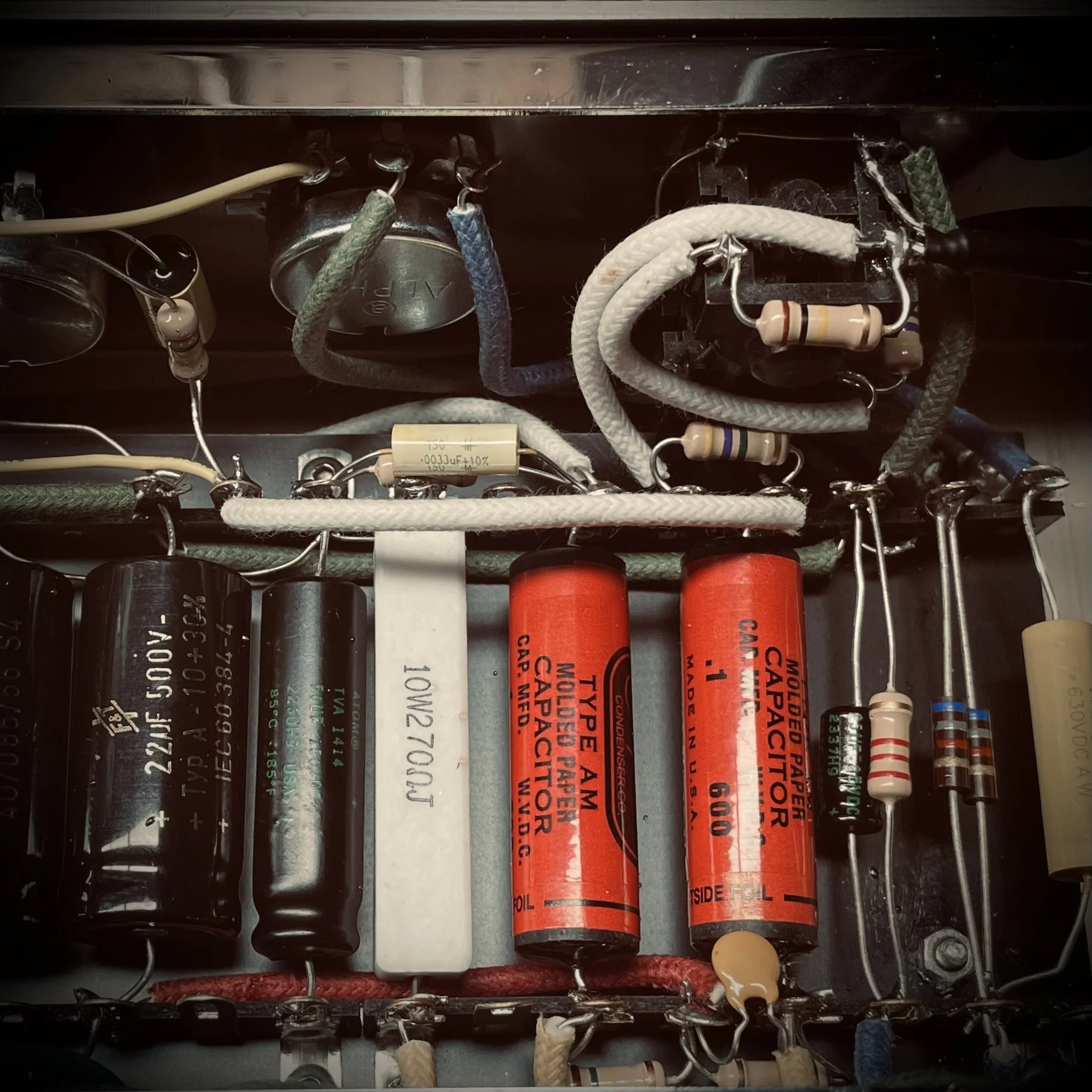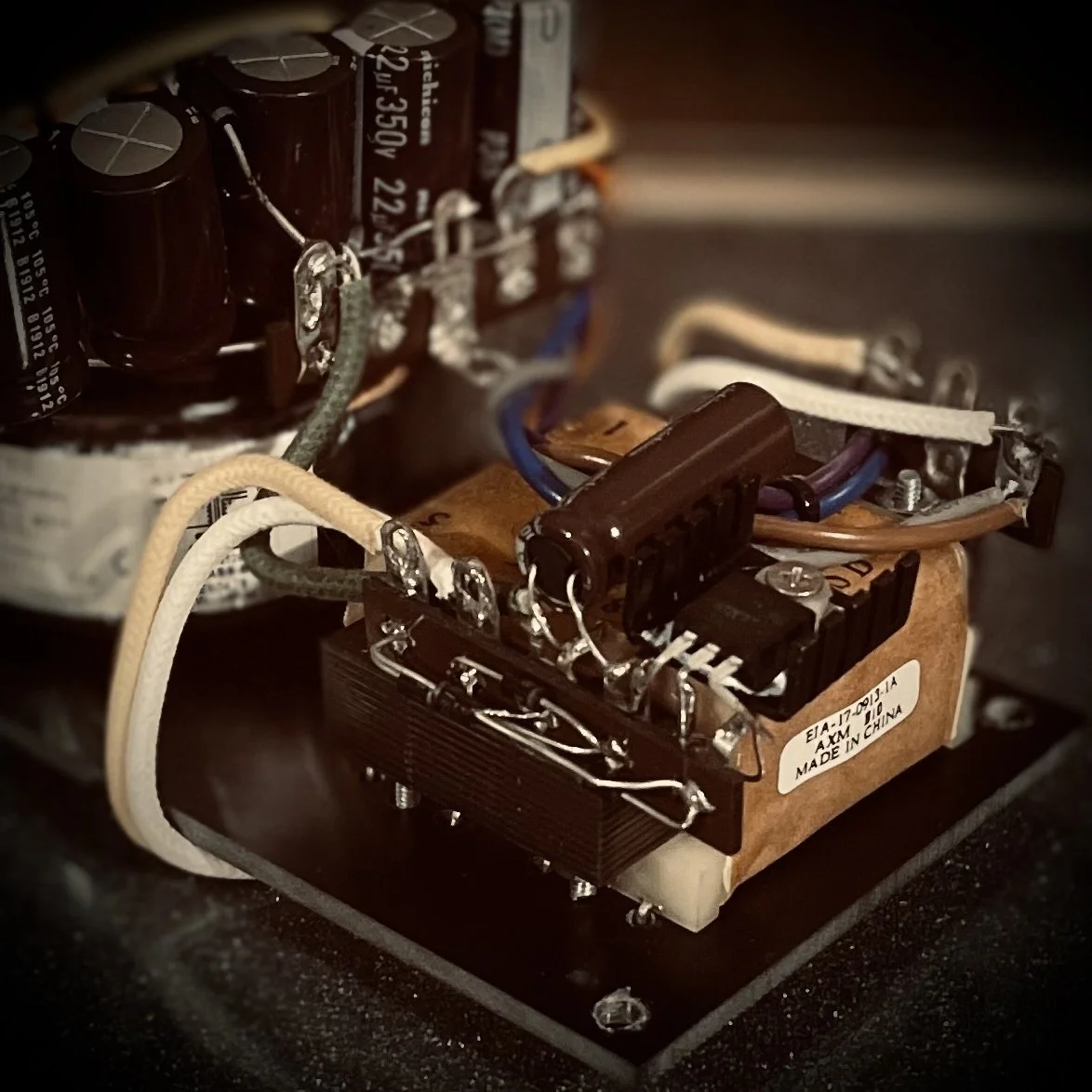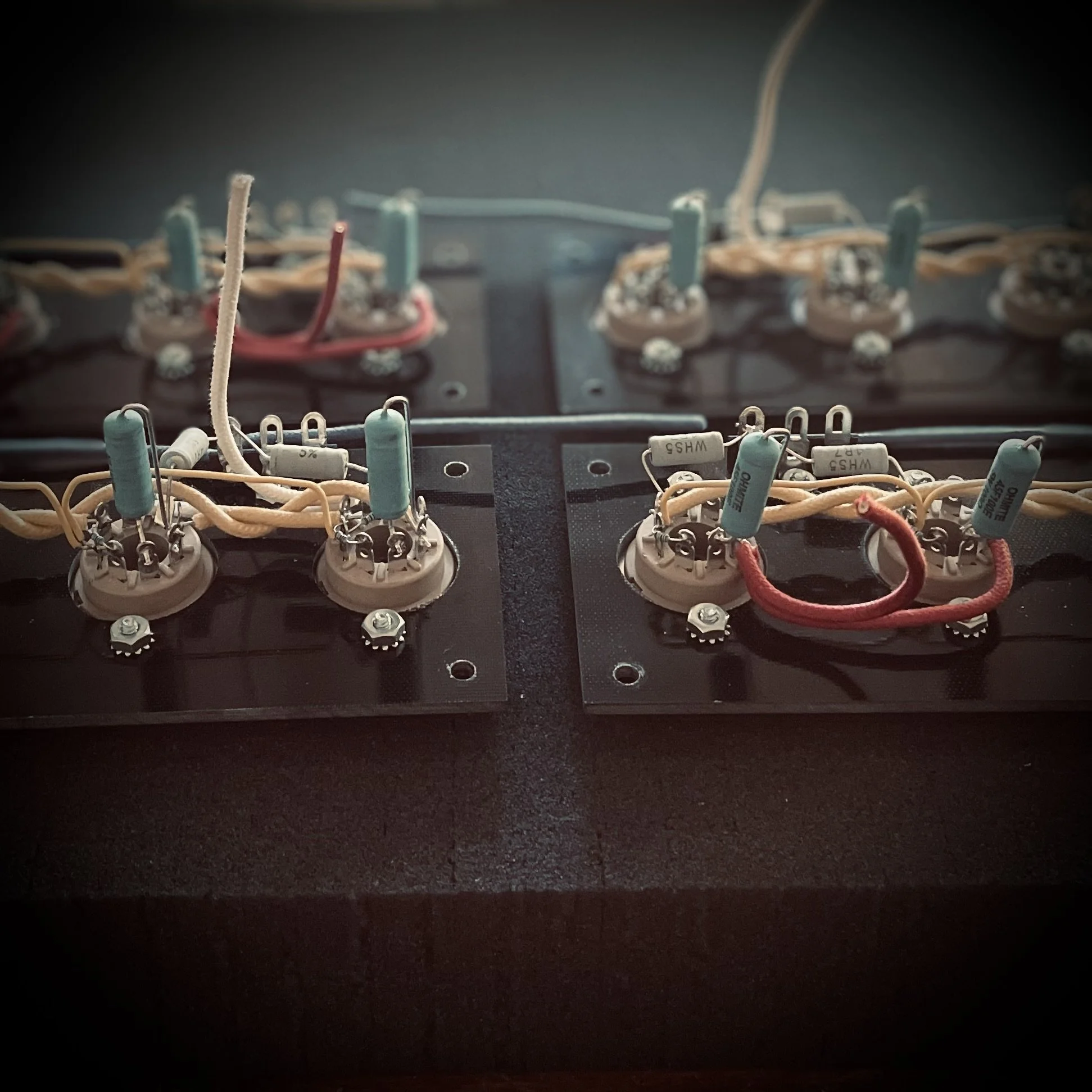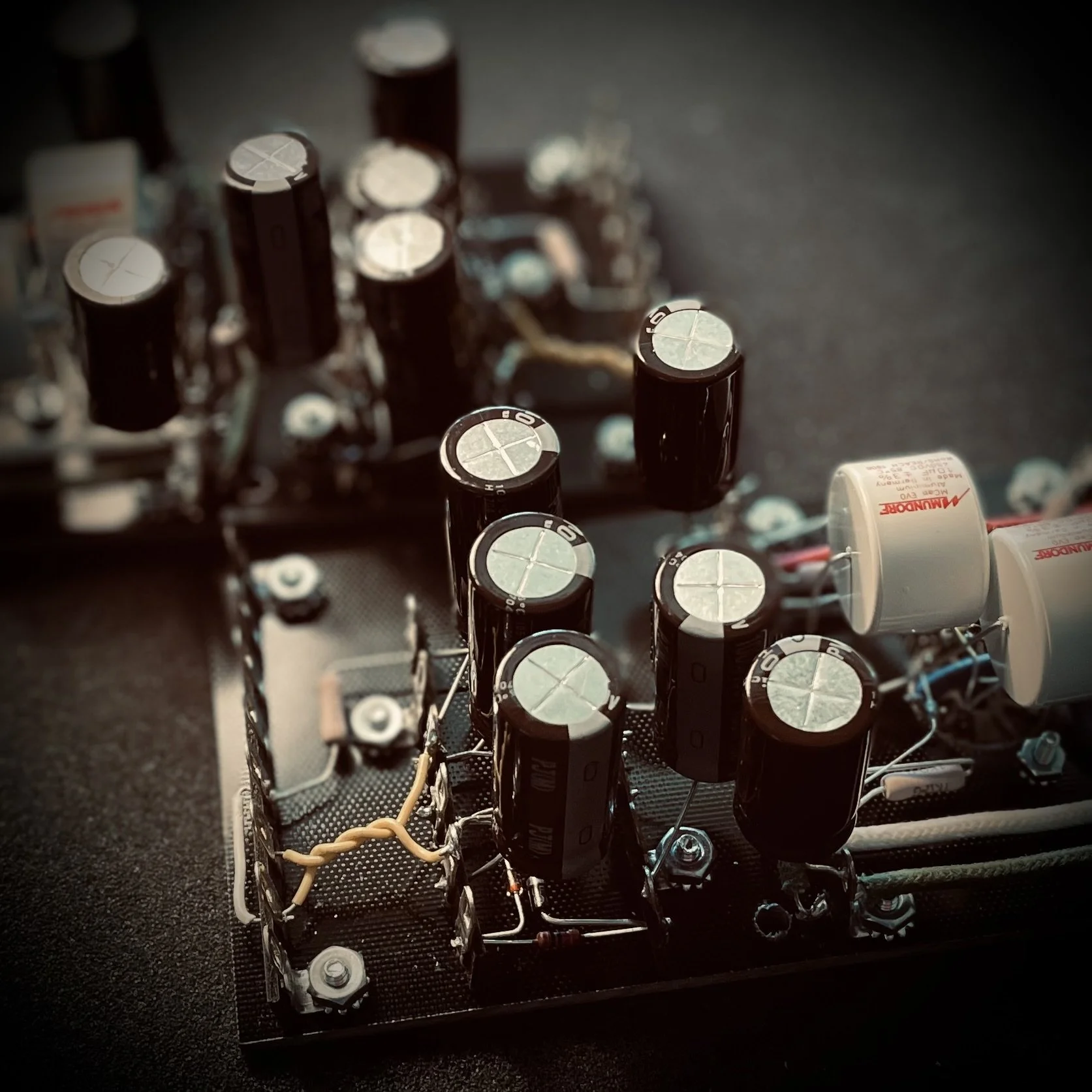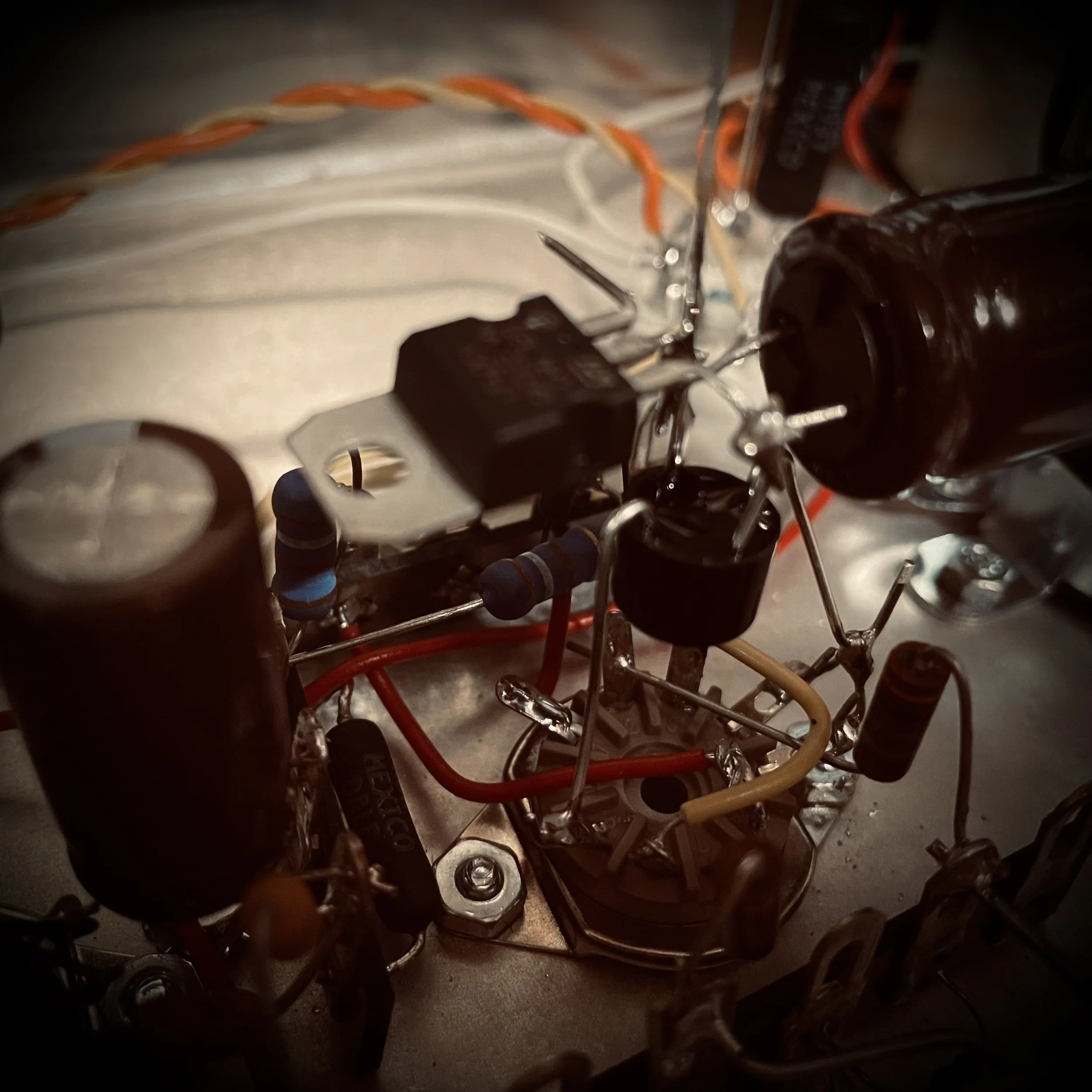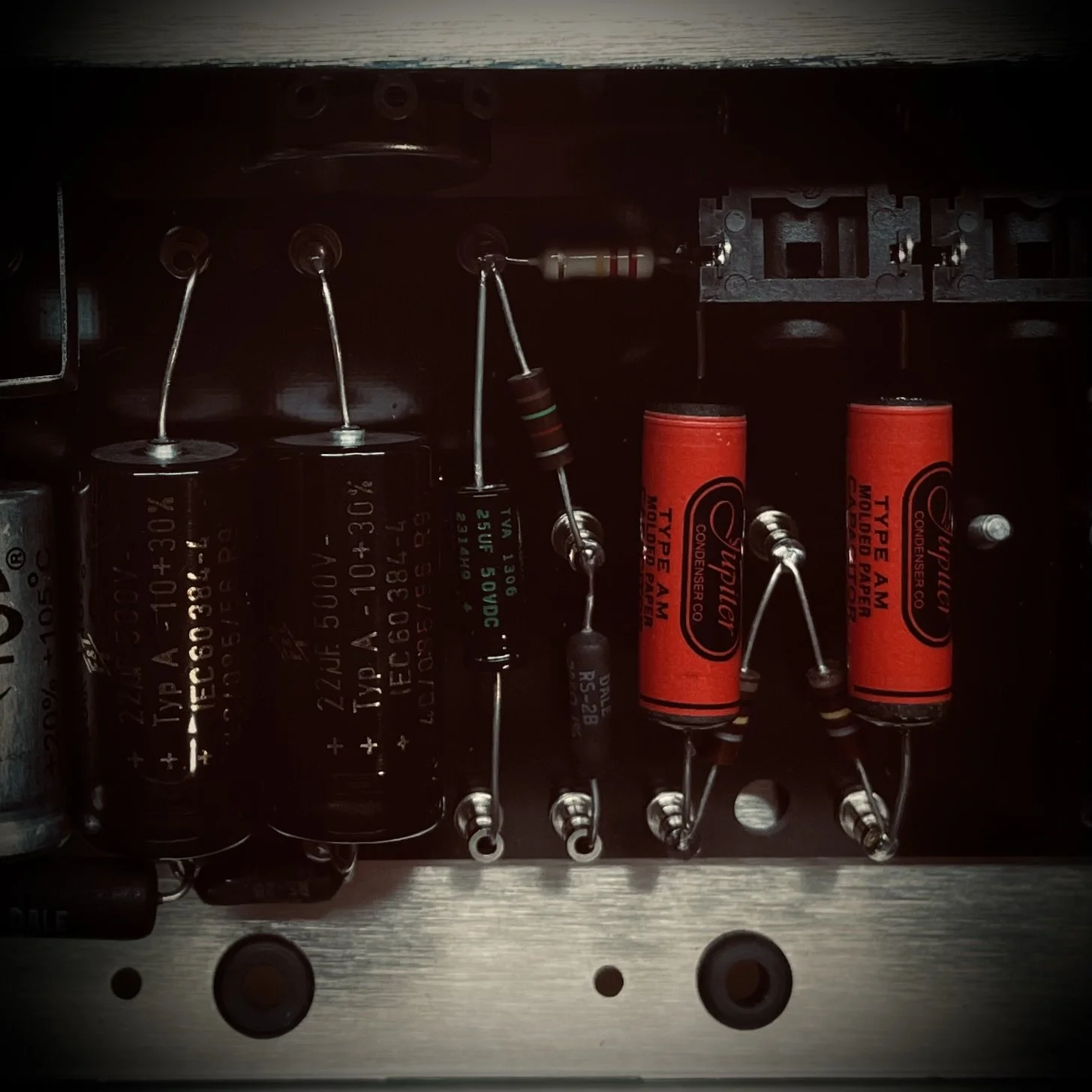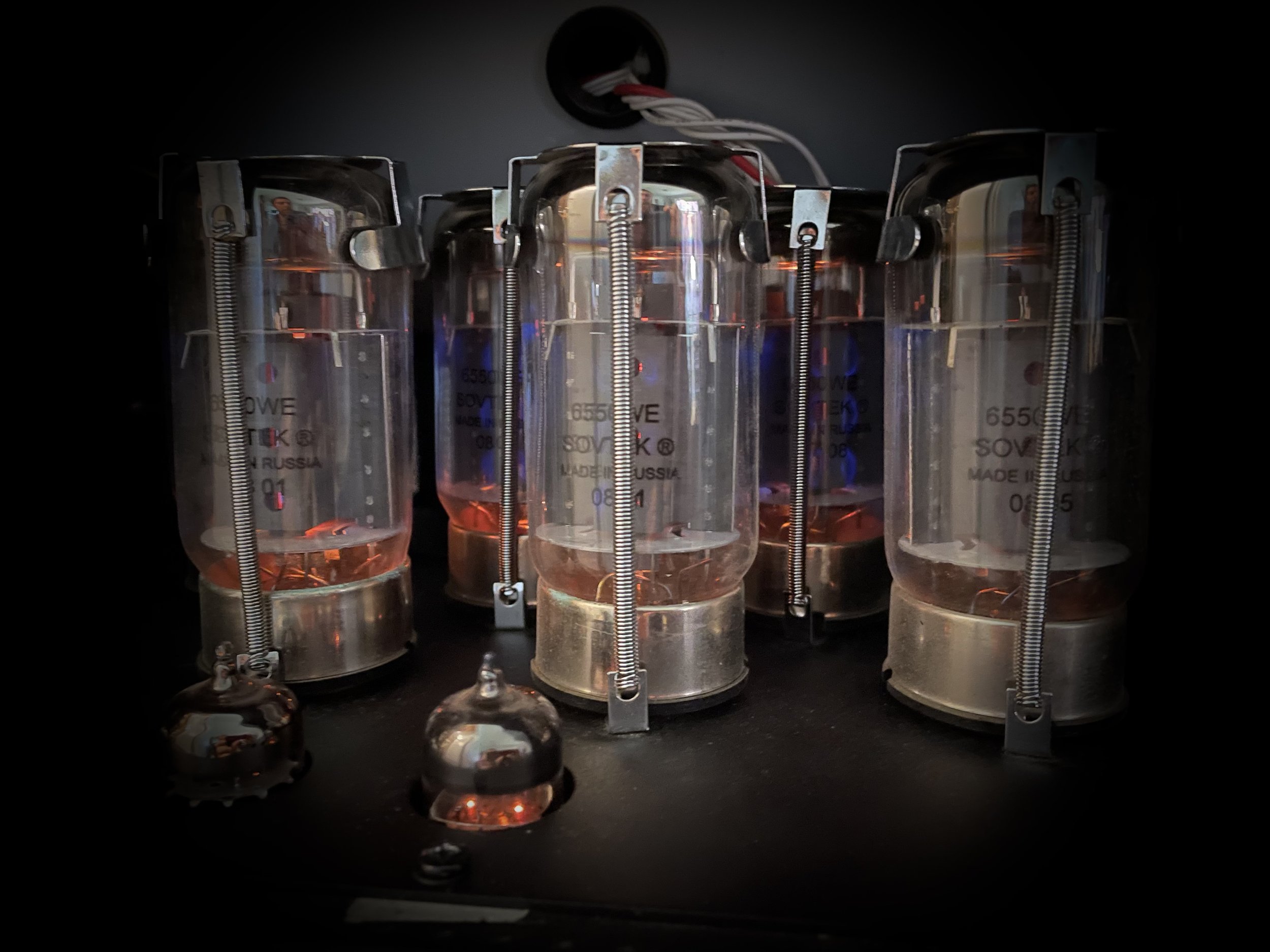
Crafted for Those Who Create
Every Amp has a Story. Every Story has Taught us Something.
Some of these amps came in broken, others just misunderstood. Each one had something to teach about tone, about circuitry, about maintenance, and about the way sound moves and breathes.
Restoring, rebuilding, and reimagining these amps shaped the way I build today. Every Riddim Restoration amplifier carries the lessons learned from countless circuits before it, redefined with intent to speak in it’s own voice for as long as you do.
Like a highly qualified and experienced engineer, I break things down to the simple mathematics. These are the amps that passed across my bench. They are all part of this musical journey.
Equation #1: Instrument Signal Amplifiers
-
![A vintage guitar amplifier with a black top, beige grille cloth, and a red and silver logo at the top center reading '65 AMPS'.]()
65amps Ventura
-
![Inside view of an electronic device showing various capacitors, resistors, wires, and circuit components mounted on a metallic surface.]()
65amps Ventura
-
![Guitar amplifier with multiple control knobs, a power switch, and a handle on top, placed on a wooden surface.]()
Friedman Small Box
-
![View of the interior of a vintage electronic audio amplifier showing various resistors, capacitors, circuit boards, wiring, and vacuum tube sockets inside a metal chassis.]()
Friedman Small Box
-
![The image shows a vintage music amplifier with a maroon fabric front and wooden frame. It has a metal plate on top labeled 'KENDRICK' and another metal plate at the bottom labeled 'DAGERM'.]()
Kendrick Texas Crude
-
![Interior view of a vintage guitar amplifier showing vacuum tubes, a speaker, and electronic components.]()
Kendrick Texas Crude
-
![Guitar amplifier with a torn speaker grill and control panel on top.]()
Music Man One Thirty Five
-
![Close-up of an electronic circuit board inside a vintage radio or amplifier, showing resistors, capacitors, and wiring.]()
Music Man One Thirty Five
-
![Vintage VOX guitar amplifier with a black textured top, handle, and metal corners, and a brown diamond-patterned grille cloth on the front.]()
VOX AC30HW
-
![Internal view of a vintage electronic circuit board with resistors, capacitors, and wiring.]()
VOX AC30HW
-
![A vintage Ampeg guitar amplifier head sitting on a worn wooden surface with a wooden background. It has various control knobs, switches, and input jacks.]()
Ampeg V-4
-
![Close-up of vintage electronic circuit with vacuum tubes, resistors, capacitors, and connectors.]()
Ampeg V-4
-
![A vintage black guitar amplifier with a silver grille, displaying a logo in the upper left corner, sitting on a patterned carpet in a room with a brick wall and various equipment in the background.]()
Ampeg VT40
-
![Close-up view of an electronic amplifier's interior showing vacuum tubes, and circuit boards with numerous wires connected.]()
Ampeg VT40
-
![A vintage Ampeg guitar amplifier head with a black textured exterior, silver control panel, and a large Ampeg logo on the front grille. The control panel features knobs for volume, treble, midrange, bass, and other settings, along with input jacks, standby and power switches.]()
Ampeg SVT
-
![Close-up of a vintage tube amplifier with glowing vacuum tubes and control knobs.]()
Ampeg SVT
-
![Back of a vintage speaker with a beige fabric top, brown patterned fabric front, and a wooden handle on top.]()
Peavey Vintage 212
-
![Inside view of an electronic device, showing a circuit board with various resistors, capacitors, and wires.]()
Peavey Vintage 212
-
![A vintage Milkman Sound guitar amplifier with beige textured exterior, black and silver control panel, and a woven fabric speaker grille.]()
Milkman Sound 1/2 Pint
-
![Close-up of a vintage Jupiter speaker with a metal label that reads Jupiter permanent magnet speaker, made by Jupiter Condenser Co. Hand assembled in the U.S.A.]()
Milkman Sound 1/2 Pint
-
![A red VOX guitar amplifier with a diamond-patterned speaker grille and gold accents.]()
VOX AC15
-
![Close-up of an electronic circuit board with various capacitors, resistors, connectors, and wires.]()
VOX AC15
-
![Vintage Fender guitar amplifier with beige textured covering and brown woven grille cloth, labeled 'Fender Champ' on a metal plate at the top front.]()
Fender Champ
-
![Inside view of a vintage tube amplifier showing electronic components like vacuum tubes, capacitors, wires, and circuit boards.]()
Fender Champ
-
![Fender Deluxe Reverb Amp, vintage style, beige speaker grille, control panel at the top with various knobs and input jacks.]()
Fender Deluxe Reverb - Limited
-
![Close-up of a Fender guitar amplifier with a textured beige surface, a black badge with red 'Fender' logo, and a speaker below labeled 'Cannabis'.]()
Fender Deluxe Reverb - Limited
-
![A Fender Vibro King guitar amplifier with a black top panel, control knobs including volume, treble, bass, mid, speed, and intensity, and a silver grille cloth with a Fender logo.]()
Fender Vibro-King
-
![Interior of an electronic device with multicolored wires, circuit boards, and electronic components.]()
Fender Vibro-King
-
![A Fender Twin Reverb guitar amplifier with a black control panel and a beige textured grille cloth, displaying various knobs and switches.]()
Fender Twin Reverb
-
![Inner components of an electronic device with numerous wires, resistors, capacitors, and other electronic parts visible inside a metal casing.]()
Fender Twin Reverb
-
![A vintage Fender Deluxe guitar amplifier with a fabric covering and a woven grille cloth, placed on a wooden stand in a workshop. In the background, there is a pegboard wall with some electronic testing equipment.]()
Fender Custom Deluxe
-
![Inside view of an electric guitar amplifier showing wires, capacitors, and vacuum tubes.]()
Fender Custom Deluxe
-
![A vintage Fender guitar amplifier with a yellow and brown woven grille and a leather handle on top.]()
Fender Blues Jr
-
![Close-up view of an electronic circuit board with various capacitors, resistors, wires, and electronic components.]()
Fender Blues Jr.
-
![A vintage Fender DeVille guitar amplifier with a black exterior, metal corner protectors, and a silver grille cloth, sitting on a wooden table in front of a window.]()
Fender Deville
-
![Interior view of a vintage electric guitar amplifier showing a circuit board, vacuum tubes, and speaker.]()
Fender Deville
-
![Vintage Fender Princeton guitar amplifier with control knobs, input jacks, and a beige grille cloth, sitting on a wooden surface in a workshop.]()
Fender Princeton
-
![Inside view of an electronic device showing circuit boards, wires, resistors, capacitors, and other electronic components.]()
Fender Princeton
-
![Gold-colored Bass effects pedal with multiple control knobs and switches, including labeled GAIN 1, GAIN 2, PHANTOM, MIX, MASTER, LINE OUT, and VOLUME, placed on a wooden surface with paint marks.]()
MarkBass Little Mark Tube
-
![Interior of a digital or electronic device with various circuit boards, capacitors, resistors, a heat sink, and wiring.]()
MarkBass Little Mark Tube
-
![Marshall DSL 40C guitar amplifier with black textured covering, gold control panel, and white Marshall logo on front grille.]()
Marshall DSL 40C
-
![Inside view of an electronic device with green circuit boards, colorful wires, and various electronic components.]()
Marshall DSL 40C
-
![A Marshall guitar amplifier with control knobs on the top panel and a fabric grille with the Marshall logo in the center.]()
Marshall JCM
-
![Internal view of an electronic device showing a green circuit board with various resistors, capacitors, and wires connected to other components.]()
Marshall JCM
-
![Audio signal processing device with control knobs for input level, midrange frequency, midrange equalization, treble equalization, direct level, and reverb level on a wooden surface.]()
Furman RV-1
-
![A close-up of an electronic circuit board with various components, resistors, capacitors, and switches, mounted inside a chassis with a metal support structure.]()
Furman RV-1
-
![A professional audio preamp unit with various knobs and controls, placed on a wooden surface.]()
Furman PQ-3
-
![Inside view of an electronic circuit board with resistors, capacitors, wires, and other electronic components.]()
Furman PQ-3
-
![Guitar amplifier with a wooden frame, black grille cloth, and control knobs labeled volume, treble, bass, mid/boost. Brand is Mesa Engineering, King Snake model. Settings include power switch, standby switch, and indicator lights.]()
Mesa King Snake
-
![Interior view of an electronic device showing green circuit boards with various capacitors, resistors, wiring, and cooling components inside a metal casing.]()
Mesa King Snake
-
![A Peavey KB 5 bass amplifier speaker cabinet with a black metal grille, positioned on a wooden floor with casters.]()
Peavey KB5
-
![The interior of an electronic device showing a circuit board with various components, including resistors, capacitors, and wires.]()
Peavey KB5
-
![A black rectangular Roland amplifier with a textured front grille and a silver Roland logo, placed on a shelf in a room with various electronic equipment and power outlets in the background.]()
Roland AC 60
-
![Close-up of a computer motherboard with various capacitors, chips, and wires.]()
Roland AC 60
-
![A vintage Roland Jazz Chorus 120 guitar amplifier with control knobs on top, a grill cloth front, and side handles, placed on a hardwood floor in a room with furniture and storage in the background.]()
Roland JC120
-
![Close-up of the internal electronic circuit board with various capacitors, resistors, wires, and electronic components.]()
Roland JC120
-
![A black speaker with a large circular grille and white stripes, labeled 'Supro,' on a wooden surface in a workshop.]()
Supro Delta King
-
![Inside view of an audio device with a green circuit board, various colored wires, capacitors, resistors, and other electronic components.]()
Supro Delta King
-
![Front view of a vintage Eden The Traveler hybrid bass guitar amplifier with various control knobs and switches on the beige front panel.]()
Eden WT300
-
![Close-up view of electronic circuit boards with capacitors, resistors, wires, and other components.]()
Eden WT300
-
![]()
PG Workshop JCM 800
-
![Internal view of an electronic circuit board with various capacitors, resistors, wires, and other electronic components mounted on a metal chassis.]()
PG Workshop JCM 800
-
![Guitar amplifier head on a wooden table with dust and smudges.]()
Laney Pro-Tube 100
-
![The interior of a vintage Laney Pro-Tube 100 guitar amplifier showing vacuum tubes, control knobs, switches, and labels on the front panel.]()
Laney Pro-Tube 100
-
![Carolina guitar amplifier with a black control panel, silver knobs, and a woven grille with Carolina logo, black handle on top, and power switch on the right side.]()
Carol Ann Silk
-
![Inside view of an electronic device, showing a blue circuit board with orange capacitors, resistors, and various wires connected to it.]()
Carol Ann Silk
-
![A vintage Gibson guitar amplifier with a woven fabric speaker grille and a black Gibson logo on the front.]()
Gibson Maestro
-
![Inside an electrical device, with exposed wires, resistors, capacitors, and relays.]()
Gibson Maestro
-
![An electric guitar amplifier with a yellow textured covering and a woven grille cloth. There is a logo on the top center of the amp that says 'VHT FORHA'.]()
Victoria Ivy League
-
![Interior of a vintage guitar amplifier showing vacuum tubes, capacitors, resistors, wiring, and a large speaker labeled Virginia, the brand Legend, inside a wooden cabinet.]()
Victoria Ivy League
-
![An old, worn Gibson speaker cabinet with two circular speaker openings covered in brown grille cloth, resting on a woven stool.]()
Gibson GA-25
-
![Inside view of an electronic device chassis showing wires, resistors, capacitors, and a potentiometer.]()
Gibson GA-25
-
![Vintage tube amplifier with vacuum tubes, black transformers, and controls on a wooden enclosure labeled 'Emery Sound'.]()
Emory Sound StageBaby
-
![Inside view of an electronic device showing various circuit components, wires, resistors, capacitors, and a green circuit board.]()
Emory Sound StageBaby
+ High-Fidelity Reproduction Amplifiers = ???
-
![Inside view of an electronic device, showing circuit boards, wiring, and components.]()
Marantz
-
![A circuit board with various electronic components including resistors, capacitors, and wires.]()
Marantz
-
![Vintage Marantz stereo amplifier with a wooden case, silver front panel, and multiple knobs and controls, placed on a wooden table.]()
Marantz
-
![Close-up of a vintage Dynaco stereo tube amplifier with glowing vacuum tubes in operation, set against a dark background.]()
Dynaco
-
![Close-up of a blue circuit board with various electronic components including capacitors, resistors, relays, and wiring.]()
Dynaco
-
![A close-up of a vintage speaker with two smaller speakers above it, wires connected between them, and a dark background.]()
Zenith
-
![Close-up of the internal electronic components of a vintage device, including wiring, metallic plates, and dials.]()
Zenith
-
![Mid-century wooden sideboard with sliding doors, located against a plain wall on a wood floor.]()
Zenith
-
![Vintage stereo amplifier on a wooden speaker cabinet]()
Sansui
-
![Inside view of an electronic device showing various wires, resistors, capacitors, and circuit components.]()
Sansui
-
![Vintage stereo receiver with wooden top and metal control panel, located on a wooden surface with tools and electronic equipment hanging on a pegboard in the background.]()
Luxman
-
![Inside view of an electronic device with various wires, circuit boards, and metallic components.]()
Luxman
-
![Audio amplifier on wooden workbench with test equipment and tools in background.]()
Rega
-
![Inside view of an electronic circuit board with wiring, capacitors, relays, and other electronic components.]()
Rega
-
![Vintage Kenwood stereo receiver Model KR-9400 on a wooden table, with a living room in the background.]()
Kenwood
-
![Close-up of an electronic circuit board with various resistors, capacitors, and other components mounted on it.]()
Kenwood
The Result: The Baddest Circuits on the Planet
Case files for each piece of equipment, documenting repairs, redlined schematics, noted modifications with pictures, and performance charts.
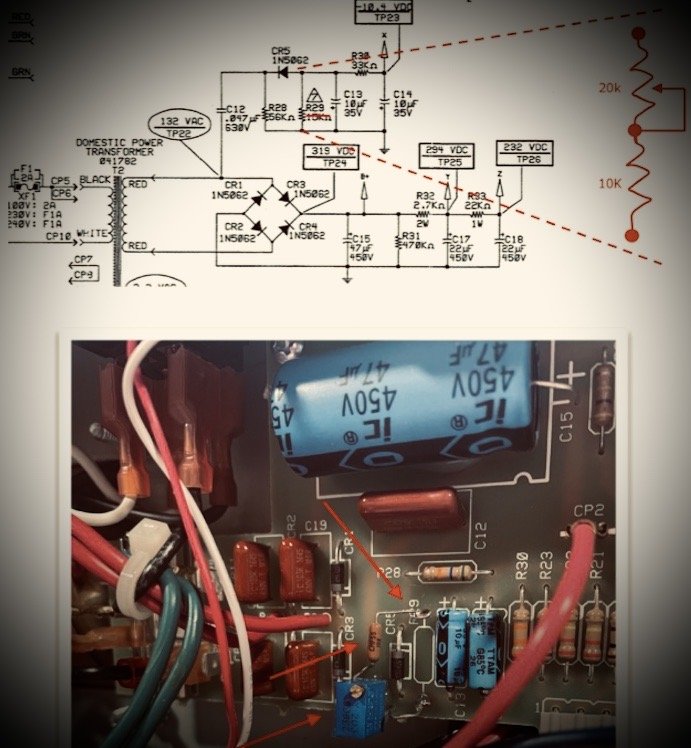
We checked the work…it adds up

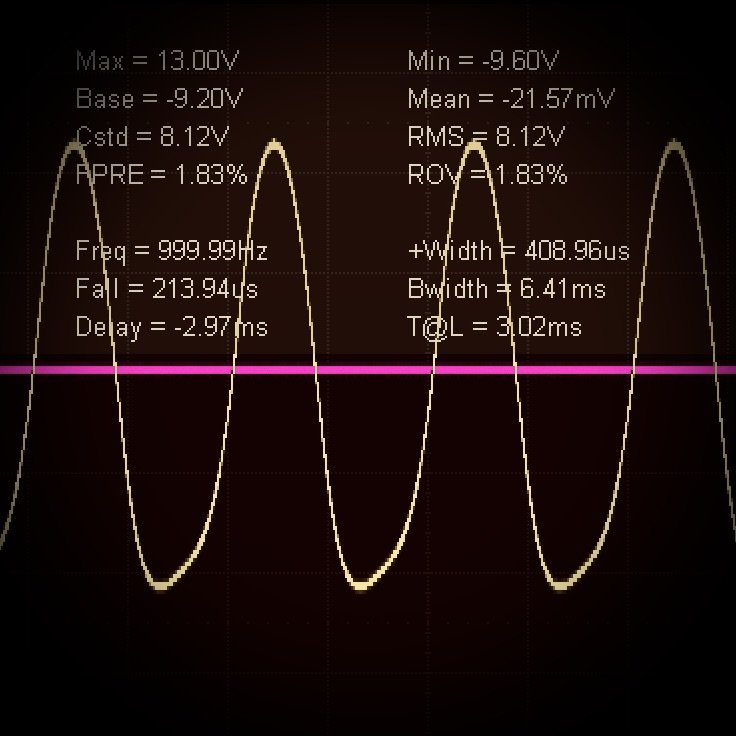
We don’t just build amplifiers; we craft instruments of sonic articulation—tools that shape the voices of those who push music forward. Every circuit, every component, every design choice is made with absolute intention—because in the right hands, sound isn’t just heard, it’s experienced.
This work isn’t about nostalgia or imitation. It’s about honoring the past while designing for the future. It’s about creating something truly alive—an amplifier that responds to the player, resonates with the listener, and stands the test of time.

Mission Critical
